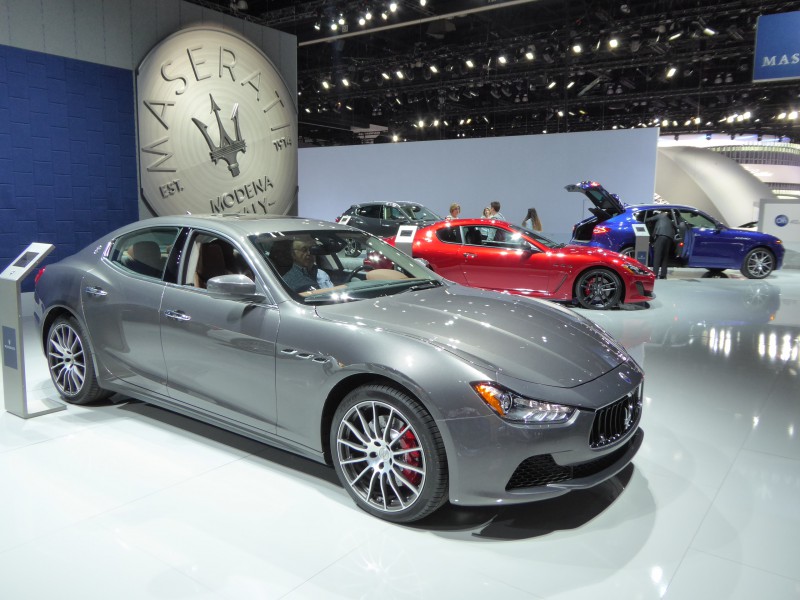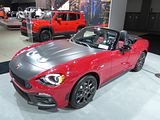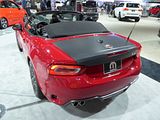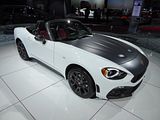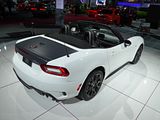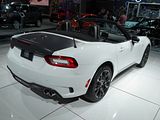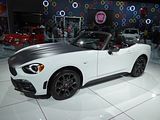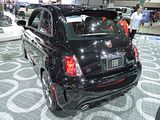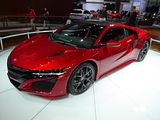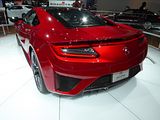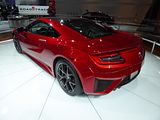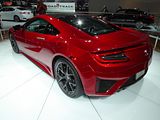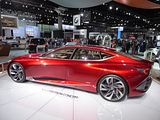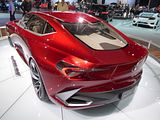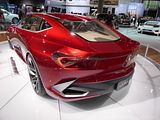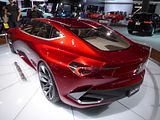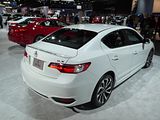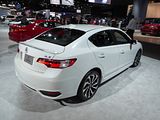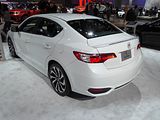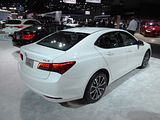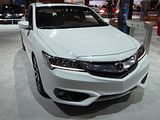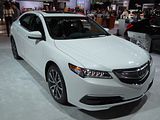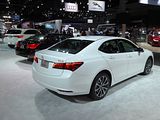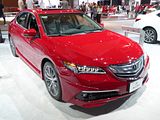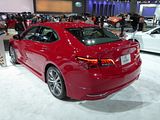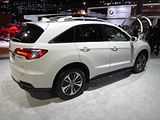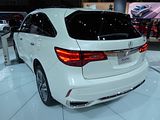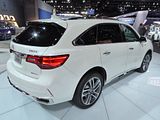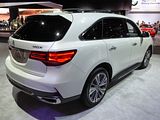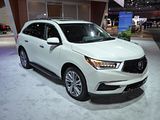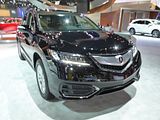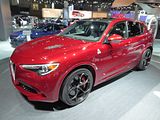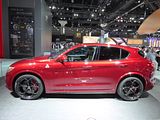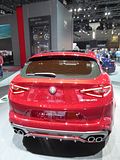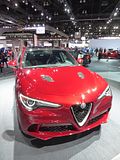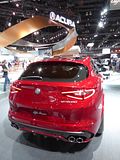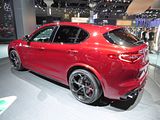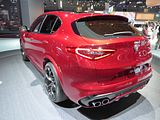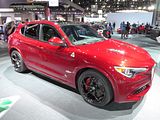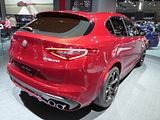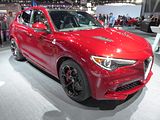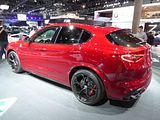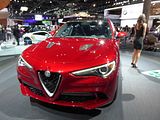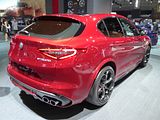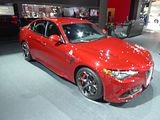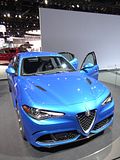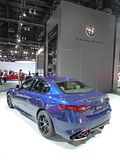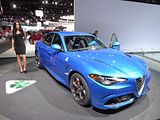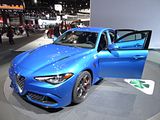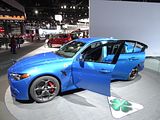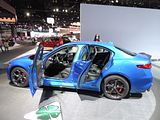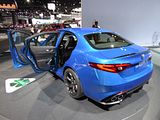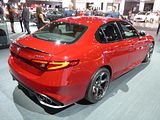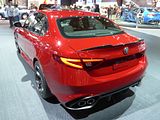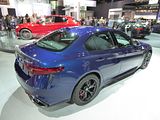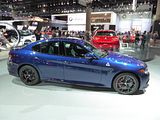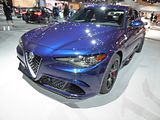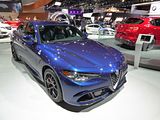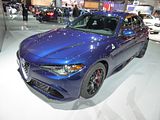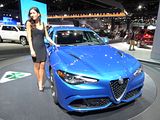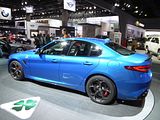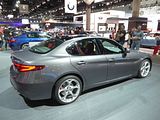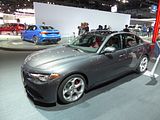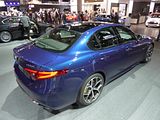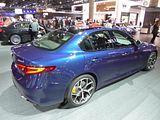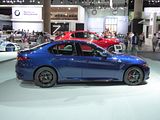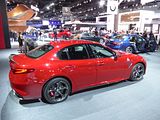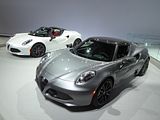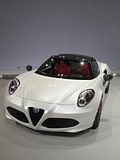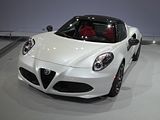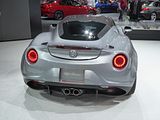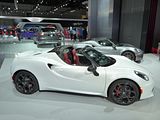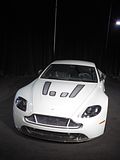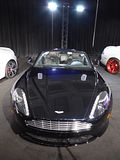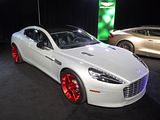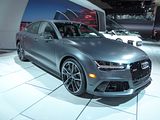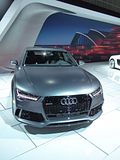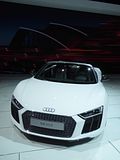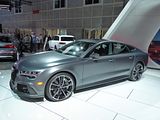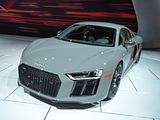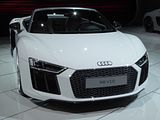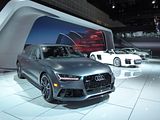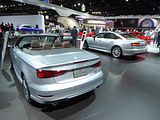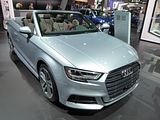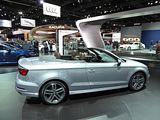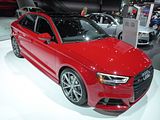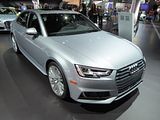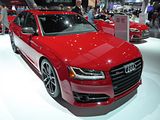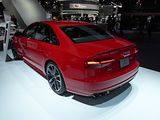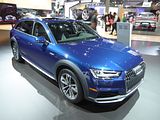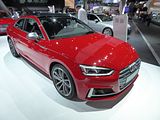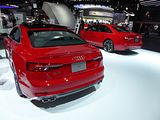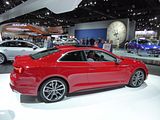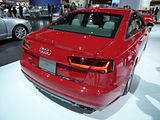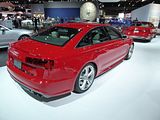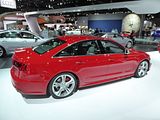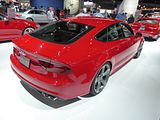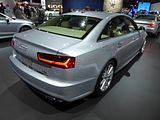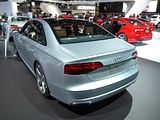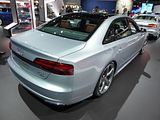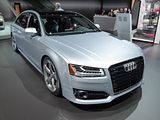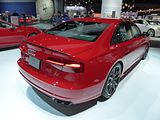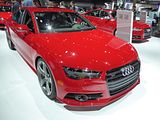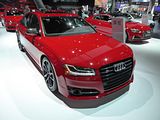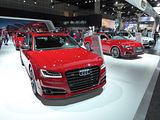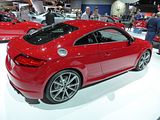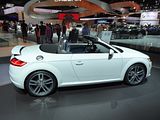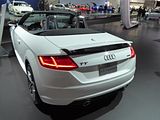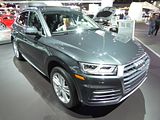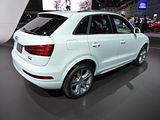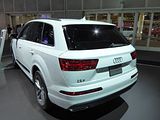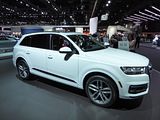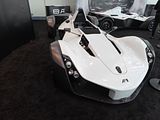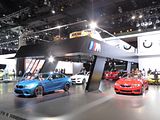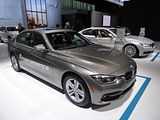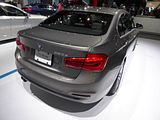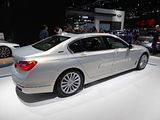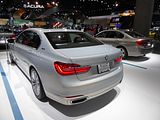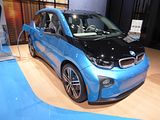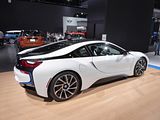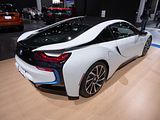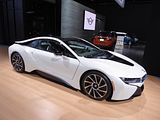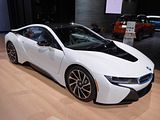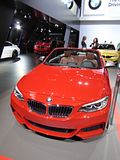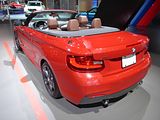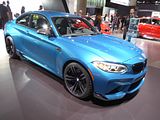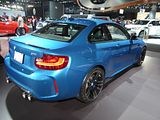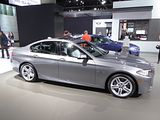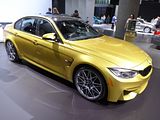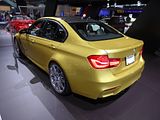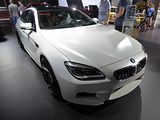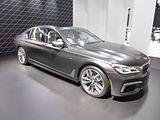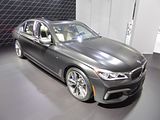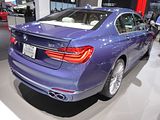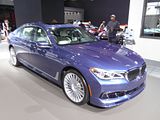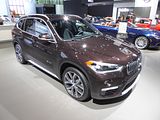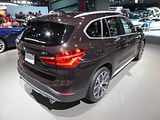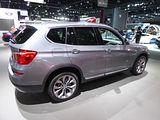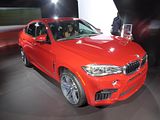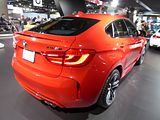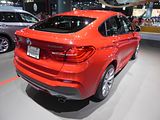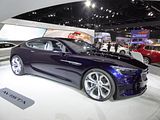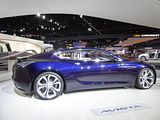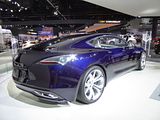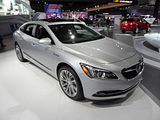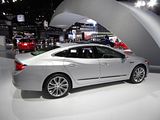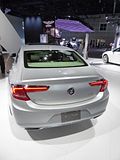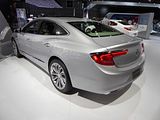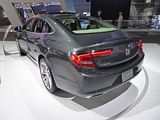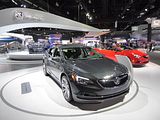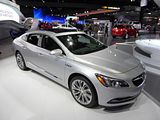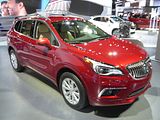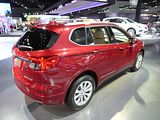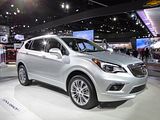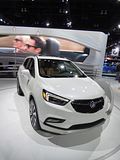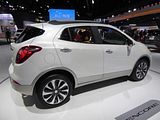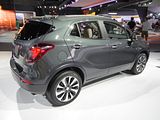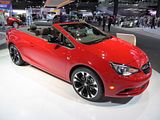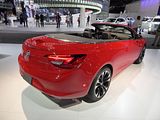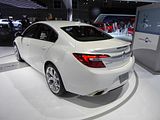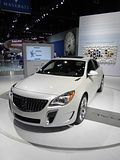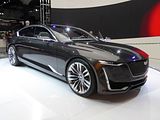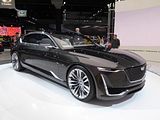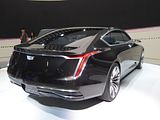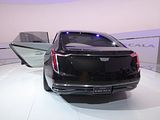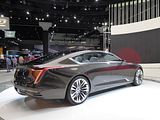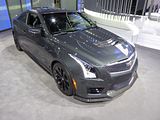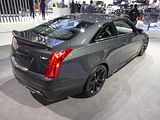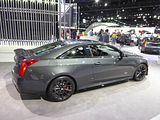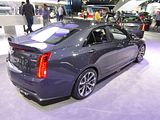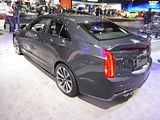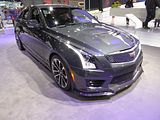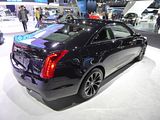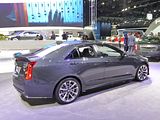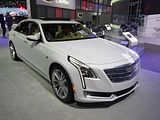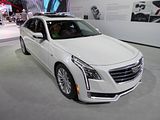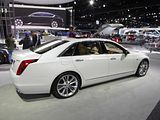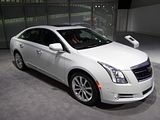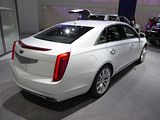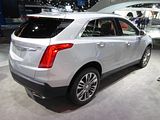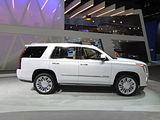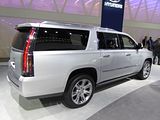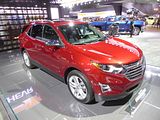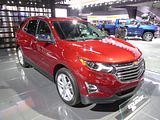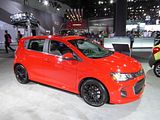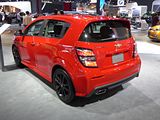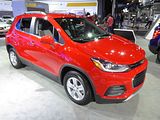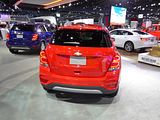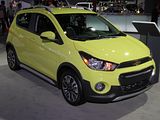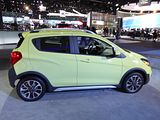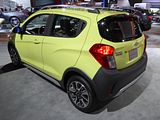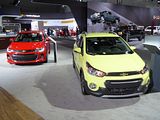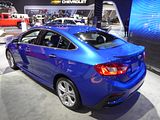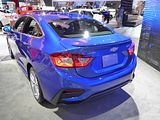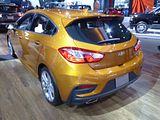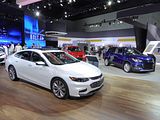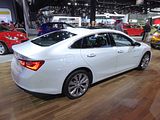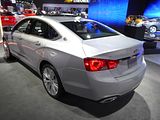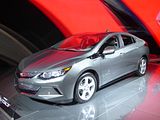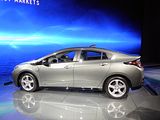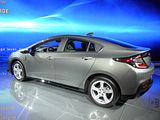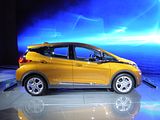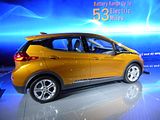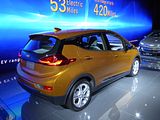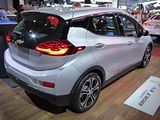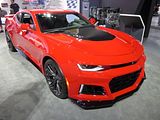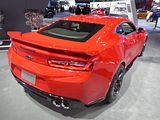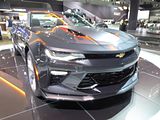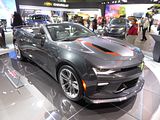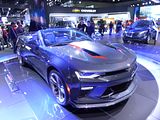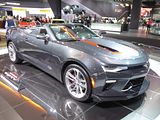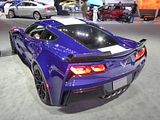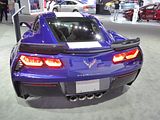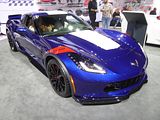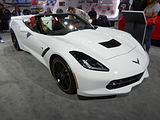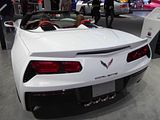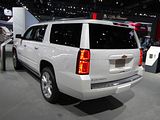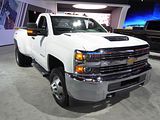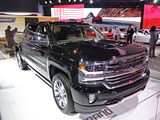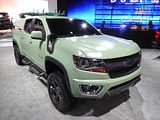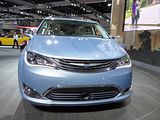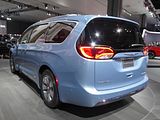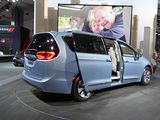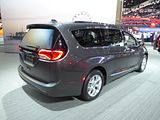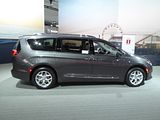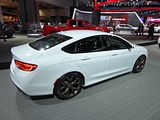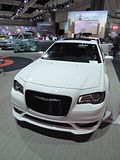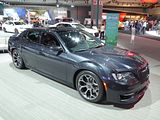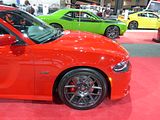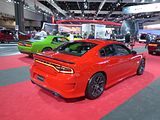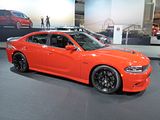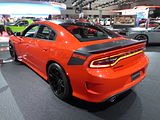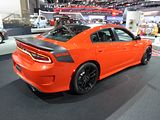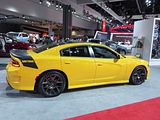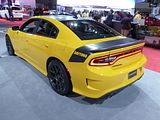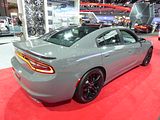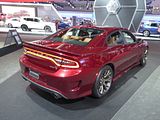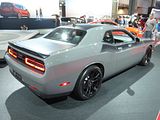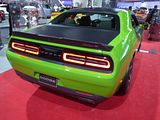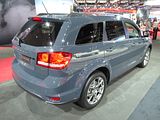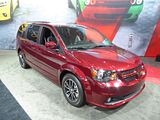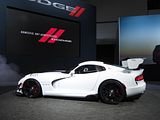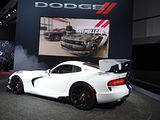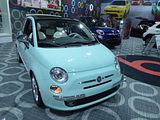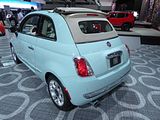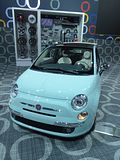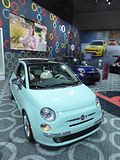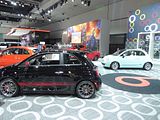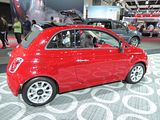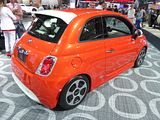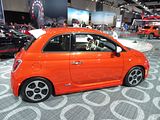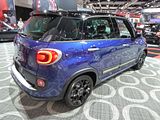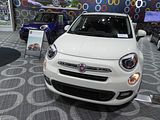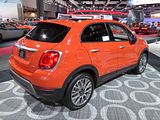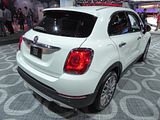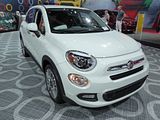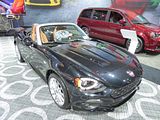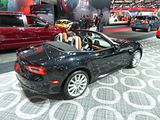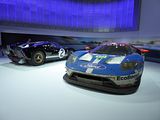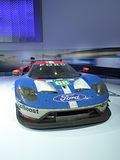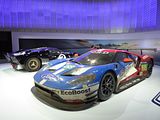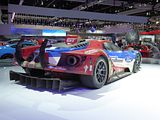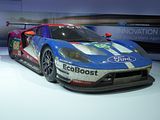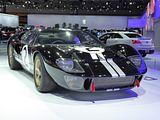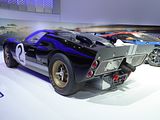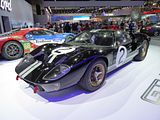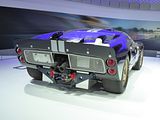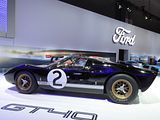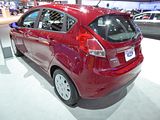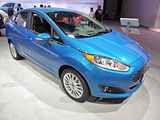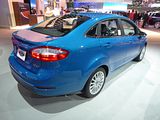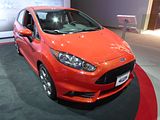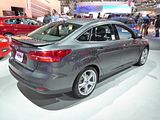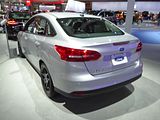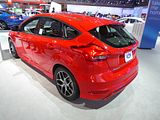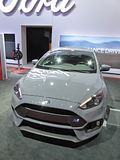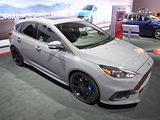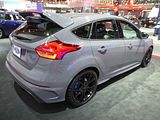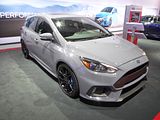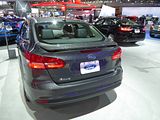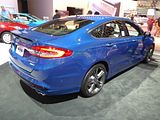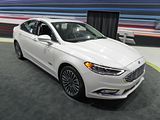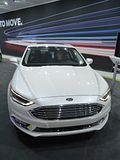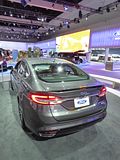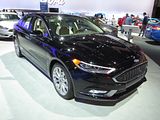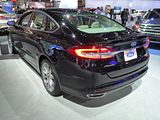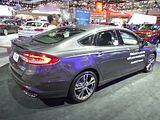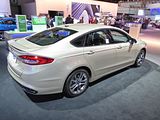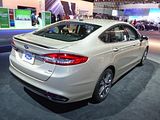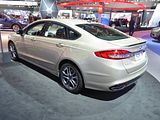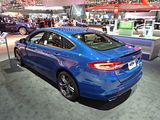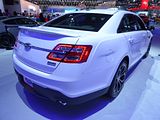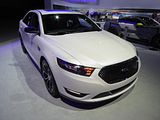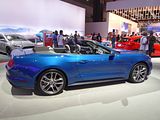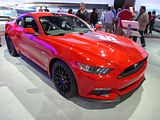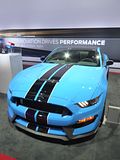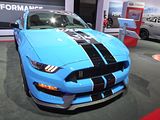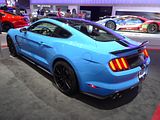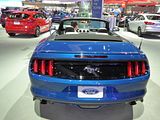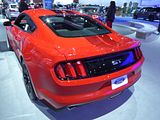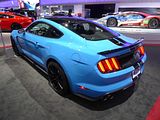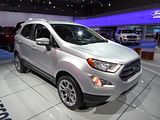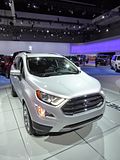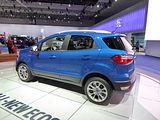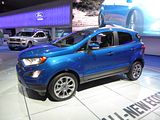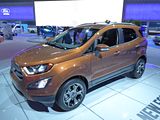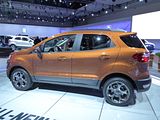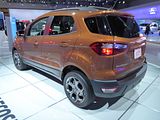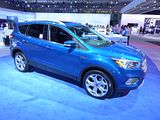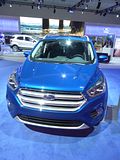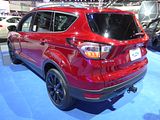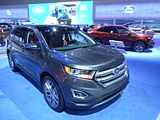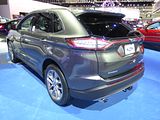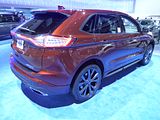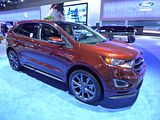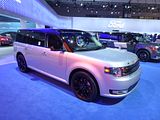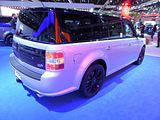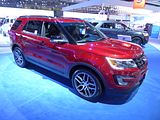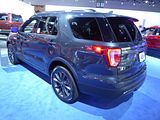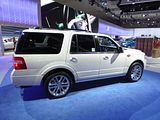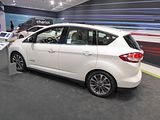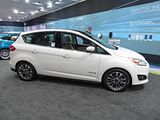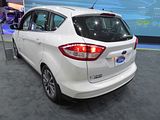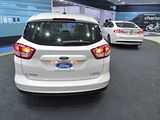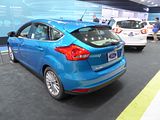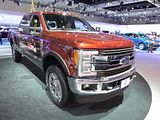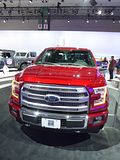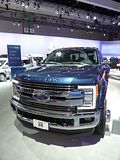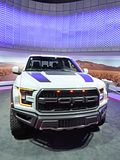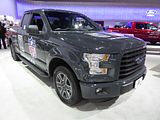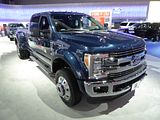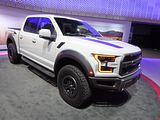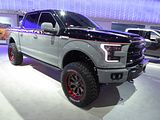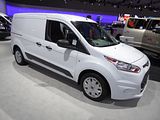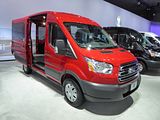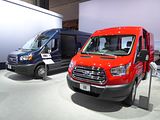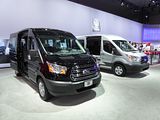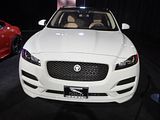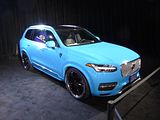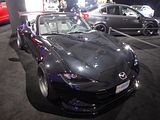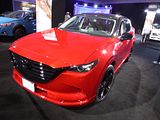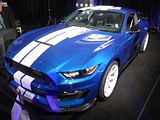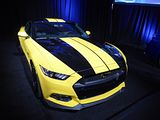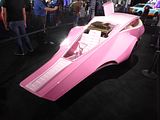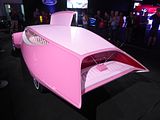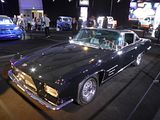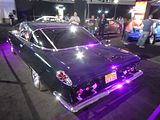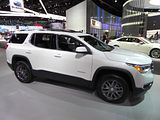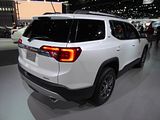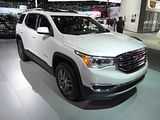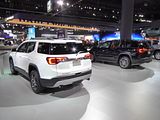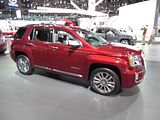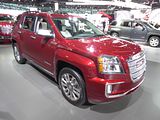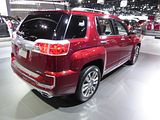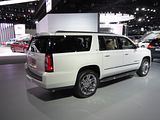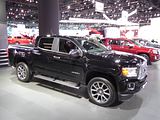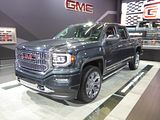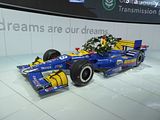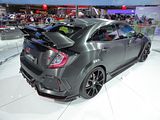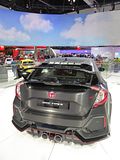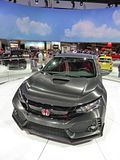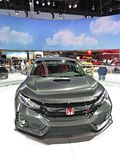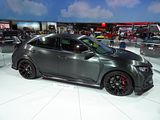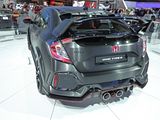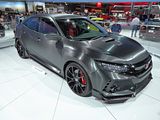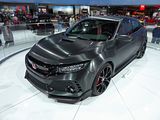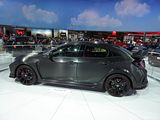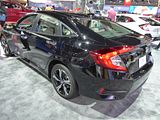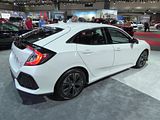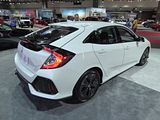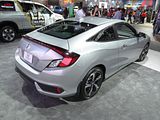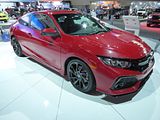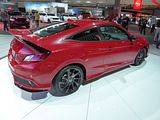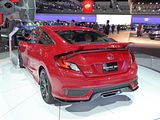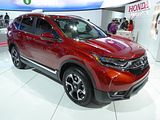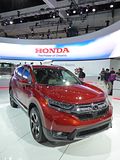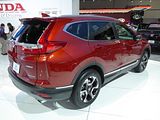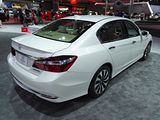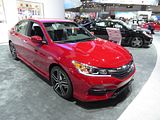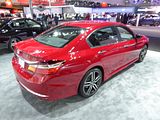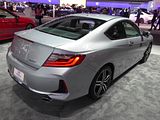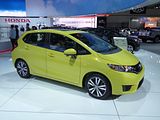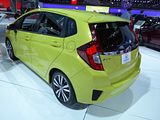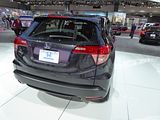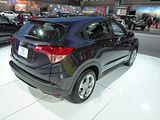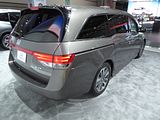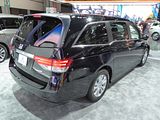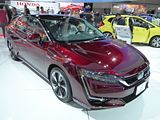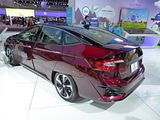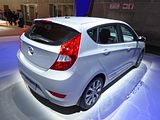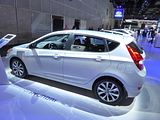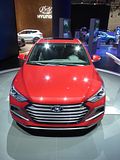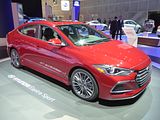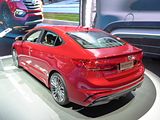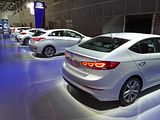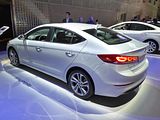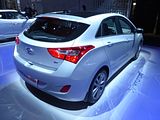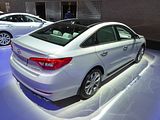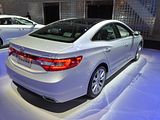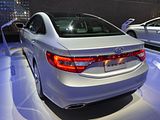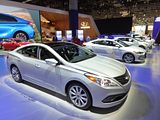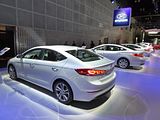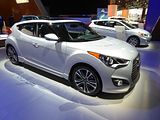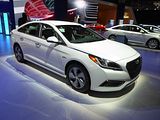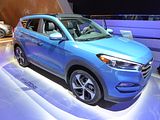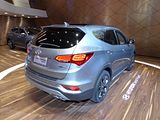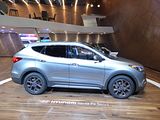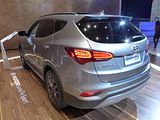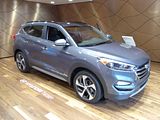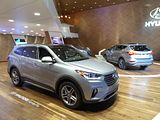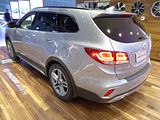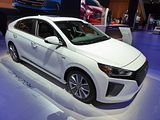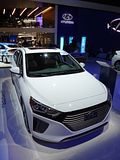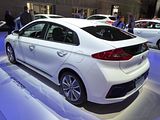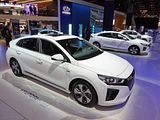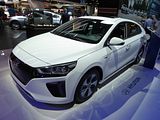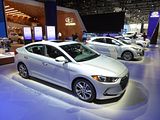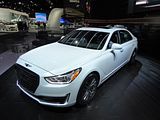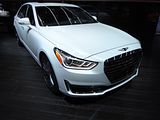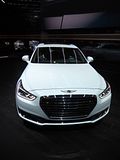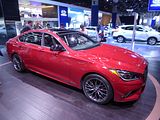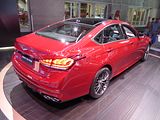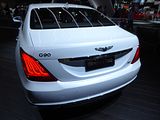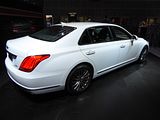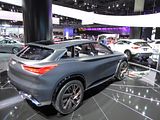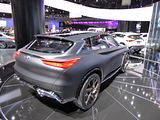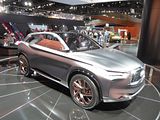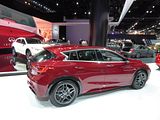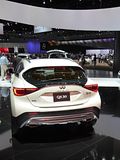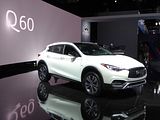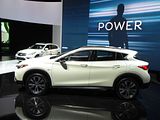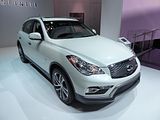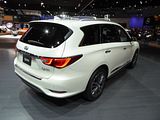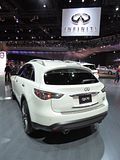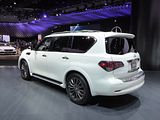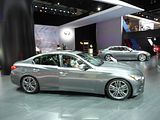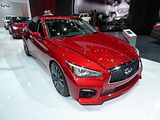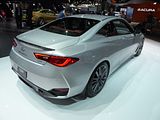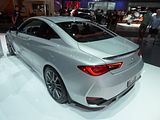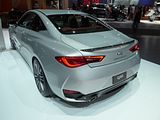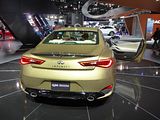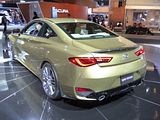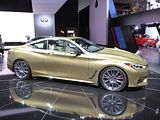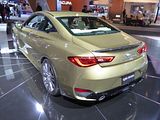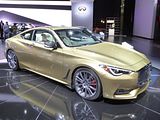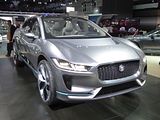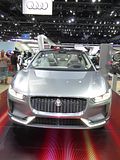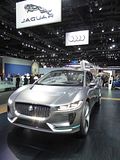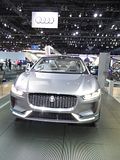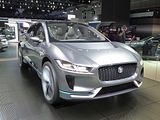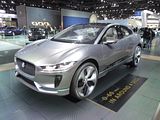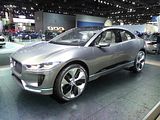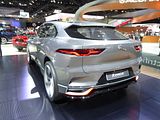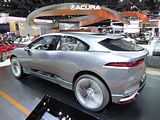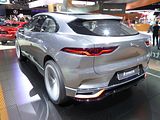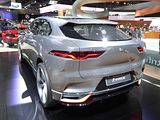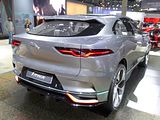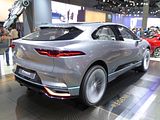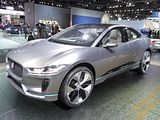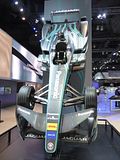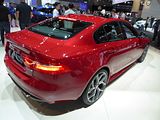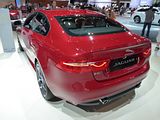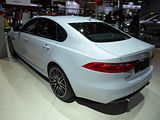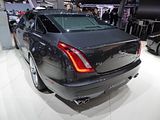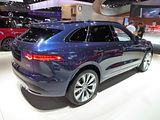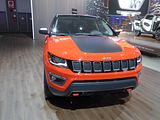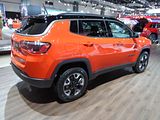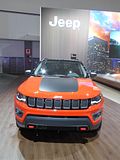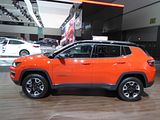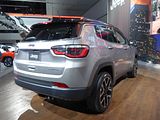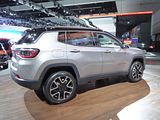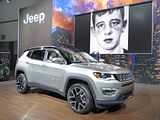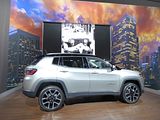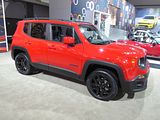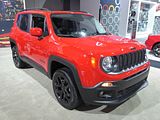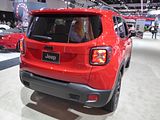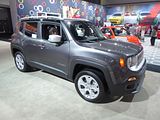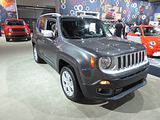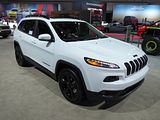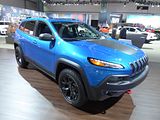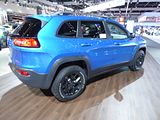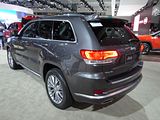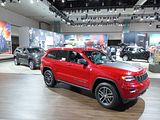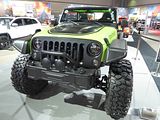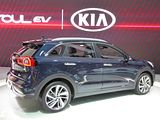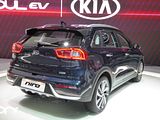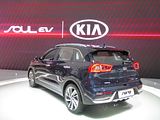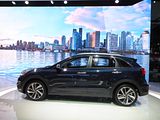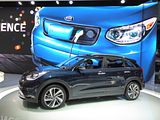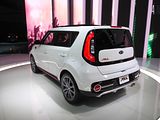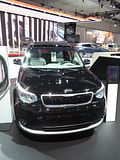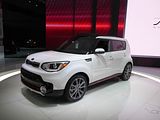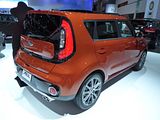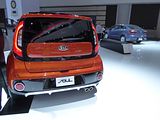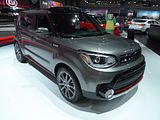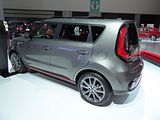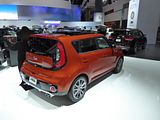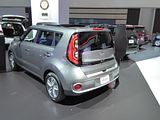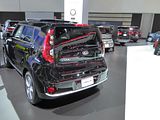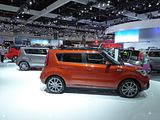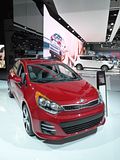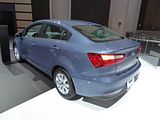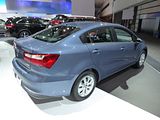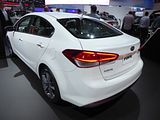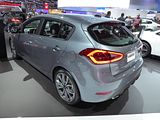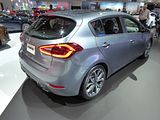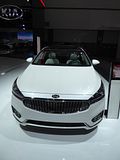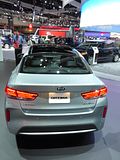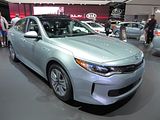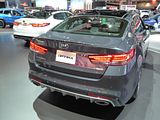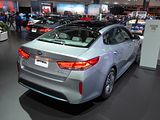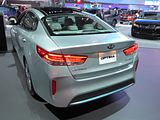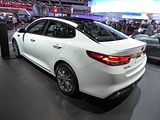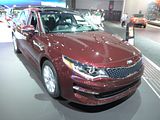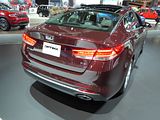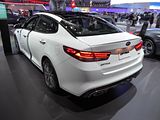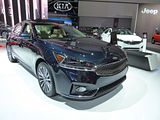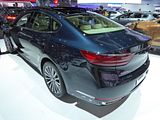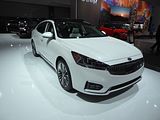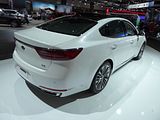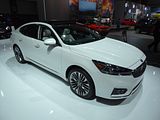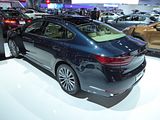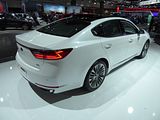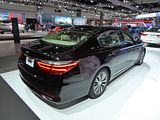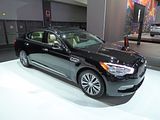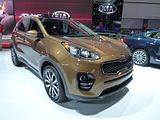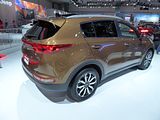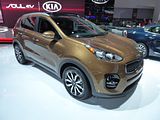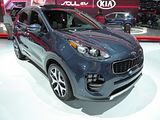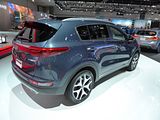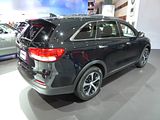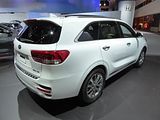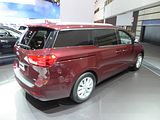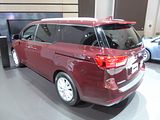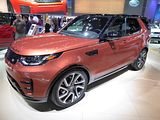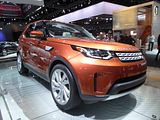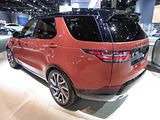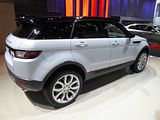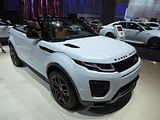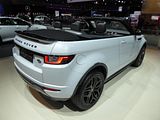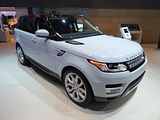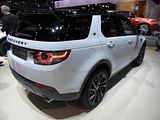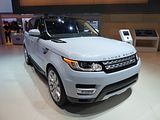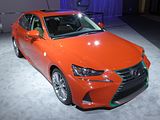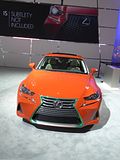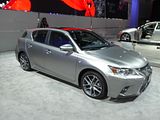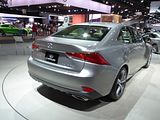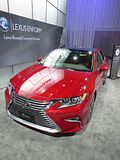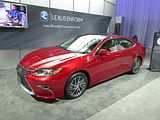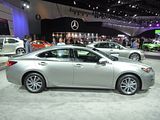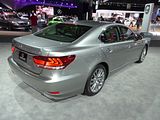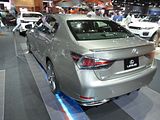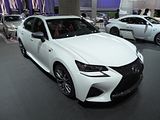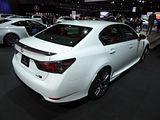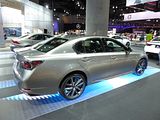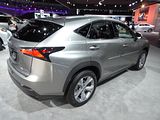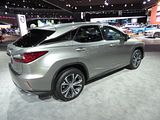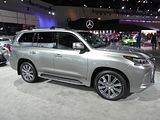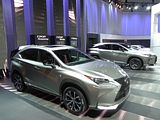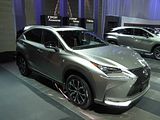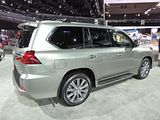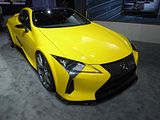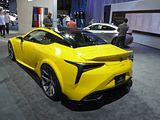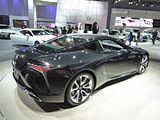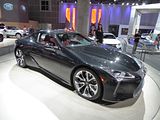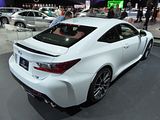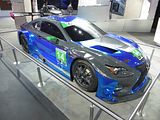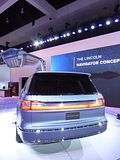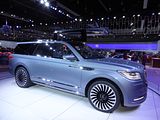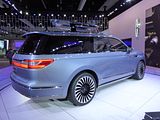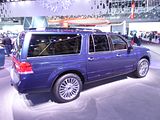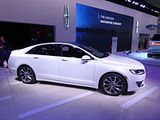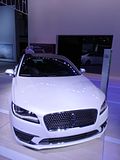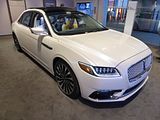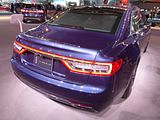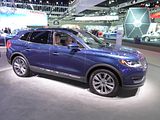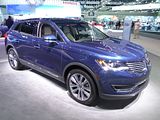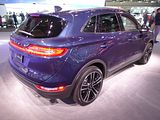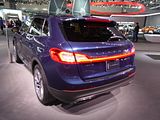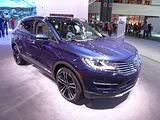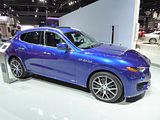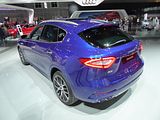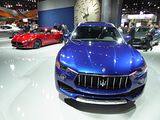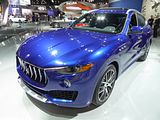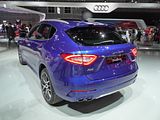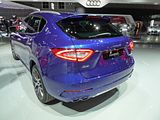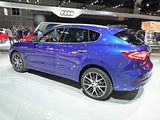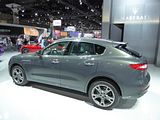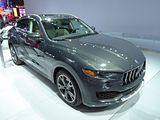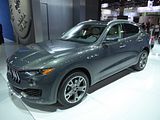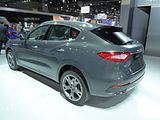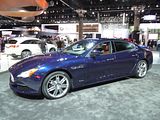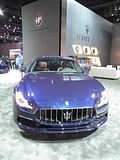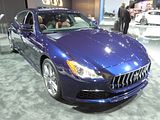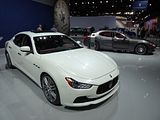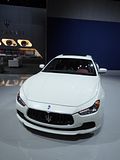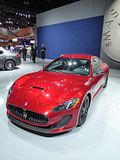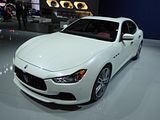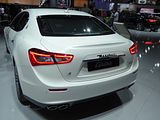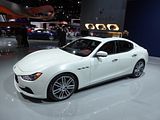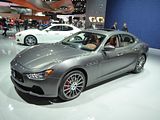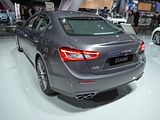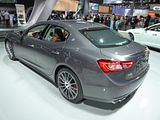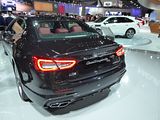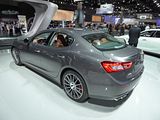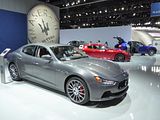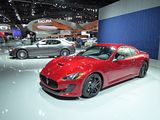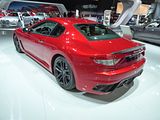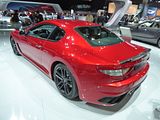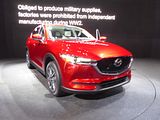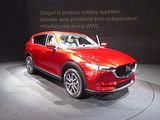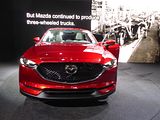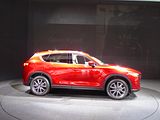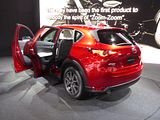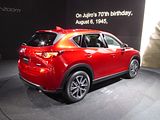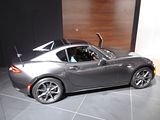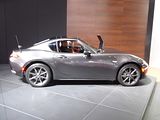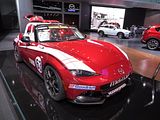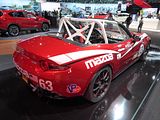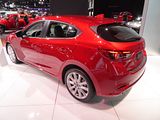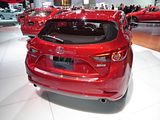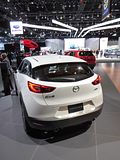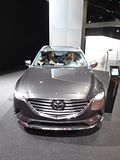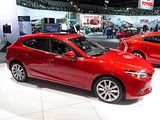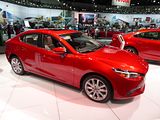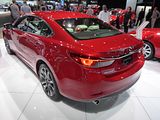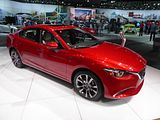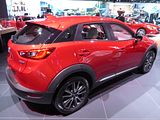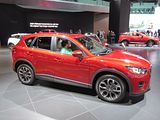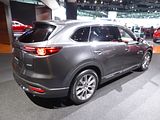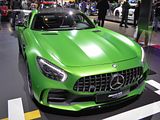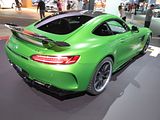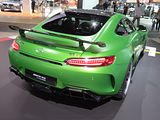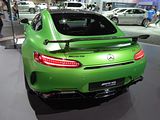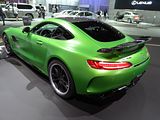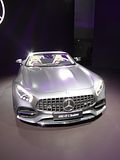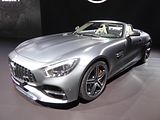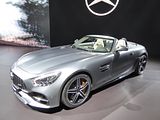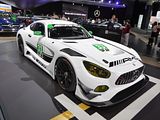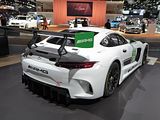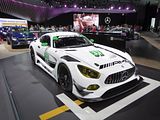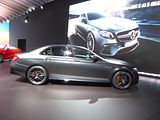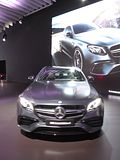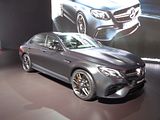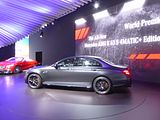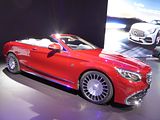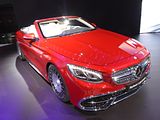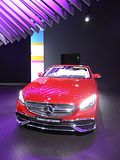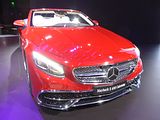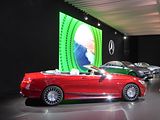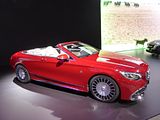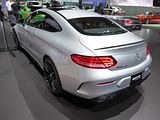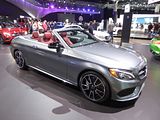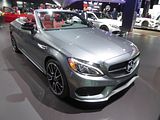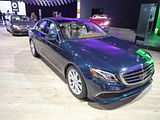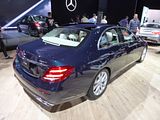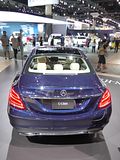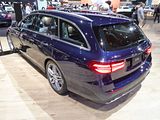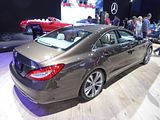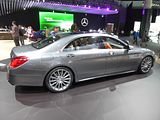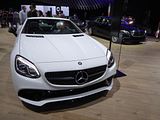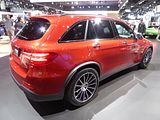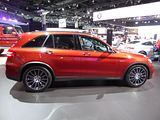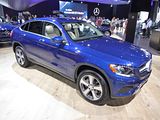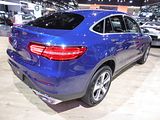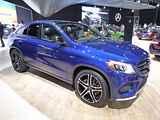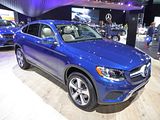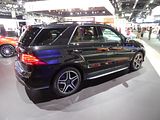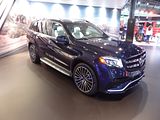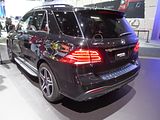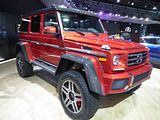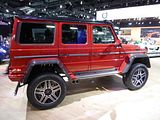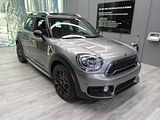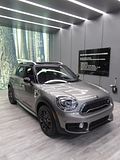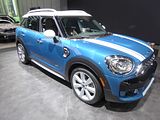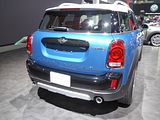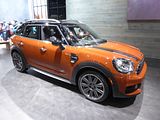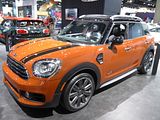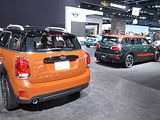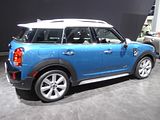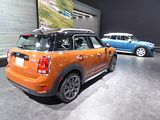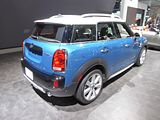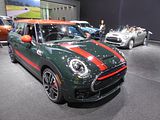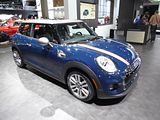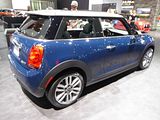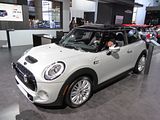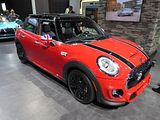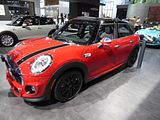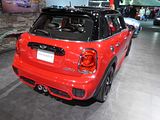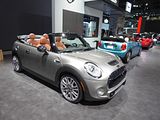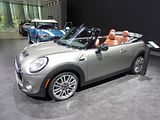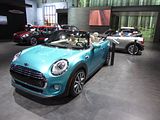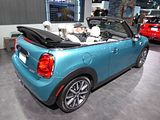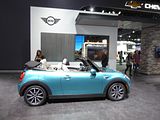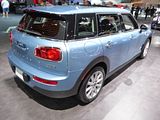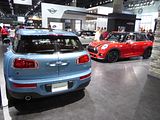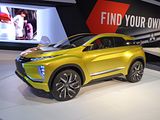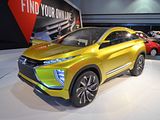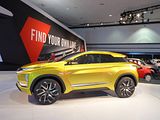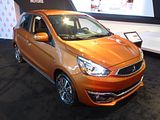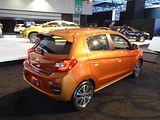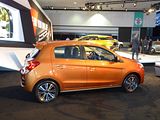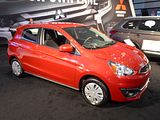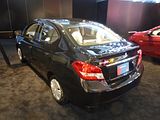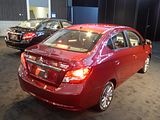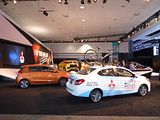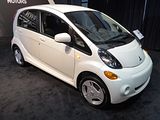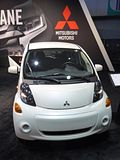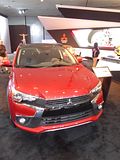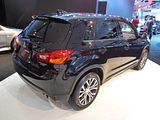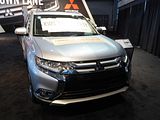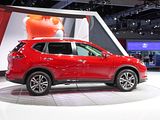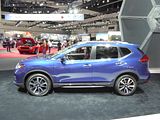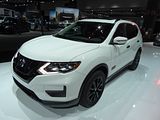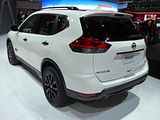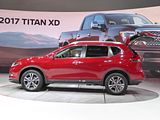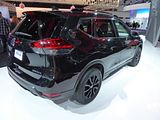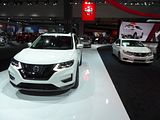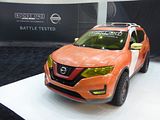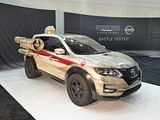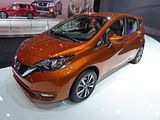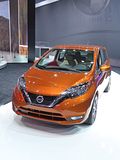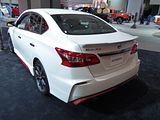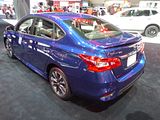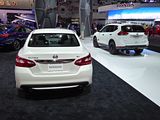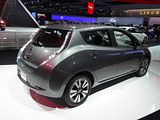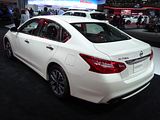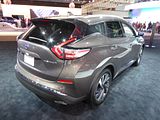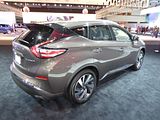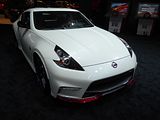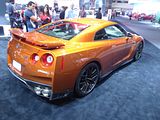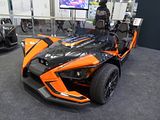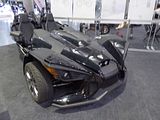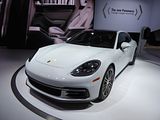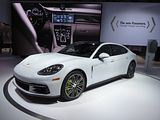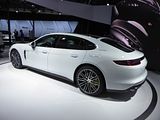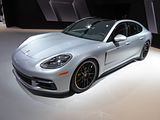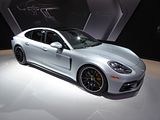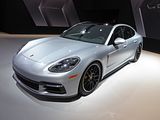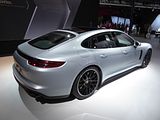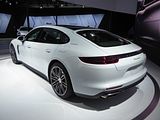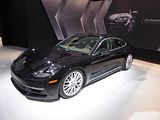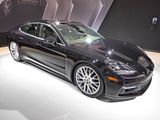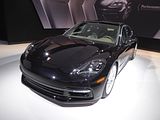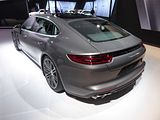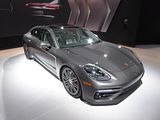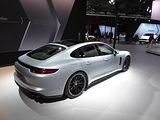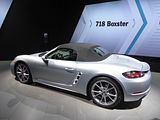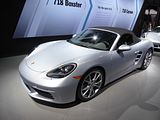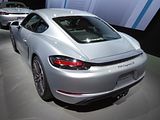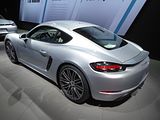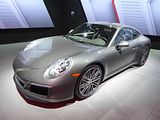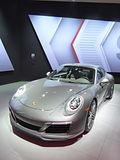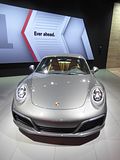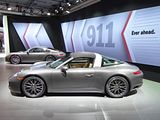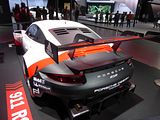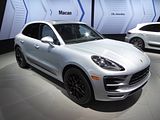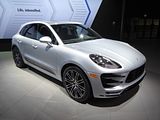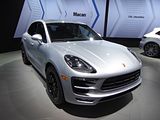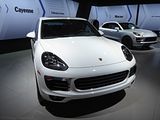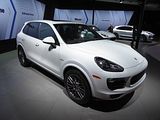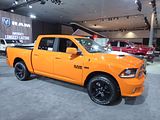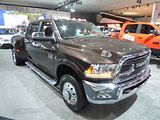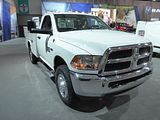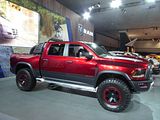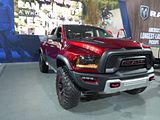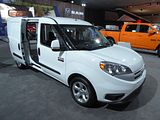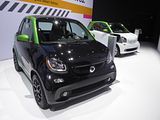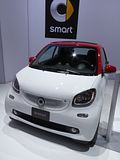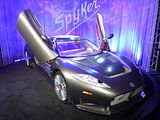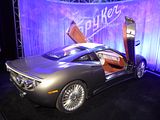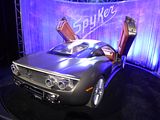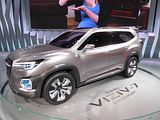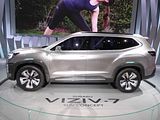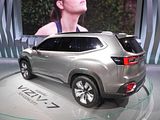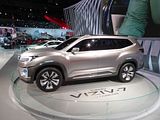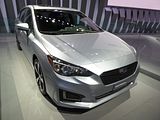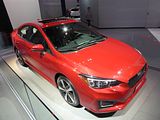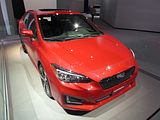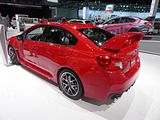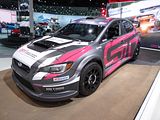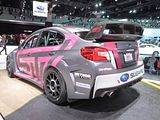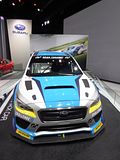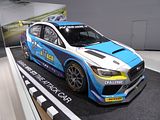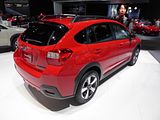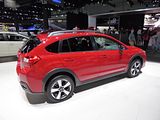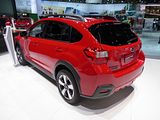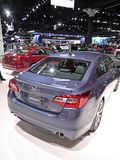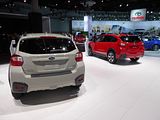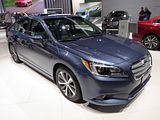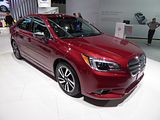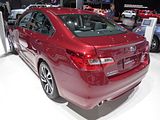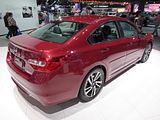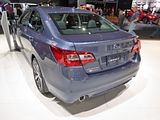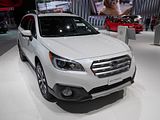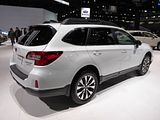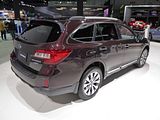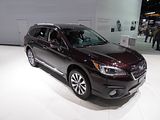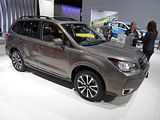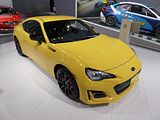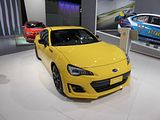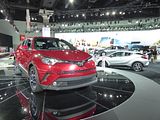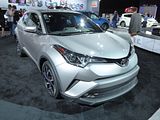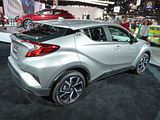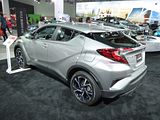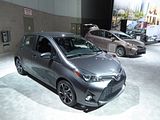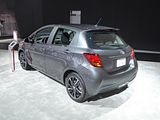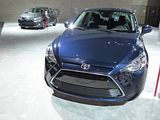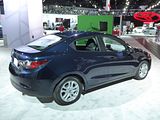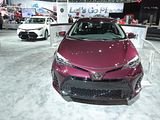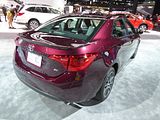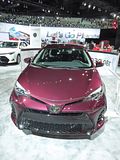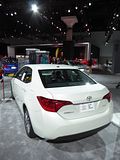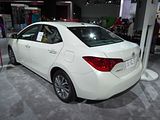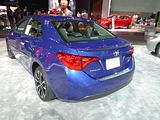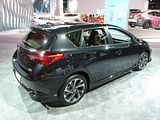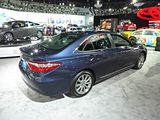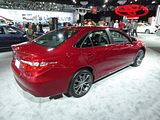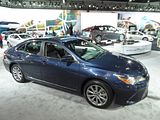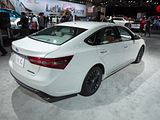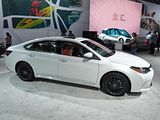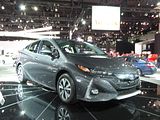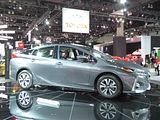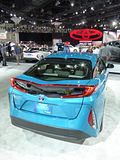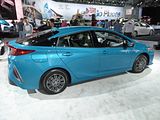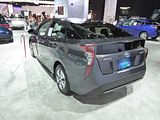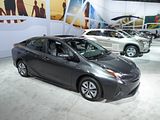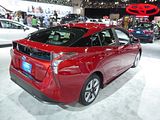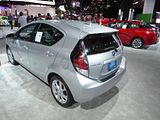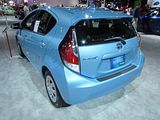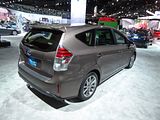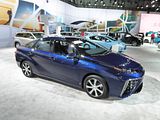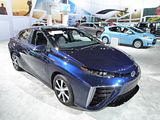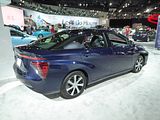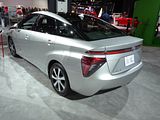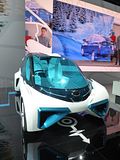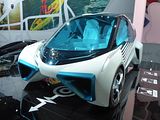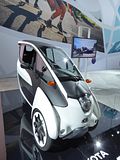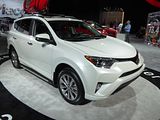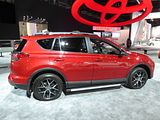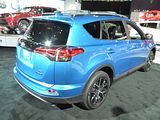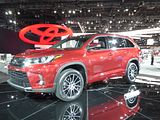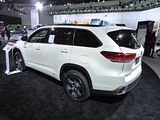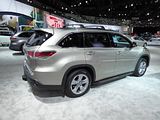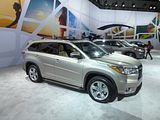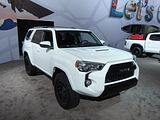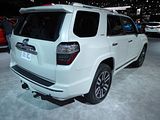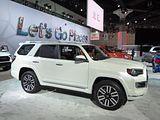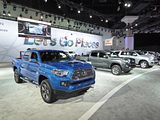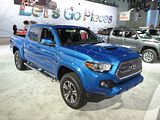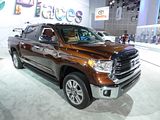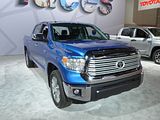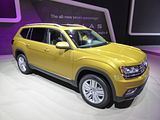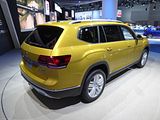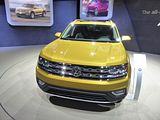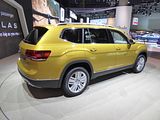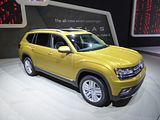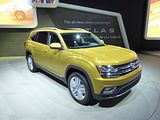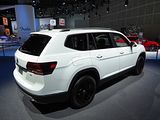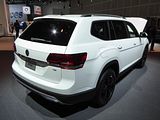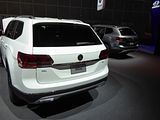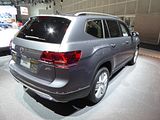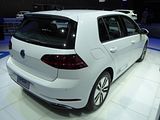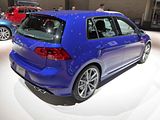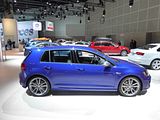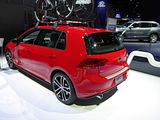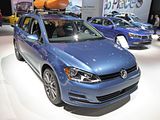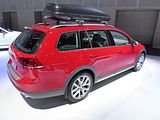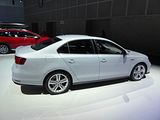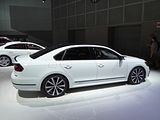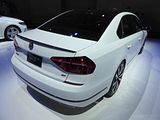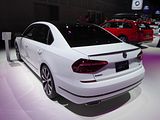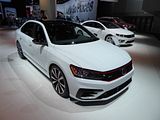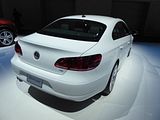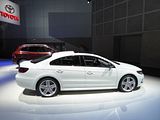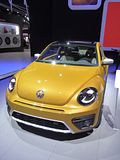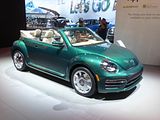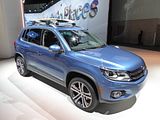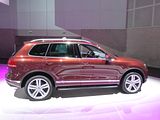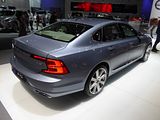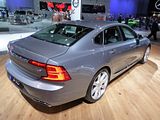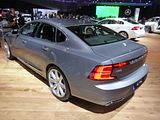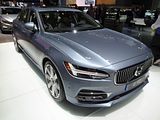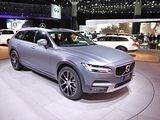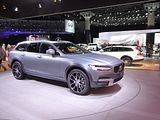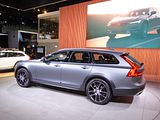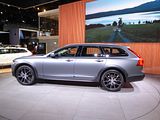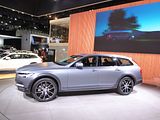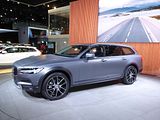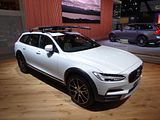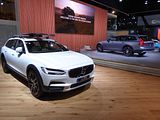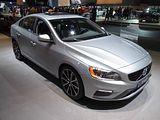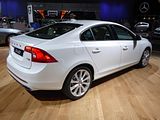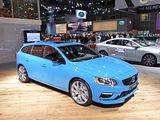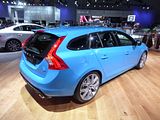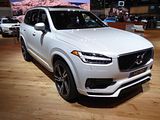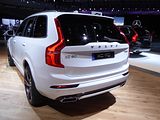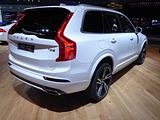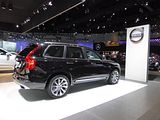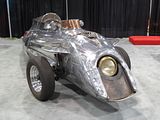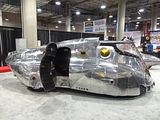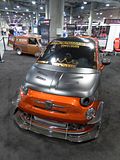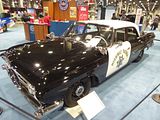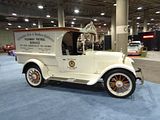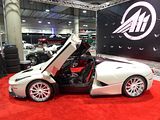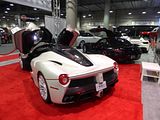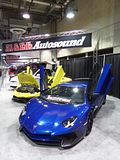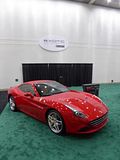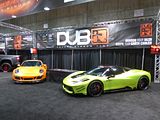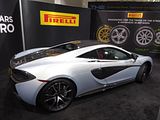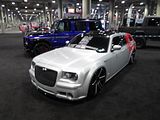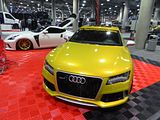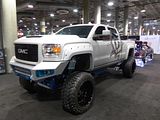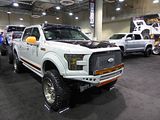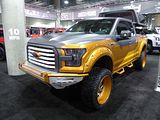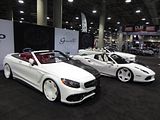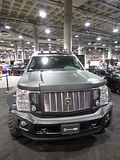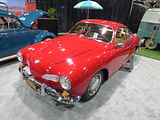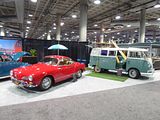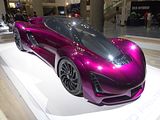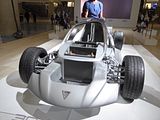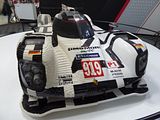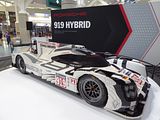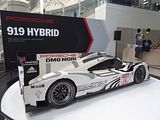Some years ago, now, the decision was taken to move the dates of the annual Los Angeles Show from early January, when it had been uncomfortably close to the then more significant North American International Auto Show, also known as the Detroit Show, to one a few weeks earlier, surrounding the Thanksgiving Holiday period at the end of November. The idea was that it would encourage more manufacturers to bring new cars and concepts to display on their stands, as opposed to them all holding back for Detroit. It seems to have worked, as in recent years, there have always been a healthy total of world and American debuts at this Show. Of course the reality is that the local market in California is far larger (and more affluent) than that in Detroit. Combine that with a more favourable climate than Michigan State in the depths of winter and you can see the attraction. With the other major US Shows being held in Chicago in February and New York around Easter, it means that there are now 4 places for manufacturers to debut their latest products, spread out over a 5 month period. I’ve visited all 4 of those US Shows at some point in the last few years, but the Los Angeles one is the Show that I return to year after year. It is readily accessible, being held at the Convention Centre which is just to the south west of the downtown Los Angeles area, and at the intersection of the 110, 101 and 10 freeways. There is ample parking on site, and it is only a couple of minutes walk from your car to the entrance gate. With everything contained in a compact site, most of it in 2 large halls, it is a far more digestible day out than some of the larger venues. And of course, there is the legendary Southern Californian climate which even in late November is very agreeable. I’ve only missed the show once in the last 10 or so years, and that was in 2015 when I decided to sample a show talking place in Dubai which was the week before the LA event,. Logistics and work pressure meant I could not do both. Dubai is a bi-annual event, so although I enjoyed that event, it was not a temptation for 2016, leaving my diary clear for a week in California in the days leading up to Thanksgiving, with a visit to the Show on the first public opening day being a clear highlight. There was lots to see, and even though I had actually been to the New York Show only 6 months earlier, plenty that was new and worthy of a closer look. Here are the highlights from the whole day that I spent there.
ABARTH
Strictly speaking this is not a separate marque in America, but merely a badge/trim version of the regular Fiat models on which the cars are based. That is done to avoid the cost and complexity of setting another brand in the US, with all that is entailed, and probably makes sense given the relatively small number of Abarth cars that will be sold in the US per year. That means that the Scorpion badged cars were on the same stand as the Fiats on which they are based. With the launch of the 124 Spider, there are now 2 Abarths for Americans and both were present. The spec of both is different to those sold in Europe and the rest of the world. That is more so the case for the 500, which is still resolutely a 500 and not a 595. There is only one version, a 160bhp car, using the MultiAir engine as opposed to the T-Jet engines that the rest of the world sees. Manual and MTA automatic gearboxes are offered. Some of the little details of the IS market cars have appeared on European cars in their Series 4 guise, the filled-in glovebox and new electric window switches, for instance, but the Series 4 changes have not rippled back the other way, so you still get the original light clusters and front end, though note that the frontal structure is slightly different anyway as a result of needing to meet US regulations and to house that different engine.
ACURA
After tantalising us for what seemed like years (and indeed, it was years) with rumours of a new NS-X, and various concept cars being shown the production model is now available for those lucky enough to afford it and to have a place in the limited production queue to be able to take delivery. Like its predecessor, this car bears Acura badging in the US, even though it is a Honda to the rest of the world. It is a dramatic looking car, and by all accounts is very good to drive, even if it is quite different in nature to the first and much loved NS-X. Needless to say, it was the star attraction on the Acura stand here, not that this stand ever got remotely busy – a comment, I suspect, on Acura’s relative struggle in the marketplace compared to some of their rivals and one reason why this car is branded Acura.
Making another appearance here, after a global unveiling at the Detroit Show in January was the Precision Concept. This dramatic looking car gives us a glimpse of the brand’s new design direction. It is a four-door coupe that measures 204in long, 84in wide and 52in tall, riding on a 122in wheelbase, was penned under the direction of the company’s director, Dave Marek, and created by the Acura’s California Design Studio. Perhaps one of the most notable styling features of the edgy looking study is that it waves goodbye to Acura’s much criticised and mocked ‘beak’ shield getting a newly formed five-point grille with an oversized logo resting in the centre flanked by so-called ‘Jewel Constellation’ LED headlights. Step inside and the Acura’s digital human-machine interface (HMI) will scan you, selecting personalised features that include the performance settings, maps, audio and other functions. This is also where the ultra-wide, thin and curved centre display is located, along with the head-up display, floating centre meter, race-inspired steering wheel and the IDS (Integrated Dynamics System) controls. To my eyes, this is a big step in the right direction, after Acura have spent many years in the very wrong direction.
Three Acura sedans that you can buy right now were on show: in increasing order of size these were the Civic-based ILX, the mid-sized TLX which takes aim at the German trio of similar sized saloons as well as Lexus and Inifiniti rivals and the very slow-selling executive RLX which is struggling almost as badly as its worthy but dull predecessor did.
Commercially more significant are the Crossover pair, of RDX and larger MDX. Both these were refreshed relatively recently, so there was nothing new of significance to see in either model, with no changes for the 2017 model year. Although Acura have largely banished the weird styling detailing (the dreaded beak look) that afflicted all their offerings for a 10 year period, sales have still not taken off. They must be wondering what they have to do next to try to boost interest in their cars, and I guess that is where badging the NS-X as Acura comes in.
ALFA ROMEO
Making its worldwide debut here was the eagerly awaited Stelvio SUV, with two examples of the top of the range Quadrifoglio, the only version so far seen, on the stand. Both were locked, so getting inside them will have to come later, but from the outside, this looked exactly like you imagined it might and indeed hoped it would. Alfa Romeo has made some bold claims during their official presentation of the Stelvio Quadrifoglio, including Alfa’s promise to show the world that their SUV is the fastest of its genre around the Nurburgring. Reid Bigland, Alfa Romeo’s boss has said that their simulation data showed them that the Stelvio Quadrifoglio is capable of posting a lap around the 7min 59sec mark, beating the Porsche Cayenne Turbo S around the iconic track. Alfa are saying that they’ve identified their direct competition in the Porsche Macan Turbo, the Mercedes AMG GLC 43 and the Audi SQ5, making it clear of their will to go after the German establishment with the new Stelvio. Power comes from the same, Ferrari-derived twin-turbo 2.9-litre V6 engine found in the range-topping Giulia, producing 505 bhp and 443 lb-ft of peak torque. Straight-line performance is rather staggering for an SUV, with the Stelvio Quadrifoglio expected to post a 0-60mph in 3.9 seconds and a 177mph top speed. An eight-speed automatic gearbox will offer upshifts in just 100 milliseconds in Race mode while the Q4 all-wheel drive system is rear-biased and features a torque-vectoring differential. As for the lesser Stelvio and Stelvio Ti models, they will be powered by an all-aluminium 280hp 2.0-litre turbo petrol engine paired also to an eight-speed automatic gearbox and all-wheel drive. 0-60mph is expected to take 5.4 seconds. A range of active safety systems will also be present, including the so-called Full-speed Forward Collision Warning-Plus which can bring the car to a full stop when a potential frontal collision is detected, Adaptive Cruise Control-Plus with Full Stop which can also stop the car completely under certain traffic conditions and Lane Departure Warning. Although the idea of an SUV was unthinkable in the past, the success (and profits) that such models have brought to Porsche, Jaguar and more recently even the likes of Bentley and Maserati are just too great to ignore. Expect this to be be Alfa’s biggest selling model in the US, and probably other markets as well.
Americans will soon also be able to buy the Giulia, and there were 5 of these on Alfa’s stand. The Quadrifoglio, looking stunning in a vibrant bright blue, a colour which really suits it, was on a plinth, only readily accessible to the show girl who stood by and tried not to look too bored as she posed for umpteen photos knowing that people were probably more interested in the car………. but the other 4 were open and were more or less permanently occupied by people wanting a closer look. American buyers will only get the petrol powered models, with the 2.2 litre unit, just as there is in the Stelvio, and the Quadrifoglio has the same 505 bhp 2.,9 litre twin turbo V6 which gives the car a blistering performance.
Tucked away to one side of the stand were the pair of models which actually marked Alfa’s return to the US, the 4C Competizione and Spider.
ASTON MARTIN
Not that long ago, Aston Martin used to have a presence of their own, as indeed did many of the other prestige and high end manufacturers, but post 2007 Credit Crunch, that all stopped, so if you want to see any of the exotica, you could well be out of luck. There were a couple of Aston models in the hall dedicated to the offerings of local dealer and customiser, Galpin. The Aston Martin models shown here, a V12 Vantage, a Rapide and a Vanquish, were mercifully standard, unlike a lot of the rest of what they had on show, which we will come to further down this report.
AUDI
Across the back of the Audi stand, on a display plinth area were three of the most desirable models from the range: an RS7, and two examples of the latest second generation R8. As well as the Spyder, there was one of the V10 Plus Exclusive Editions, which was revealed just a couple of weeks before the show opened. This model benefits from the innovative laser headlight technology, which is brought to US consumers for the first time, after being cleared by the Feds. No longer considered to be too bright for US roads, the system activates automatically at speeds above 40 mph. Additionally, the laser light is coupled with dynamic turn signals for the first time ever on an Audi. Setting it apart furthermore is a Quantum Gray exterior finish, which is joined by a carbon fibre front lip spoiler, fixed rear wing, diffuser and side mirror casings. This special edition R8 also comes with carbon ceramic brakes, 20-inch wheels and a plethora of amenities inside, from an Alcantara headliner, to black and orange leather. Only 25 examples will be sold, with the price set at $229,200, excluding the $1,250 destination fee.
There is far less choice of A3 model offered to US buyers than we get in Europe, with the 3 door hatch not sold at all, and the 5 door Sportback only coming in e-Tron guise, an example of which was on show. It was joined by an A3 Cabrio and an S3 Saloon.
The A4 range is also reduced in size, with just saloon and AllRoad models sold to Americans. Both were represented here.
Audi were also debuting their latest A5 and S5 range. In the past, this meant the Coupe and Cabriolet, but not the Sportback, but that changes this time around, for the B9 generation cars, with all three body-styles now going to be offered to American customers. They retain the updated design of the Euro-spec cars and will arrive in U.S. dealerships in the spring of 2017. In the States, the new Audi A5 Sportback will be offered with a 2.0-litre four-cylinder engine putting out 252 bhp and 273 lb-ft of torque. When joined with the seven-speed S tronic dual-clutch transmission, it will accelerate to 60 mph in 5.7 seconds, just 0.1 slower than the A5 Coupe. The more potent S5 Sportback features a 3.0-litre TFSI V6 engine delivering 354 bhp and 369 lb-ft of torque. Unlike the A5, it has an eight-speed Tiptronic automatic transmission that helps to achieve a 0-60 mph sprint time of 4.5 seconds. Key mechanical similarities between the duo is quattro all-wheel drive, a self-locking centre differential, wheel-selective torque control, redesigned front five-link suspension and an optimised position for the steering-rack. Just like the variants offered elsewhere around the world, U.S.-bound A5 and S5 Sportback models are offered with the same 7.0-inch or 8.3-inch infotainment systems alongside Audi’s ever-impressive 12.3-inch virtual cockpit. Also being launched – as a world premiere, were the Cabriolet models, but search as I did, I could not see them on the stand. I have a sneaking feeling that they were only here for the media and then taken away again.
From the upper reaches of the saloon-based part of the range were an A6 and S6, an S7 and two examples of the top model, an A8L and the very potent S8 Plus.
The TT was represented by both a Coupe and a Roadster
Making its first appearance on US soil was the all-new second generation Q5, a single example of which was on the stand, sandwiched between the smaller Q3 and larger Q7. American customers will be offered initially a single powertrain choice in the 2018 Audi Q5 and that’s the 252hp 2.0-litre TFSI petrol engine paired to a seven-speed S-Tronic dual-clutch gearbox. Performance of this version is more than adequate, as Audi claims a 0-60 mph time of 5.9 seconds, 1.1 seconds faster than the model it replaces. Power is transmitted to all four wheels via a new generation of the brand’s signature Quattro system that uses an electronically controlled multi-plate clutch along with a decoupling rear axle differential to achieve fully variable torque distribution. The front five-link suspension is fully redesigned in order to provide more comfort and more agility to the model’s driving character. Audi will offer an adaptive suspension as an option, featuring continuous electronic damper control and different operating modes through the company’s Drive select system. The Audi Drive Select offers five different driving modes – comfort, auto, dynamic, offroad, and individual, helping the driver to choose the option that best suits the driving conditions and handling preferences. The cabin of the new Audi Q5 promises to offer a greater feeling of spaciousness, including more legroom and shoulder room at the back and the latest tech features of the brand, such as the optional Virtual Cockpit, MMI Touch infotainment and the standard smartphone connectivity features like Apple Car Play and Android Auto. Audi has also given the new Q5 a full suite of advanced active safety systems, such as the standard pre sense city system that can initiate full braking at speed of up to 52mph when it detects cornering and stationary vehicles, as well as pedestrians that could lead to a potential collision. Another highlight is the traffic jam assist system that can operate the vehicle at speeds between 0 to 40mph during congested traffic. The all-new 2018 Audi Q5 will go on sale in the U.S. market in spring 2017, with pricing to be announced closer to that date. Further models will join it over time.
The new Q5 was displayed between the other two Audi crossover vehicles, a Q3 and a Q7.
BAC
Making a first appearance at this Show was the BAC Mono, the exquisitely built sports/track car that, notwithstanding its lofty price tag has found a small niche in the market, which is now available to US customers. The latest ones comes with a 305 bhp version of Ford’s 2,5 litre V6 engine, which gives it a lovely performance. BAC had a stand area which was not a lot larger than their car, stuffed to one side of the concourse at the top of the stairs between the west entrance and hall. I suspect that a lot of people would have simply walked past it, not realising what they were missing.
BMW
BMW have a large stand, with space for only a subset of the range of cars that they sell in America, even though this is not as extensive as the number of models that are offered to Europeans. It never gets as packed-out as it does at one of the larger European Shows, so it does give you a better chance to have a look at some of their recent offerings and it causes less frustration for the photographer. There were plenty of those recently launched models here, but nothing that was actually new. even to Americans.
There were three examples of the iPerformance range here, the new branding for the petrol-hybrid models that are also available in Europe and which combine the advantages of a petrol engine with a very low official CO2 emissions rating. Cheapest of the three here was the $44,695 330e iPerformance that combines a 2.0-litre turbo’d four-cylinder with an electric motor for a total system output of 248 bhp and 310 lb/ft of torque.
Further up the price ladder is the $90,095 740e xDrive iPerformance that uses a 2.0-litre four-cylinder turbo unit and an electric motor, developing a total of 322 bhp and 369 lb-ft of torque, for a 0-60mph sprint in 5.9 seconds, and a top speed of 140 mph.
The German brand’s iPerformance plug-in hybrid range ends with the X5 xDrive40e that also gets a 2.0-litre internal combustion unit and electric motor fed by a lithium-ion battery. The SUV that can travel for 14 miles (23 km) on battery power alone costs $63,095.
If those are not green enough for you, BMW do of course have their all-electric cars, the i3 and i8. Both were on show.
In addition to the iPerformance and i ranges, BMW were showcasing the updated 2-Series. With an increased output and torque of 248 bhp and 258 lb-ft the 230i Coupe and Convertible take power from a 2.0-litre unit, while the 240i models feature a new 3.0-litre petrol six, good for 335 bhp and 369 lb-ft of torque, an additional 15 bhp and 39 lb-ft over the previous M235i models. A 230i Coupe was joined by an M240i Convertible and the top of the range M2.
From the next size up were an regular 3 Series, an M3 Saloon and a 4 Series Cabrio.
There was no sign of the new 5 Series which has just been revealed in its native land, so larger models were represented by the even bigger 6 Series, with both a 640i Cabrio and the very elegant and desirable M6 Gran Coupe on show.
BMW have repeatedly said that there will not be an M7 for this generation just as there was not for previous 7 Series models. But there are two different cars available which could easily and credibly be so badged if the Bavarian firm wished to do so. The one with BMW’s own badges on it is the 760i xDrive, which produces a stonking 601 horses and 590 lb-ft of torque from a turbo’d 12-cylinder engine that allows the luxury sedan to accelerate from 0 to 60 mph in just 3.7 seconds, and up to a top speed that is limited to 155 mph. As an alternative, you could always choose the Alpina B7 xDrive, which delivers 600 bhp and 590 lb-ft of torque from a 4.4-litre 8-cylinder unit, that gets the luxury saloon up to 60 mph in 3.6 seconds. The high-performance Alpina model costs $137,995. and is quite popular especially in this part of America.
There was one example of the rest of the X range of Crossover/SUV cars. The second generation X1 is sold in America, unlike the first one, so that was the stating point, and then we also have the X3, an X4 M40i and a top of the tree X6M.
BUICK
Buick first showed the world their Avista Concept at the Detroit Show back in January, but decided that it was more interesting than the sort of car you see once and never again, so it was presented again here, taking a star billing on a turntable on the stand. Buick claimed when they first showed it that they were “rekindling their historic performance roots”, which would seem to be stretching a point a bit. Anyway, this 2+2 coupe gets its mojo from a new 400 bhp twin-turbocharged V6 driving the rear wheels through an eight-speed automatic transmission, while also featuring start-stop and cylinder deactivation technology, and GM’s Magnetic Ride Control for the suspension. so it would certainly perform quite well on the road, were it to be built. Buick doesn’t specifically say it, but given that the study has the same exact wheelbase length as the new generation Chevrolet Camaro at 110.7 inches, it would seem likely that the two cars share the same Alpha underpinnings, sourced from the Cadillac ATS, which would make a production version all the more plausible. For the time being, Buick sees the Avista as a concept that “pushes the brand’s contemporary design ethos and rekindles its historic performance roots”. It’s a more restrained yet elegant take on the sports coupe theme, with a hunkered down stance on the outside, and a high-tech interior with widescreen display that covers two-thirds of the otherwise, minimalist dashboard, and a centre console that incorporates touchscreen controls and extends to the rear seating area. I quite liked it.
Two all-new Buick models that you can buy right now were also on show. First of these was the new LaCrosse. The launch of this was actually at the 2015 Los Angeles Show, but it is only now that the car has gone on sale. It is only available with a 3.5-litre V6 which produces 305 bhp and 268 lb-ft of torque and is Buick entrant in the near-luxury mid-size market, competing against the Toyota Avalon, Chrysler 300C, Kia Cadenza and Genesi G80 and G90. Based on the P2XX platform, GM’s new global midsize platform, the vehicle comes with a weight loss of 300 pounds (136kg) over the previous generation thanks to lighter, high-strength steels used in its construction. Mind you, weight shedding wasn’t the only performance thing Buick’s engineers addressed, as the car new model now comes with a five-link setup rear suspension system, complemented by HiPer Strut front suspension and – optional – electronically controlled air dampers, for various driving mods (ranging from “Touring” to “Sport”). Style-wise, it’s obvious that the new LaCrosse borrowed most of its lines from the Avenir concept, although the final product looks closer to Opel’s design language, rather than an original approach. In the end, Buick chose to play it safe, going for the classic, traditional style – for which the car maker is known for. The cabin doesn’t astound either, keeping a simple layout garnished with leather and wood trims – exactly what you would expect for this type of automobile. Even so, Buick is ready to offer a heads-up display and heated front seats with massage function. I think it looks quite impressive both inside and out.
The second one could have a more difficult time in the market, if newly elected President-Elect Trump decides to make a big fuss, as it is made in China. This is the Envision, a mid-sized SUV which looks like the right car at the right time for Buick. Their sedan sales are down but dealers can’t get enough of the crossovers. Smaller than the established Enclave it may be, but it still follows the Buick philosophy of being more luxurious than regular brands, and let’s be honest the 7 or 8 seater Enclave is big, very big in fact, whilst the Envision is really the right size for what people consider a luxury crossover to be. While it looks small externally, the interior is extremely spacious. Seating is upright and there’s lots of rear legroom, with a seat that slides for more cargo space – although there’s plenty of that in the first place. There are flaws, however, but none that could be blamed on the Buick’s built-in-China status. The Envision doesn’t actually feel particularly upscale. Plastics are of a good quality, but nothing significantly better than what Chevrolet is putting into their new sedans. It’s also not quite up to what you’d find in an Audi Q5 or Volvo XC60. This might matter more when we find out how much it’s going to cost, because the Envision would win an opulence race against a Ford Escape Titanium or Honda CR-V, for example. Nevertheless, it’s all put together well enough. And then there’s the look of the whole thing. It’s not unattractive, but the Envision seems to lack anything particularly distinctive or detailed. The styling may be too conservative on the outside. And inside, the clearly fake wood and purple accents on one example I got into were a bit much. It breaks no new ground, but because it’s the right size and will probably be priced in a sweet spot, those in the market for a plush two-row crossover will find a lot to like in the Envision. So it could do well.
There was a facelifted version of the smaller Encore on show here. This car will be familiar to Europeans, as it based on the Vauxhall/Opel Mokka, and the changes to the Encore largely mirror those made to the Mokka as it mutated into the Mokka X. Tthere are some subtle styling changes with a new front grille being the most obvious recognition point. On the mechanical front, the Encore draws power from the same 138 bhp and 148 lb-ft 1.4-litre turbocharged petrol engine, with the 2016 Encore Sport Touring Edition’s more powerful 1.4 litre Turbo that delivers 153 bhp and 177 lb-ft being offered as an option on the Leather and Premium trims. Start/stop technology is available on most trim levels as well as 10 air bags and StabiliTrak stability enhancement control. The interior design has been revamped as well, with the 2017 model coming with a greater emphasis on material selection, as well as an updated instrument panel that flows across the dash incorporating new gauge cluster with a 4.2-inch-diagonal colour driver information centre. The appeal of the cockpit is completed by a new, frameless 8-inch colour touch screen. The Encore was Buick’s best-selling model in North America last year (it’s also sold in Mexico and China), accounting for nearly a third of overall sales.
Buick launched their version of the Cascada earlier in the year. Visually, it is little different the ones available (that no-one much seems to buy!) in Europe, though the engine choices are different and the car has been reworked to meet all US legislation and regulations. Joining the Cascada Sport Touring painted in a vibrant True Blue exterior colour a few months back, Buick is now adding Sport Red to the mix, alongside a new Dark Effects package. Buick claim that if offers “a modern style statement with blacked-out exterior trim and red interior stitching.” Aside from the brilliant shade of red, Cascada ST customers can now enjoy the Dark Effects package, featuring a gloss-black finish on the grille, mirror caps and 20″ wheels, as well as body-colour trim across the boot lid. Inside, the red stitching adds contrast to the instrument panel, doors and seats and as chance would have it, all of this is somewhat of a limited option since Buick will only build 150 such units (Sport Red+Dark Effects pack) initially, set to arrive February 1st, 2017. According to a recent Autotrader study, almost a quarter of customers will delay purchasing a vehicle if the colour they want isn’t available – which is why Buick plans to regularly offer new colour and trim combinations for the Cascada, giving themselves more opportunities to explore different styles and connect with different types of buyers. I was slightly surprised to learn that the Cascada has managed to outsell the BMW 2-Series, Audi A3 and A5 convertibles through August, with six out of ten buyers coming from outside Buick and other GM brands.
The Regal is likely making its last appearance here, as expectation is that a new one will appear at some point after the imminent launch of the Vauxhall Insignia on which it is based.
Final Buick on display was the Enclave, the long-running 7 or 8 seater Crossover built on the Lambda platform. Again, a replacement if believed to be not far away.
CADILLAC
Star of the Cadillac stand was the Escala Concept, which was shown at Los Angeles in late 2016, following its first appearance at Pebble Beach back in August. This futuristic-looking study, which wears the Escala moniker – that’s Spanish for ‘scale’ looks quite unlike current production Cadillacs. The brand is not saying much about it (at least not facts, the girl on the stand had plenty of verbage to spout, but it was all PR fluff!), so it is not clear whether this is just another study and nothing more, but given that the GM-owned brand has been struggling in trying to challenge cars such as the Mercedes-Benz S-Class, BMW 7-Series, and Audi A8, it may actually be close to a future production vehicle. Even if this isn’t the case, then it could be giving us an early preview of Cadillac’s future design language, which actually looks pretty sharp. Meanwhile, in the cabin, most knobs and buttons have been replaced by generously sized screens and surfaces are covered in either wood, leather or textile material.
There’s a very strong visual link between the saloon models in Cadillac’s range these days, and you need to look quite closely to tell them apart. On show here were saloon and coupe models of the entry level car, the ATS, with the Coupe represented by the fiery ATS-V version.
Also present were the CTS, the front wheel drive XTS and the larger and brand new rear wheel drive CT6. This latter was being shown in a new Plug-In Hybrid guise, which Cadillac have now announced will arrive in the US in the spring of 2017, featuring a driving range of more than 400 miles. The car was actually fist shown at the Shanghai Auto Show, when it was revealed that its two-motor EVT system, combined with the 2.0-litre turbocharged four-cylinder petrol unit, would produce a total output of 335 bhp and 432 lb-ft of torque. Each electric motor puts out 100 bhp (74.5 kW), and on electric power alone, the CT6 PHEV can run for approximately 30 miles, up to a top speed of 78 mph. It can also hit 60 mph from a standstill in an estimated 5.2 seconds, similar to its V6-powered competitors, though with twice the full EV range and MPGe (miles per gallon equivalence) figures. Still, in terms of autonomy, the combination of its efficient turbocharged engine and battery power enables users to drive more than 400 miles before recharging, thus helping remove any range anxiety the driver might experience along the way. Its fuel economy figure is estimated to be 65 MPGe, which in EU terms would be around 3.6 litres/100km. “The CT6 is a technological showcase throughout, and by far the lightest car in its class, making it an ideal platform for electrification,” said Cadillac president Johan de Nysschen. “In the CT6, Cadillac presents a new formula for prestige luxury. The advanced Plug-In Hybrid system is a key addition, providing a combination of exceptional fuel economy, crisp acceleration and strong electric-driving range.” While prices in the US will start at $75,095, there will also be a $995 destination freight charge before any applicable electric vehicle tax incentives. The CT6 PHEV will also be offered as its own unique package within the range, as pricing and equipment levels are to be comparable to the existing Premium Luxury version, which is the second-highest spec in the model range. Among its many on-board features, customers will find several optional technologies as standard, such as Rear Seat infotainment, Enhanced Night Vision and Rear Camera mirror.
Available now, as indeed I noticed quite a few of them in the Hertz fleet during this visit, is the new XT5, a replacement for the SRX Crossover. It follows the same sort of format as its predecessor. European reviews have been particularly scathing, and I was certainly no great fan of its predecessor, so it will be interesting to test one out in due course.
Completing the display was the massive and surprisingly popular Escalade.
CHEVROLET
There have been a lot of new models in the Chevrolet line-up in the past couple of years, and the refreshes continue with the new third generation Equinox making its first show appearance here. Based on GM’s Delta platform, the new Chevrolet Equinox weighs around 400 pounds or about 180kg less than its predecessor, making it more fuel efficient and nimble on the road. Chevrolet will offer the new Equinox with two turbo petrol units and one diesel: entry-level models will be powered by a new 170 bhp 1.5-litre paired to a six-speed automatic while range-topping models are getting a 252 bhp 2.0-litre unit coupled to a nine-speed automatic gearbox. As for the diesel version, this will get a 136 bhp 1.6-litre direct-injection four-cylinder mated to a six-speed automatic, allowing the Equinox to return an estimated 40mpg on the highway. All models will come with FWD as standard, with Chevrolet to offer an AWD system as an option. A number of adaptive safety systems will be offered too, including Forward Collision Alert with Following Distance Indicator, Lane Keep Assist with Lane Departure, Lane Change Alert with Side Blind Zone Alert, a haptic-feedback seat and a surround-view camera system. Other features include GM’s latest MyLink infotainment systems offered with seven- and eight-inch touchscreen displays. The Equinox will also arrive in Europe as a successor to the Opel Antara. Chevrolet will bring the new Equinox in US showrooms sometime in the first quarter of 2017, hoping to steal plenty of customers from the likes of the Toyota RAV4 and the all-new Honda CR-V.
The facelifted Sonic was shown earlier in the year. The distinctive front end has been replaced by something rather less characterful. which fits in with the styling of larger models in the range. The interior has had an overhaul, too, with the weird motor-cycle like dash having been consigned to history. Mechanically, not much has changed. Will this be enough in the face of ever tougher competition in the sub-compact class?
The Trax has also had a mild update, just as the related Buick Encore has been refreshed, and there was one of these small Crossovers on show. The facelift applies styling elements borrowed from the Cruze, Malibu and Volt, and includes reshaped headlights, a number of chrome touches and the dual port front grille. Individual fog lights are also found up front within a matte black plastic housing, mimicking the look of the wheel arches and black side skirts. In the cabin, the refreshed Trax includes a 7-inch MyLink colour touchscreen, redesigned gauge cluster with a digital centre display and a selection of Galvano chrome touches. While the interior and exterior tweaks are noticeable, an improved selection of active safety features really set the new car apart from the outgoing model. Such new technologies include Forward Collision Alert, Rear Cross Traffic Alert, Side Blind Zone Alert and a Lane Departure Warning. Ten airbags also come standard, as does a rearview camera. Power for the 2017 Trax continues to come from a 138 bhp and 148 lb-ft 1.4-litre turbo’d four-cylinder.
Set to go on sale in the first quarter of 2017, Chevrolet’s new Spark ACTIV represents a sportier take on the automaker’s mini-car, combining trail-inspired accents with a so-called urban-chic design, paralleling the similar Opel Karl Rocks which was launched at the Paris Show. The $16,945 price tag will land you the manual transmission version, whereas US buyers looking for a continuously variable transmission option (CVT) will need to spend $18,045. “The new Spark ACTIV is all about adventurous fun and style,” said Steve Majoros, Chevrolet director of Car & Crossover Marketing. “It has an attitude, while still offering the sophisticated, efficient and connected driving experience customers have come to love.” Setting this model apart from the rest of the range is its unique front and rear fascia design, new 15″ wheels, a revised suspension (ride height increased by 0.4 in/10 mm), a specific grille pattern, round fog lamps and fog lamp housings integrated in the front fascia, contrasting wheelhouse mouldings and hatchback cladding, rocker mouldings and roof rails. Inside, there are standard black, heated front seats and a multi-function leather-wrapped steering wheel. Customers might also enjoy the presence of Chevrolet’s MyLink system with a 7″ colour touchscreen, boasting Apple CarPlay and Android Auto compatibility. There’s also a rear-vision camera, SiriusXM satellite radio (three months subscription), OnStar Guidance Plan (three months), 4G LTE Wi-Fi hotspot (three months/3GB data trial), air conditioning, cruise control, remote keyless entry and power windows with Express up/down functionality. I’ve seen very few of the regular second generation Spark model on US roads so far, but the sales tally suggests that someone somewhere is buying them.
Joining the second generation Cruze Sedan is a new 5 door Hatch. There was a 5 door version of the first model, but it was never sold in America. This one will be, though Chevrolet is realistic enough to state that they expect it only to take a small proportion of the Cruze’s total sales.
There are very clear styling links between the latest Cruze, the new Malibu which is also only just starting to appear on American roads and the larger Impala, an example of which was also on show.
Across the back of the stand, there were examples of the two electric models that Chevrolet produce, the second generation Volt and the newer Bolt. Both were launched a few months ago, with the Bolt now starting to appear on America’s roads in reasonable number. The Bolt was celebrating being named as GreenCarJournal’s 2017 Green Car Of The Year. The task of choosing the Chevrolet Bolt over the other finalists, namely the BMW 330e iPerformance, Chrysler Pacifica, Kia Optima, and Toyota Prius Prime, fell in the hands of a jury that included among others, Jay Leno, along with leaders of environmental and efficiency organizations. The publication’s editors say it was selected for its “stylish design, pleasing driving dynamics, and welcome suite of advanced and connected technologies”. More importantly, the hatch boasts an electric driving range of 238 miles (383 km) and can be had from as low as $29,995 in the US, when the federal tax credit is applied. “From the time modern electric vehicles emerged in the 1990s, limited driving range has presented a core challenge to the commercialisation of electric cars affordable to everyday drivers. Bolt overcomes this with its 238-mile battery electric driving range and approachable price, the first production electric car to achieve this milestone”, said editor and publisher of GreenCarJournal, Ron Cogan. This is the second time in a row that Chevrolet has walked home with the award, after last year’s big winner, the second-generation Volt. Moreover, the Bolt was also named MotorTrend’s 2017 Car of the Year.
The sports car were represented by a number of Camaro models including the special Camaro 50 produced to mark the 50th anniversary of the launch of the nameplate, as well as a couple of Corvettes. There were probably bigger crowds around these cars than anything else consistently throughout the whole day. The Camaro 50th Anniversary Edition is available in both Coupe and Convertible 2LT and 2SS (V6 and V8, respectively) models, and it includes a bucket-load of goods. Available only in the Nightfall Gray Metallic exterior hue, the Camaro special sits on 20-inch 50th anniversary wheels, while the special stripe package and “fifty” exterior badges will attest its pedigree and heritage. Other visual add-ons include a unique grille with satin chrome accents, body coloured front splitter and orange brake calipers. The 2LT variant benefits from the RS Appearance package, as well. The interior hasn’t escaped Chevy’s touch, as the 50th Anniversary edition will welcome you into a cabin garnished with suede inserts and orange accent stitching, as well as distinct (and unique) treatments on instrument panels, seatbacks, steering wheel and illuminated sill plates.
The large SUVs were well represented, though it would seem that the Traverse and the biggest of them all, the Suburban are the only ones that I photographed.
Chevrolet’s Vans and Trucks were also on the same extensive stand and there were plenty of examples of these, with a number of the big Silverado here, Chevrolet’s top-selling model.
Also on show was the slightly smaller Colorado ZR2 Pickup, which clearly is so at home off the asphalt that it brought a patch of desert with it to the Show. It might not look like much from a distance, but this particular variant of the Colorado is what Chevrolet calls the most capable truck in its class – or something like that. According to the American car maker, the Colorado ZR2 offers more off-road technology than any of its rivals. A closer look at the vehicle’s features confirms that Chevrolet puts its money where its mouth is, as the compact pick-up comes with a new lifted Multimatic’s DSSV suspension setup, and an all-wheel-drive system that can be programmed in nine different driving configurations. These including everything from Hi 4WD with locked transfer case and rear diff, to Lo 4WD with locked transfer case, rear diff, and front diff. It even offers pure RWD. Additionally, the ZR2 includes an aluminium skid plate incorporated into the front bumper, a bed-mounted spare tyre carrier, and 17×8 inch aluminium wheels wrapped in 31-inch Goodyear Duratrac off-road tyres. All this while sporting a wider track for better stability off the trail. Under the bonnet there’s either the 308 bhp and 275 lb-ft of torque 3.6-litre V6 – mated to an 8-speed automatic transmission – or the Duramax diesel with 181 bhp and 369 lb-ft f torque at its disposal. The choice is yours.
CHRYSLER
Star attraction here was the new Pacifica, the latest MiniVan, which was revealed at the Detroit Show at the start of the year and which is now reaching the dealers. Taking over from the Now discontinued Town & Country, this will be the only derivative of the new design, as there will not be an equivalent Dodge. As well as models equipped with the familiar 3,6 litre V6 PentaStar engine, Chrysler are also offering the Pacifica in a Hybrid version. There were several Pacifica on the stand. I think this looks rather better than any of its rivals, and it also has a very nicely done interior. Although the market for MiniVans passed its peak some time ago, this one should be a strong seller.
There were also examples of the other two models in Chrysler’s range the mid-sized 200, seen herein top of the range 200S guise and the larger and familiar 300C.
DODGE
Dodge had one of the brightest stands of the entire show with some very colourful cars on show. Centre piece were a line of the Charger and Challenger models. The latter was being shown in the new Daytona trim as well as the more potent 392 model, and the Challengers were also represented by models with the V6 and Hemi V8 engines.
The full-sized Durango has received a number of updates over its life, so although it has been in production for several years now, it still looks fresh. I’ve still not managed to drive one, as the few that Hertz have on fleet are always eagerly snapped up.
Dodge’ smaller Crossover was here, too, the Journey. This dates back to 2008, and it would seem likely that there will be a replacement in due course, though nothing much has been rumoured. I drove one on my last trip out here, and although it was a decent enough car, it did feel its age, lacking a lot of the latest technology features that you find in its rivals. It is also that slightly awkward size, sitting in-between the mid- and full-sized classes. It is available with 7 seats, but the rear row is not the most spacious.
The Grand Caravan will live on for now, as a cheaper alternative to the new Chrysler Pacifica, so there was one on show. It will be interesting to see how well sales hold up. They have been strong in 2016, with commercial success belying the age of the model, which dates back to 2007.
Final model on the stand was one which was almost certainly make its last appearance at the Los Angeles Show, as it has been announced that production of the Viper SRT/10 will cease early in 2017 and no successor – sadly – is envisaged.
FIAT
When Fiat relaunched in the US, there was only model available, the 500 Hatch. It quickly achieved a sort of cult status as the year’s “must have” fashion accessory, but the dealers were desperate for more products. Six years on, they’ve got them, as this stand proved. As well as the 500 and the open topped 500C, there was an example of the all-electric 500e, the larger 500L and 500X and the recently launched 124 Spider.
FORD
Highlight of the Ford stand were the duo of GT models on a raised turntable. Neither was the car that the lucky few are going to be able to buy from some time in 2017. One was a beautifully restored GT40 from 1966, the year the car won at Le Mans. This particular GT40 is owned by RK Motors Charlotte and was recently restored by Rare Driver, making its public debut at August’s Pebble Beach Concours d’Elegance. Given how priceless it is, it is fitting that the restoration took 20 months and almost 4,000 hours to complete. Rather than making the vehicle absolutely pristine and faultless, the restoration has actually perfectly mimicked how the car was first produced, complete with all its little faults. That includes the unequal length exhaust pipes and the dripping paint the car had in the mid-1960s. The other was the 2016 Le Mans GTE-Pro Class-winning car. Look closely at this plinth-mounted exhibit and you can see that the car is still wearing its battle scars, which it picked up during a battle that saw it edge out a Ferrari 488, taking the lead in the 20th hour of the race. The car raced under the Chip Ganassi umbrella, which is the only team owner in history to have won the Indy 500, Daytona 500, Brickyard 400, Rolex 24 at Daytona, 12 Hours of Sebring and more recently the Le Mans 24 Hours. Powering the GT race car is a 3.5-liter EcoBoost V6 engine that made its debut in the TUDOR United SportsCar Championship back in 2014, though there are plenty of other mods that deliver high levels of downforce and improved stability.
At the rather more prosaic end of Ford’s range were representatives of all the every day models that Ford sells. The range starts with the familiar Fiesta, available in both 5 door Hatch and a 4 door Sedan, and both were here.
The Focus was represented by Hatch, Sedan and the stonking new RS version.
The Fusion received a mid-life update earlier in the year and the 2017 models are just starting to reach dealers. Several examples were on the stand and they were joined by the larger Taurus SHO.
There were a number of Mustang models here, too, though the expected facelift failed to materialise. On show were Coupe and Convertible cars, with the range of engines including the GT 5.0 and even more brutal GT350.
As part of their One Ford strategy, the Blue Oval has decided to bring the EcoSport to the US and it was making its first appearance on American soil. I got into quite a debate with one of the stand staff as both he, and indeed the lady spouting all the PR babble about it called it an “EchoSport” and I asked why, saying that “Eco” is pronounced “ee-ko”. Not according to Ford it is not. He also told me that he believed that the car was selling like the proverbial hot cakes in Europe. Whilst I was clearly not going to win the battle over how to pronounce its name, I could tell him that it is not exactly a strong seller, despite what he may have been told internally, and that although it is better than it was, the earliest European cars were panned by the press and sales were dismal. It did not seem to deter him from thinking that Ford have a world beater on their hands. I guess you have to believe in your product! So the version on show here is a further facelift for the version already on sale elsewhere, with the company redesigning mostly the front end which was one of the most controversial areas of the original model. The new look does make the EcoSport a much better fit into Ford’s SUV range while the cabin layout is also completely new, with a fresh dashboard design and the company’s latest SYNC3 infotainment system packed in an 8-inch touchscreen display. The available engine range for the US market will include the turbocharged 1.0-litre Ecoboost engine and a naturally aspirated 2.0-litre unit that will be paired exclusively with AWD. Both engines will be mated to a standard six-speed automatic gearbox. Ford didn’t mention any figures yet, but we expect them to do so in a closer to launch date. The cabin will also benefit from a range of attractive features, including a 675-watt 10-speaker B&O Play audio system, seven ambient lighting options, HD Radio technology, SiriusXM satellite radio and a dual FM radio antenna that boosts the range and clarity of FM signals. The new Ford EcoSport will be available in no less than 10 exterior colours and four trim levels – S, SE, SES and the range-topping Titanium. The SES trim level will offer AWD, sports-tuned suspension and bold styling details like bold copper accents for the interior and sport seats. Ford will start selling the new EcoSport in early 2018, where it will go against models like the Nissan Juke, Jeep Renegade and the Chevrolet Trax.
There were lots of examples of the larger Crossover and SUV vehicles in the range, here. The Escape received a refresh earlier in the year, with a new grille and revised lights making it easy to spot. The interior has improved a bit, but is still a weak link compared to its rivals, with a complex button-fest and the use of some rather cheap materials that Ford still think are classy but which are just not. The Ecoboost engines were also revised in line with the changes made to the Fusion.
Going up in size takes you from the Edge to the Flex, the Explorer and the full-sized Expedition and all were represented.
There was a special display for the Hybrid and Electric cars in Ford’s range, with lots of detail on how the technology works as well as the cars themselves. The C-Max is only sold in Hybrid and Energi (electric) versions in the US, and it was joined here bt the latest Fusion Hybrid and the Focus Energi.
The Ford F150 remains the best selling vehicle in America, so it was no surprise to find several of them on show. These are just massive. Every generation has seen the F150 get bigger and bigger – and looking at the front end, more vulgar or forceful, depending on your point of view.
More familiar to European eyes will be the Transit Connect which is sold State-side. It does not sell in large quantities, though, as most Americans think of it as too small.
Americans also get a range of Transit models, now, which took over from the long running E Series Vans a couple of years ago. They look somewhat different from the European ones, though under the skin they share much with the vans that we are so used to seeing on our roads.
GALPIN
Local business Galpin had an entire hall to themselves and that was quite some variety in what they chose to fill it. A few of their display cars looked pretty standard, but the majority were not, with everything from modified current production vehicles to some real classics.
Some of the modern vehicles that have been customised included the Jaguar F-Pace and Volvo XC90, both of them almost inevitable targets given their popularity among buyers in the Pacific South West. Their treatment was quite mild compared to the alterations that had been made to the Mazda MX5 and Mazda 6 which were also on show.
Galpin is a well known and sizeable Ford dealer, so that means that the Mustang has been a car that they know well. It was working with Galpin that renowned designer Hendrik Fisker was able to produce his Rocket. There was not one of those on show, but there were a number of examples of modified and customised new Mustangs for people to look at.
Paying homage to the 50th anniversary of Ford winning the 24 Hours of Le Mans, Galpin created the 2016 Gulf F-150 4×4 and loaded it with top of the line off-roading equipment and tons of GAS hand fabrication – over 750 man hours went into the overhaul of this F-150! It was joined by a Focus RS painted in the same iconic Gulf livery.
This exhibit will be very familiar to those of a certain age. It is of course, the legendary Pink Panthermobile, from NBC’s “The Pink Panther Show,” a worldwide phenomenon in the 70s, This one-off has returned to Los Angeles after 14 years abroad. Originally built for the cost of $100,000, the one-of-a-kind limousine was found and completely restored by Southern California’s Galpin Auto Sports. Built on a 60s Oldsmobile Tornado chassis and sculpted out of sheet metal and top-of-the-line materials, the distinctive Panthermobile is an astounding 23-feet long and six-feet wide. Amazing!
Also with a tv theme is this 1967 VW Bulli Type 2 21 Window Bus, complete with ScoobyDo livery. This one was created by Galpin Auto Sports and has a Geneburg 2,006cc engine with dual carburettors and an added oil Cooler. There is a 1,000-Watt JVC Sound System with Dual Amplifiers, Component Speakers, GPS and Musical Horn. The exterior sports a custom paint job with graphics applied under a clear cost.
Perhaps the most surprising car in the display was this fantastic Ghia L6.4. Few attendees would have even known what is, let alone seen one unless they were old enough to remember that they had a Corgi Toy version of it as a child. I certainly did, mine being painted gold. The saga of the L6.4 and indeed its predecessor, the Dual-Ghia, is inextricably linked with Hollywood, society and the Rat Pack. Back in the late Forties and early Fifties, Gene Casaroll, the force behind both the Dual-Ghia and the Ghia L 6.4 was on a roll. His Automobile Shippers company had a 100+ fleet of semi-trailers on the road hauling new cars from factories to dealers who could sell just about every one as soon as it arrived. Gene wasn’t one to bask in the success, however, and kept looking for new challenges. During the war he conceived of a dual-engined lowboy transporter for tanks and other heavy weapons. He established Dual Motors to build them but found demand for tank-haulers dropped off quickly after V-E Day. He went to Indy with his Automobile Shippers Specials, employing veteran drivers Henry Banks, George Lynch, Bill Schindler, Carl Forberg, Walt Faulkner, Troy Ruttman and Duane Carter. He dabbled with the idea of putting Frank Kurtis’s two-seat sports car into serious production. Then he spotted the Dodge “Firearrow” dream cars. A series of four different designs, the Firearrows’ coachwork was designed and built in Italy by Luigi Segre’s Carrozzeria Ghia. The fourth Firearrow, with accommodation for four, particularly appealed to Casaroll and he and Paul Farago negotiated rights to the design and supply of chassis and engines with Chrysler. After redesigning the car for more room, chassis rigidity and weight distribution (which included moving the Dodge engine a full foot back in the chassis), the first cars, now called the Dual-Ghia, began to arrive in mid-1956. It was an immediate hit and Casaroll resolved to allow only the most select clientele to buy one. Every order crossed his desk and was summarily accepted or rejected based on Casaroll’s subjective criteria, one of which was geographic and social distribution. When the Rat Pack seized upon the Dual-Ghia as their ride of choice, Casaroll accepted orders from Frank Sinatra, Eddie Fisher and Peter Lawford. Sammy Davis, Jr. and Dean Martin didn’t make the cut, but Gary Morton, Lucille Ball’s husband who frequented the Rat Pack’s periphery, did. Other owners included Eddie Fisher and Glenn Ford. The Dual-Ghia’s days were numbered by Chrysler’s decision to adopt unit-body construction beginning in 1960. After experimenting with several prototype designs by Ghia on full size working chassis, Gene Casaroll turned his attention back to Automobile Shippers to deal with an industry-wide slowdown in sales (and therefore shipments) and labour problems. Paul Farago continued, however, with a new design which would be only a Ghia, the L 6.4 signifying the metric displacement of the big 383 cubic inch, 335hp Chrysler V-8 under the bonnet. A dramatically shaped 2+2 hardtop with a huge three-piece rear window, oval grille housing fine eggcrate screening and “sugar scoop” rear lights let into the tops of the finless-rear wings, the Ghia L 6.4 was every bit the exclusive, distinctive, fast, luxurious automobile. It was a suitable successor to the Dual-Ghia. Introduced at the Paris show in late 1960, the Ghia L 6.4 appealed to the same clientele and quickly replaced the older Dual-Ghias in the Sinatra garage. A pair of them joined the Lucille Ball-Gary Morton family. Fewer Mopar parts were used, but the car’s bespoke nature meant an astronomically high price of $13,500, about twice that of a contemporary Cadillac, so when production ended in 1963 only 26 cars had been built. The car’s 6,277 cc (383 cu in) Chrysler V8 has 340 bhp, and suspension and transmission parts were also hand picked from Chrysler’s production line. Both the front and the rear seats consist of separate buckets. Just 17 of these car have survived. Six of the originals were modified by custom king George Barris, whose changes included replacing the original round headlights with oblong Cibie units and recessing the indicators behind the grille, and it is one of these that was on show here. This is actually the second of the 6 that I have seen in 2016, as there is also one of these Barris modified cars now in the UK.
GMC
Newcomer here is the latest Acadia. This one is a size smaller than the previous model to bear the name, which will stay in production for now. The new Acadia is smaller than the outgoing model in every dimension – by 7.2 inches in length, 3.5 inches in width and 3.9 inches in height – and as such, it is no longer available with eight seats, but will be offered in five, six or seven passenger configurations. The upshot of the vehicle’s reduced size and its additional use of lightweight steels in its construction means it weighs 700 pounds less than the current car. Impressively, GMC has managed to actually increase cargo capacity from 70 cubic feet to 79 cubic feet despite the reduced size. Engine wise, base Acadia models utilise a 2.5-litre four-cylinder engine that records 22 miles per gallon city and 28 mpg during highway driving. For customers looking for some more oomph, a 3.6-litre V6 delivering 310 hp and available with an all-wheel drive system is offered. Sales are just getting underway.
Where this leaves the Terrain is less clear, as that has served as GMC’s offering in the mid-sized Crossover class since its launch. It is based on the now replaced Equinox, so expect some clarity from GMC in the coming months as to what their product strategy is going to be.
The Yukon sits at the top of the range, available in standard and XL versions. It is one of the latter seen here.
GMC’s versions of the Chevrolet Silverado are called Sierra and there were plenty of these on the stand. They are identical to the Silverado in all but trim and details, but never sell quite as strongly as those with the bow-tie badge on them.
HONDA
Backdrop to Honda’s stand contained a pair of vehicles to remind us that this respected Japanese brand has built its reputation from motorcycles and on the track at least as much from the road cars it produces. Seen here were a CBR 1000RR bike and a Formula 1 race car.
Centrepiece of the stand was what is still being called a concept version of the Civic Type R, though we are all told that this is bar some tiny details the same as the production car which will be revealed in 2017. I don’t care what it is like to drive, I just cannot come to terms with the looks. The regular car is bad enough, but this is just terrible. The aftermarket guys will struggle to find anything else they can add to the mess of grills, vents, and tacked on bits of plastic that litter the bodywork. A visual disaster.
There were plenty of other examples of the Civic on display as well. The Sedan version has been on sale for a year, and it has recently been joined by the Swindon-built Hatch model. There’s a Coupe as well. I still cannot get to grips with the styling on any of them, and I am far from alone. I’ve yet to read anyone expressing approval of the fussy,awkward and superfluous detailing. And the imminent Si model is not going to help matters, as it is likely to be even worse. There was what was called a Civic Si Prototype at the Show. Despite having ‘Prototype’ in its name, it is essentially production ready. As with previous iterations of the Civic Si, the new car supports a selection of visual and performance-focused modifications over the standard model and when it hits the market next year, will be available in Coupe and Sedan guises, but not as a hatch. If it makes you feel better – and it should, the hatch will get the Type R treatment in the US and Canada. Power for the Civic Si Prototype comes thanks to the brand’s turbocharged 1.5-litre four-cylinder VTEC engine although horsepower and torque figures have yet to be released. With that being said, it is anticipated to have between 220 and 230 hp powering the front wheels courtesy of a six-speed manual transmission. From a styling perspective, the Prototype includes a new Rallye Red Pearl paint finish, a central-exiting exhaust, fixed rear spoiler, distinctive wheels and a selection of new black trim on the front fascia.
Commercially, hugely significant was the unveiling of the new fifth generation CR-V, that comes with an evolutionary redesign, slightly increased dimensions for improved space, added features and a new 1.5-litre turbocharged engine. As Honda’s second-best selling vehicle in the United States with nearly 4 million deliveries since it was introduced two decades years ago, the CR-V is a pivotal model in the brand’s lineup, leading a very crowded and competitive segment with popular compact SUVs such as the Toyota RAV4, Subaru Forester, Chevrolet Equinox and Ford Escape. Honda believes that the redesigned 2017 CR-V has all the ingredients to continue its successful course in the market, raising the bar in every imaginable way, delivering more performance, space and premium content together with higher fuel economy ratings and value than ever before. Without being pretty, the new CR-V has a more characterful (and perhaps less forgettable) exterior design than the fourth-gen model, stealing some crispier styling cues from the new Civic (some would say, from Volvo too, at the rear)and in the case of LED headlamp equipped models, from Acura as well, all while retaining a familiar shape. In a Honda first, the 2017 CR-V also gets an Automatic Shutter Grille System that lowers aerodynamic drag. The interior has an edgier and more contemporary design, with the Japanese brand claiming that it benefits from improved ergonomics, including a physical volume knob on the (7-inch touchscreen) infotainment system that supports Apple CarPlay and Android Auto, and higher-quality, soft-touch materials. The new CR-V continues to offer seating for five, but a 1.6-inch-longer (41mm) wheelbase and better interior packaging results in a 2.1-inch (53mm) increase in rear legroom, while cargo space grows by 2 cubic feet to 39 cubic feet. New comfort and convenience features include remote engine start, dual-zone climate controls, heated side mirrors, an Electric Parking Brake (EPB), rear USB charging ports, front passenger seat with 4-way power adjustment and driver’s seat with 8-way power adjustment and 4-way power lumbar support and heated front and rear outboard seats. Even though the new CR-V has a slightly larger footprint, curb weight is down over the outgoing model. Last year’s 2.4-litre naturally-aspirated four-cylinder engine returns producing 184 bhp and 180 lb-ft of torque, but for the first time, the CR-V will be offered with a turbocharged petrol engine, based on the 1.5-litre force-fed unit found in the Civic, massaged to deliver 190 bhp and 179 lb-ft of torque in the SUV. Both units will be mated to a continuously variable transmission (CVT) with Honda G-Shift control logic, driving the front, or optionally, all-four wheels.
Honda revised their big selling Accord last year, making the neat and inoffensive styling more emphasised by various rather tacky adornments, none of which strike me as an improvement. Saloon and Coupe models were on show.
The smallest cars on the Honda range are the Fit, a close relative of the Jazz supermini we seen in Europe, and the HR-V crossover, and both were well represented here.
Although a new Odyssey MiniVan had been rumoured, it was shown here, leaving the current one to be the one which was shown.
Final Honda on here was the hydrogen-powered FCV Clarity. This is another rather awkward – OK, let’s be honest, downright ugly – car. It’s been shown for the last year or so, but is now in final form ready for customers in California later in the year, who will be able to choose one of the three colours, namely signature red, black or white. It also comes with a multimedia system that features Display audio, Apple CarPlay and Android Auto compatibility, app-based navigation, streaming audio, voice-controlled search capabilities and access to Google- or Apple-approved smartphone apps. The manufacturer has fitted the Honda Sensing onto the FCV, as part of the active safety gizmos, which uses advanced sensor tech to detect potential collision or lane departure, initiating emergency steering and braking to prevent mitigation or vehicle collision. Technologies found here include Collision Mitigation Braking System with emergency braking, Lane Departure Warning, Forward Collision Warning, Lane Keeping Assist, Road Departure Mitigation and Adaptive Cruise Control. Equipped with a fuel stack 33 percent more compact than its predecessor, the FCX Clarity, with a 60 percent increase in power density, the Clarity FCV will go on sale in select California dealers by the end of this year at at around $60,000, with a targeted monthly lease of less than $500.
HYUNDAI
Hyundai have a vast range of models available these days, and there was a long line of most of them, all finished in silver, down the length of the stand. The range starts with the Accent, shown here in hatch form, and then goes through the new Elantra, the car that the Americans call the Elantra GT but which is known to Europeans as the i30, of course, the big-selling Sonata and the large front wheel drive Azera. Included among them was the rather odd Veloster with its asymmetrical sides.
Hyundai’s crossovers were well represented, too, with the Tucson and the two versions of Santa Fe, the 5-seater Sport and the longer 7 seater.
Hyundai had a number of their Ioniq model on display, as this Prius rival is poised to go on sale in America. All of them – and the vehicle is available with three different powertrain configurations from hybrid to plug-in hybrid and all electric – are technically interesting, and most will tell you that the car looks a lot “better” than the Prius, but it was this concept one which was the most intriguing. With its LiDAR system carefully hidden behind its front bumper instead of nailed onto its roof, Hyundai’s autonomous Ioniq concept is looking to keep self-driving systems as simple as possible. In order to accomplish this goal, Hyundai engineers took the production car’s Smart Cruise Control’s forward-facing radar, Lane Keep Assist cameras and mixed them up with LiDAR technology. The Korean automaker is also developing its own autonomous vehicle operating system, with their ultimate goal being to use a lot less computing power compared to their rivals – resulting in a low-cost platform that can lead to more affordable cars in the future. Other clever features include the three camera array which detects pedestrian proximity, lane markings and traffic signals, the GPS antenna which precisely determines the location of each vehicle, the high-definition mapping data from Hyundai MnSoft, which improves location accuracy, road grade/curvature, lane width and indication data, and even simpler systems such as Blind Spot Detection radar which adds an extra element of safety while changing lanes. In order to make the transition between active and self-driving modes as smooth as possible, the concept incorporates all autonomous controls into its existing systems for added efficiency. Furthermore, Hyundai is also debuting two autonomous Ioniq models at the Consumer Electronics Show in Las Vegas this January. These cars are said to be able to handle high levels of pedestrian traffic, stop lights, stop signs and school zones, road construction and roadblocks, speed bumps, dogs without a leash, children playing, shopping centres and even intersections without traffic signals. Currently, the automaker is testing a total of three autonomous Ioniqs and two autonomous Tucson Fuel Cell vehicles at their R&D centre in Namyang, South Korea.
There was also an example of the Tucson Fuel Cell car on show. Still based on the old Tucson model, it is understood that a new version based on the current car is under development and will be seen soon. Again, this is a far more conventional looking vehicle than the rival Honda and Toyota hydrogen powered alternatives.
Hyundai are working hard to establish Genesis as their sub-brand for the luxury models at the top of the range. They’ve not cut it completely lose from the parent company yet, so unlike Lexus or Infiniti, who have their own stands, the Genesis cars here were shown on the Hyundai stand, but they were very much to one side and as separate as they could be. There are two bodies in the range, the G80 which replaced the original Genesis saloon a couple of years ago and the larger G90, which took over from the even bigger Equus. Both were represented here. After revealing the new G80 Sport in Korea this summer, Genesis brought it on US soil for its LA debut. Under the bonnet lies a twin-turbo 3.3-litre V6 petrol which offers 365 bhp at 6,000 rpm and peak torque of 376 lb-ft between 1,300 and 4,500 rpm. The eight-speed automatic gearbox is the same unit found in the rest of the G80 range, with Genesis saying that it’s been calibrated for a more sporty driving experience. A new suspension with continuous damping control, a set of bigger rear brakes, a quad exhaust setup and unique 19-in alloy wheels are the main updates Genesis made to the G80 Sport. The premium arm of Hyundai has also fiddled with the exterior, adding dark satin trimmings on the bodywork, a dark chrome front grille, sport rocker mouldings and unique lower front and rear fascia designs. Genesis has also added two, exclusive to the Sport colour options; the Polar Ice and the Sevilla Red. Inside there’s a thicker steering wheel, sports seats with contrast stitching dressed in black or grey leather, a black microfiber suede headliner, a genuine carbon-fiber trim and of course a set of sport pedals. Genesis took the chance with the new G80 Sport to refresh the infotainment systems across the whole 2018MY range, adding among others Android Auto, Apple Car Play and wireless charging. The Genesis G80 Sport will hit the market in the spring of 2017 and just like the 3.8 and 5.0 models, will be offered in RWD and AWD versions.
INFINITI
Infiniti brought along a refreshed QX Sport Inspiration for the LA Auto Show following on from the concept’s release earlier this year. While the original concept was painted silver, the new model is finished in a lick of matt grey and now sits on a set of gloss bronze wheels. Although the brand hasn’t said if the model will reach the production line, it is thought that the design will heavily influence future Infiniti SUVs, which can only be a good thing.One quick look at the SUV highlights its flowing design, free of any unnecessary add-ons or ‘look-at-me’ fascias. It is simple and sophisticated in the most beautiful way and represents a nice change from the overt concepts we’re become used to seeing. At the model’s Beijing Auto Show launch, Infiniti design boss Alfonso Albaisa said “The QX Sport Inspiration expresses power and purpose through what we describe as its ‘proportional clarity’, with an elegance that is uniquely Infiniti. The exterior design will appeal to an artistic sensibility. It has a more flowing, natural aesthetic than that evident in traditional premium SUVs.”
The rest of the stand contained Infiniti models that you can buy. Entry point of the range is the QX30. Just before the car went on sale, Infiniiti in the US decided that they would call all the models in the range the QX30, as opposed to the position in Europe where there are Q30s and QX30s which look all but identical.
The established QX models were all here, none of them exactly new to the market. That meant QX50 and QX60, the QX70 and gargantuan QX80.
From the saloon car range were examples of the Q50 and Q70.
There were several examples of the Q60 Coupe here, which is now on sale. Top of the pile was a Limited Edition Neiman Marcus model. Known for their annual Christmas catalogue that always seems to feature some special edition ride, Neiman Marcus set more exotic brands aside this year to do a special edition with Infiniti, after previous offerings have included the likes of McLaren and Aston Martin. While last year’s catalogue featured a limited edition Mustang Convertible, this time they’re going with a 400 HP Infiniti Coupe. If the power output sounds familiar it’s only because the car is entirely based on the Q60 Red Sport 400, which comes with a 3.0-litre twin-turbo V6 capable of putting down 400 nhp and 350 lb-ft of torque. However, in order to make the car stand out even more, Neiman Marcus ditched the red exterior in favour of a Solar Mica hue, to go with the carbon fibre accents found on the fog light finishers, fender vents, mirror caps and on the rear spoiler. As for the interior, it features Gallery White leather-appointed sports seats, Silver Optic Fibre trim, a Bose premium audio system and Infiniti’s InTouch infotainment system. Where the regular Q60 Red Sport 400 would set you back $51,300, the special edition Neiman Marcus model costs $63,000 – though Infiniti will donate $1,000 to ‘The Heart of Neiman Marcus Foundation’ with each purchase.
Among the regular Q60 models was the 2017 Q60 3.0t Sport, complete with a host of upgrades over the 2016 model. Most importantly, these changes include three new turbocharged engines for different spec levels. As its name implies, the 3.0t Sport is powered by a new 3.0-litre twin-turbocharged V6 engine delivering 300 bhp and 295 lb-ft of torque. The model also adopts a number of components found in the range-topping Q60 Red Sport 400 such as sport-tuned Dynamic Digital Suspension and carbon fibre trim.
JAGUAR
Definite Star of the Show for many people was this fabulous concept, the I-Pace. A concept for now, but it previews an upcoming production version which is due to reveal in late 2017, with first deliveries to start in 2018. The essential numbers are 400 bhp and 516 lb-ft of torque from two electric motors mounted on each axle, a liquid-cooled 90kWh lithium-ion battery pack providing the juice and an EPA-estimated 220 miles of driving range. “Electric motors provide immediate response with no lag, no gearshifts and no interruptions,” said Ian Hoban, Jaguar’s Vehicle Line Director. “Their superior torque delivery compared to internal combustion engines transforms the driving experience.” Jaguar claims that the I-Pace is capable of a 0-60mph in four seconds flat. The new I-Pace is based on Jaguar’s new electric vehicle platform which allowed the company’s engineers to rethink the car’s layout and allow for a cab-forward design. The suspension utilises double wishbones at the front and an Integral Link at the rear. Jaguar has also worked hard on the aerodynamics of their new concept, with the I-Pace delivering a drag coefficient of 0.29. The aggressively styled crossover with its big wheelbase and short overhangs has the same footprint with a conventional mid-sized SUV but Jaguar claims they were able to design a cabin that offers the same room with some full-sized SUVs, especially at the back. “With the I-PACE Concept, the revolution is in the profile, not the design language. The profile is possible because this car is electric,” said Ian Callum, Director of Design in Jaguar. “It’s not just that we wanted to create something that was very different from anything else we do: we wanted the design to celebrate the new battery electric technology.” The driver-focused cockpit mixes touchscreen interfaces with aluminium rotary controllers complete with their own circular HD displays that offer variable haptic feedback to the driver when going through different modes. Despite having a raked rear glass, the luggage space is also impressively big, offering 530 litres of space while the front luggage compartment offers an additional 28 litres. “Electric motors provide immediate response with no lag, no gearshifts and no interruptions,” said Ian Hoban, Jaguar’s Vehicle Line Director. “Their superior torque delivery compared to internal combustion engines transforms the driving experience.” Jaguar claims that the I-Pace is capable of a 0-60mph in four seconds flat. Most importantly, the company promises that the I-Pace will drive like a proper Jaguar. “When you get behind the wheel, the driving experience reflects the dynamic design of the I-PACE Concept,” said Mike Cross, Jaguar’s Chief Engineer of Vehicle Integrity. “It’s a Jaguar through and through and we will prove that a zero emission vehicle can be a true driver’s car.”
Further emphasising the research work that Jaguar is putting into electric propulsion, there was one of the Formula E racing cars displayed, almost vertically on the stand.
The stand contained production examples of the rest of the range: XE, XF and XJ saloons and the well-received F-Pace. There was an F Type there as well, but my camera has failed to record that fact.
JEEP
Big news on the Jeep stand was the North American launch of the 2017 Jeep Compass, which replaces both the old Compass and the Patriot. Fitting in the range between the Renegade and the Cherokee, this is a vital model for Jeep as it is expected to become their best seller. Based on the “small wide” platform which also underpins the Renegade and the 500X, it will compete against the big-selling medium-sized SUVs such as the Toyota RAV4 and Honda CR-V, and Jeep are hoping that plenty of customers want the “real thing” rather than some faux 4×4. It will be built in 4 plants around the world and sold, in time, in more than 110 countries. It will arrive in Europe iin mid 2017 and in the UK, in right ahnd drive form probably not until early 2018. The only engine available in the United States will be a 2.4-litre four-cylinder delivering 180 hp and 175 lb-ft of torque. While just one engine is available, there are three different transmissions depending on specification. They include a six-speed manual in the 4×2 and 4×4 versions, a six-speed auto ‘box for front-wheel drive models and a nine-speed auto for 4×4 models. Whichever gearbox is selected, 100 per cent of the torque can be sent to an individual wheel thanks to Jeep Active Drive and Jeep Active Drive Low. For customers looking for even more greater off-roading ability, Jeep has introduced the 2017 Compass Trailhawk version. It has a slightly more aggressive and rugged look thanks to the unique black and silver wheels and revised fascias. It also includes a new suspension system which allows for a 30-degree approach angle, 24-degree breakover angle and 34-degree departure angle, more than enough to cope with most tricky terrain. Other components bespoke to the Compass Trailhawk include a Rock Mode, 20:1 crawl ratio and Hill Descent Control. From a visual perspective, the new Compass is a dramatic departure from the outgoing car, particularly thanks to the new model’s much sleeker design. Among the most obvious changes include the front fascia where new headlights and a different grille are found, the low-slung roofline, new C-pillar design and the narrower rear window. The interior is also a refreshing taste in modernity with a 3.5-inch information display on the gauge cluster as standard or a fully-digital, 7-inch dash available. Additionally, there’s a large central display offered in 5.0, 7.0 and 8.4-inch forms depending on trim, all of which include Apple CarPlay and Android Auto.
Two new versions of the successful Renegade were making their debut here, one of which was inspired by the desert’s extreme conditions. That one in particular is the $28,140 Renegade Deserthawk limited-edition model which will hit showrooms in January. The 2017 Renegade Altitude on the other hand will bring its unique ‘blacked-out’ exterior into showrooms as early as this month, with prices starting at $22,390. “These two new Jeep Renegade models help to extend our popular small SUV’s continued global success since its launch last year, and to provide customers with the choice of two distinctive and unique special editions,” said Mike Manley, head of Jeep Brand FCA Global. “The Jeep Renegade Deserthawk takes the best-in-class capability of the Renegade Trailhawk and combines it with a unique look and additional features that include rock rails and a towing package – all inspired by the desert’s extreme conditions.” As for the Altitude, Manley stated that it offers customers “an edgy and aggressive appearance, building on the popularity of the other Altitude models across the Jeep lineup.”
The stand also included examples of the rest of the range, the Cherokee, Grand Cherokee and iconic Wrangler Trailhead.
KIA
Making another appearance here, after its initial reveal at the Detroit Show in January was Kia’s Telluride concept, a design study that reveals the company’s interest in re-entering the large SUV segment. The boxy shape of the Telluride shows that KIA wants to be more flexible with their design language while the fact that the concept is based upon a stretched Sorento chassis is proof of their will to throw it into production. As a concept, the seven-seater gets a lot of impressive features such as the suicide rear doors and a limo-like configuration for the second row’s passengers but also some border-line ridiculous, like the embedded health sensors on the seats which detect your jet lag and then command the Light Emitted Rejuvenation (LER) system on the ceiling to display a therapeutic light pattern to improve your energy level. Kia says that the Telluride is powered by a plug-in hybrid powertrain, consisting of a 270 bhp 3.5-litre V6 petrol engine and a 130 bhp electric motor for a combined 400 bhp which allows the big SUV concept to return 30mpg on the highway. Whether the Telluride reaches production or not depends on the public’s reaction to it, and so far the results look really promising.
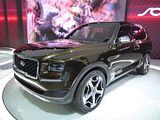
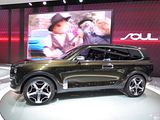
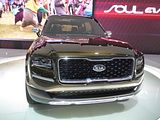
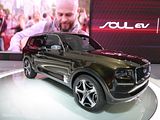
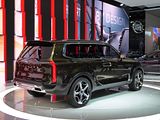
A hybrid you can buy now is the new Niro, which made its debut at the Chicago Show back in February. The powertrain consists of a 1.6-litre four-cylinder direct-injection unit delivering 103 bhp and joined with a 43 bhp electric motor. This results in a total of 146 bhp and 195 lb-ft and when sent through a six-speed dual-clutch transmission driving the front wheels, returns 50 mpg over the combined cycle, just shy of the Prius’ fuel consumption. Underpinning the Kia Niro is the same platform as the Hyundai Ioniq and to ensure it is as efficient to drive as possible, includes the firm’s Coasting Guide and Predictive Energy Control. This setup sees the navigation system and cruise control working in tandem to maximise efficiency by gathering information about topographical changes in the road and adjusting the car accordingly. Visually, the Niro is quite unassuming with simple curved lines across the front, down the sides and at the rear. These curvy elements are then offset with a number of sharper elements, like the fog light surrounds and silver trim found on the rear bumper. It is very much a car of our times and should sell well.
There were a number of examples of the big-selling Soul here, reflecting the updates made for the 2017 model year. Kia has refreshed the exterior look of the 2017 Soul range with redesigned headlights and fog lights, more dynamic-looking front and rear fascias and two new exterior colours among other changes. In addition, the Soul Exclaim has just received a significant boost, thanks to the addition of the company’s turbocharged 1.6-litre GDI engine under the bonnet. The new turbo engine offers 40 more bhp and 45lb-ft more torque than the naturally aspirated 161 bhp 2.0-litre found in the Soul Plus models, while being able to return a combined fuel economy of 28mpg US. The sportier new Soul is offered exclusively with a seven-speed dual-clutch transmission with Kia also adding several specialised trim and sportier features, including exclusive 18-inch wheels, red-accented body trim, chrome grille surround, unique Soul tailgate badge, and, for the first time on Soul, a dual chrome twin-tip exhaust.
Standard equipment includes leather-wrapped steering wheel, push-button start with smart key and an UVO32 infotainment system with e-Services with integrated Android Auto and Apple CarPlay. Kia will offer a 315-watt Harman Kardon premium audio system with eight speakers and an 8-inch touchscreen display as options. Other new options include Rear Cross Traffic Alert and Blind Spot Detection. Kia were also showing the Soul EV here.
Although a new Rio has been launched in Europe, there was no sign of it here, which means that the current models were still on show, though they were rather forlornly pushed out to one rather quiet side corner of the stand. Both Sedan and Hatch models were displayed.
There were plenty of examples of the rest of the saloon car range here, with the mid-sized Forte Sedan and Hatch joined by the Optima, larger Cadenza and top of the line K900.
Crossovers were represented by the Sportage, which was refreshed earlier in the year with a new model and the larger Sorento.
Final Kia here was the Sedona MiniVan. The latest generation propelled Kia back into contention in this sector of the market with a car which was at or close to the top of class in most respects. The Chrysler Pacifica looks likely to give it a harder time, though the Kiai will still score on value for money.
LAND ROVER
Whilst the I-Pace was attracting most of the attention on the combined Jaguar and Land-Rover stand, it was not lost on the show-goers that this was also their chance to see a new Discovery 5 up close, probably for the first time, ahead of a mid-2017 launch in the US market. The model will be known as the Discovery in America, even though its predecessors were called the LR3 and LR4, as Land-Rover tried to distance themselves from some of the reputational issues of the second generation Discovery. Looking very much like part of the family, the new seven-seater SUV brings some clever features in each roomy interior as well as some significant improvements over its ageing predecessor, mostly thanks to its modern aluminium architecture. This has allowed the new Discovery to drop around 480kg (1,058lbs) off its weight which combined with the modern engine range allows it to score better fuel economy and lower CO2 emissions. The cabin is said to offer room for seven adults, with Land Rover letting you fold the seats via a smartphone app, all the cubbies you could ask for plus the latest connectivity features, courtesy of the company’s InControl Touch Pro infotainment system. Customers in the US will get to choose between a supercharged 3.0-litre V6 petrol with 335hp and a 3.0-litre V6 diesel with 254hp, with Land Rover promising up to 14 percent better fuel economy for the petrol model. And because this is a proper Land Rover, the new Discovery comes with a 283mm (11,1 inches) ground clearance, with a maximum wading depth of 900mm (35.4 inches). A full suite of electronic systems are also present to help the new Disco to drive over the biggest off-road challenges. Making its debut here was the new Discovery Dynamic Design Pack which offers a stealth-like appearance as well as a host of exterior modifications. This optional pack is available on both HSE and HSE Luxury spec models, and is comprised of 21″ or 22″ Satin Dark Grey alloys, Black or Corris Grey contrast roof, as well as new front and rear bumpers. Additionally, the grille, fender vents, door mirror caps and vehicle script on the bonnet are all finished in Narvik Black. Inside, potential buyers can opt for a choice of three colourways, each featuring contrast stitching. Other changes within the cabin include the Titanium Mesh finish, Windsor leather upper fascia and door tops, plus dedicated carpet mats with Nubuck binding. In order to take advantage of their surroundings, Land Rover got surf legend Laird Hamilton and members of the Silicon Beach Surfers club to give the new Discovery their seal of approval, from a practicality and lifestyle standpoint. Pricing for the new Land Rover Discovery is set at $49,900 MSRP, with the first cars expected to hit the US showroom floors in mid-2017.
There was space on the stand for an example of all the other models in the range. That meant the Evoque including the recently released Cabrio, a Discovery Sport, the Range-Rover Sport and the full-on Range-Rover.
LEXUS
In order to celebrate the launch of the 2017 Lexus IS, the Japanese automaker joined forces with hot sauce maker Huy Fong Foods in order to bring the custom-built Sriracha IS to the Show. This concept was actually built by West Coast Customs with one goal in mind, which is “Making a Hot Car Spicy.” Among its special features, there is the hard-to-miss official Sriracha IS paint job, designed to mimic Sriracha sauce inside the bottle and topped with a clear coating. There’s also the Sriracha-Injected steering wheel, complete with a funny warning for “Hot Handling”. Other features include the custom temperature settings that now go from cool to Sriracha hot, the driving mode upgrade, handcrafted seats made out of plush leather and featuring the Huy Fong rooster logo, and of course the custom badging and green accents – where the latter are a signature element of official Huy Fong Foods products. These bottle-cap green details on the car include the spindle grille outline, the hand painted calipers, interior cabin mood lighting, chrome side view mirror accents and the hand-stitching on the seats. “The new Lexus IS is so hot, we decided to make it Sriracha hot, with all the custom details every Sriracha fan will appreciate,” said Brian Smith, Lexus VP of marketing. In order to go all the way with this project, Lexus even filled up the boot with 43 bottles of Sriracha for “emergency condiment situations” and build a key fob with an emergency chili button that dispenses sauce from a nozzle on the fob. Finally, among the car’s “accessories” are the hot driving jacket and of course the driving mitts – since the Sriracha IS is so hot, custom oven mitts are a necessity.
As well as the regular IS model, there were examples of the rest of the saloon range here. American buyers get an extra model with the ES which slots between the IS and the GS, based on the Toyota Camry. These two were joined by the entry level CT, and the upscale GS and LS models.
There are more Lexus SUVs as well, with the NX and RX which are familiar to Europeans joined by the GX and LX, both of which are Lexus-ised versions of the V6 and V8 LandCruisers that are sold elsewhere in the world.
Yet to go on sale is the new LC500 Coupe which was making another appearance here following its world premiere at the Detroit Show in January. The LC has its origins in the LF-LC study revealed in late 2011, and changes to that concept were kept to a minimum, a rarity for such an extreme design. Underpinned by the new GA-L platform it goes against the forced induction trend by using a naturally aspirated 5.0-litre V8 borrowed from the RC F and GS F. Its 467 nhp are sent the rear wheels via a brand new Aisin 10-speed auto transmission, making for a naught to 100km/h (62mph) acceleration of less than 4.5 seconds. Going after a pretty strong competition, it’s only natural to come with the latest tech that includes adaptive cruise control, collision mitigation and lane-keeping assist. The manufacturer will also allow prospective buyers to replace the standard panoramic glass with an optional carbon fibre roof.. The LC will also be available in a Hybrid version.
The RC was also here, in road-going guise and the Group 4 race car. This car promised much, as a rival to the BMW 4 Series, Audi A5 and C Class Coupe, but even assuming you can get past the looks – and many people, me included won’t do so – it is very portly and so with the exception of the RC-F, is not fast and it is apparently also rather stodgy to drive. Not really a rival to the German Coupes after all.
LINCOLN
The Navigator Concept was first shown at the New York Show in April, and it caused more than a few gasps. So when it made another appearance here, it was not quite a shock, even if it does appear massive, and rather ungainly, an impression probably exacerbated by those huge wheels and the gull-wing doors. The current Navigator, based on Ford’s Expedition, dates back to 2007, while certainly spacious and imposing, it has never really had the same stylish credentials as the Escalade, for example. However, if this concept will faithfully represent most of what we’ll see once the finished 2018 model arrives, the likes of Cadillac and perhaps even Land Rover should start paying attention. In front of the blue leather cabin with its six-seat configuration lies a 3.5-litre V6 EcoBoost engine, putting down more than 400 bhp. So forget about the custom wardrobe management system in the back, once this thing hits production, people will want to hear about numbers, aesthetics and on-board tech – where we can expect systems such as Pre-Collision Assist with Pedestrian Detection, a 360-degree camera and an enhanced parking assist system. In terms of connectivity, the all-new Navigator should feature Wi-Fi and proper smartphone integration inside the cabin. All in all, this concept should help put Lincoln back on the map, after all, it’s only a matter of time before professional athletes take notice.
There was an example of the current Navigator on the stand, as well, so you could make something of a comparison.
The production models on show were all finished in the same rather agreeable shade of blue, but that did not make telling them apart that easy. The front end of the newly facelifted MKZ and the larger Continental are very similar (and look like someone copied a first generation Jaguar XF), and the Crossover Duo of MKC and MKX look not unlike each other from almost any angle.
MASERATI
The US is Maserati’s biggest market and so this car, which is expected to become the brand’s best seller is an important one, especially as the marque is looking to increase sales from 20,000 to 50,000 cars a year. It is the Levante, the fifth model in the range, and it went on sale here a few weeks ago. Unlike Europe where the focus is on a diesel powered version, American buyers get the choice of two models, both of them petrol powered. Prices kick off at $72,000 for the entry-level 350 bhp model, and rise to $83,000 for the 430 bhp Levante S. Both get a 3.0-litre bi-turbo V6 mated to an 8-speed auto that sends power to all four corners, and which allows for what Maserati refers to as “outstanding performances both on- and off-road”. The Levante has the lowest center of gravity in its class and it benefits from air springs on all wheels, with 5 different ride levels, a perfectly balanced weight distribution of 50-50 between front and rear, and a mechanical self-locking rear different, as standard. The SUV is equipped with a number of safety gizmos that include automatic brake assist, lane departure warning, forward collision warning, blind spot alert, and 360-degree camera view. Inside, there’s Maserati Touch Control infotainment system that works together with an 8.4-inch high-res screen and can be controlled via the rotary knob on the central tunnel.
Maserati took the wraps off the facelifted Quattroporte at the Paris Motor Show this past September, launching with it two packages that take the big, luxurious performance sedan in two different stylistic directions: GranSport and GranLusso. Now the Modenese automaker has brought the former to the US for the first time to debut on the floor of this Show. Where the the GranLusso takes a more elegant approach, as you might have guessed, the GranSport version is more aggressive, both inside and out. It features sportier-looking bumper vents front and rear, black rear spoiler, 20-inch alloys, red brake calipers, and blue emblems. The interior also boasts more heavily bolstered sports seats, a sportier steering wheel, aluminium shift paddles, stainless steel pedals… the works. These features are in addition to the upgrades fitted across the Quattroporte range. After three years on the market, the enhanced sedan features adaptive front aero, sharpened bodywork, upgraded infotainment, and additional safety systems. Buyers will be able to specify the GranSport or GranLusso on the base Quattroporte S, starting at $103,400 with a 3.0-litre twin-turbo V6 rated at 404 bhp; on the all-wheel-drive Quattroporte S Q4 (from $109,500); or the top-of-the-line Quattroporte GTS with its 3.8-litre twin-turbo V8 good for 523 bhp, priced from $145,500.
Also on show were examples of the Ghibli and the two-door GranTurismo.
MAZDA
Star of the Mazda stand was the all-new CX-5, which proved an interesting contrast with the current CX-5 which happened to be the rental wheels which I had used to get to the Show. When you compare one against the other, they are really quite different, despite what you might have thought from a quick glance at the launch photos. The new model, unsurprisingly, takes much of its styling inspiration from the smaller CX-3 and larger CX-9 with Mazda saying that it wanted to create a vehicle that suited the phrase ‘refined toughness’. As such, the front of the new CX-5’s body is now 10 mm wider than previously and helps to give the car an improved stance on the road. Additionally, the A-pillars have been pushed back by approximately 35 mm and a new grille has been adopted. Other key design updates include thinner headlights and taillights and an overall sportier appearance, aided particularly through the re-designed roofline and sharp C-pillars. The interior of the new CX-5 has also been suitably refreshed and revised and incorporates a three-spoke steering wheel, push-button start and a 4.6-inch colour display within the instrument cluster. There’s also a 7-inch display now resting on top of the dashboard, similar to most current Mercedes-Benz models. There’s also a 10-spoke Bose premium sound system and the Mazda Connect connectivity system which works in conjunction with smartphones. While engines will differ between markets, Mazda says the new CX-5 will receive its clean, 2.2-litre SkyActiv-D diesel engine and the SkyActiv-G 2.0 and SkyActiv 2.5 direct-injection petrol engines. All of these engines can be mated to either a six-speed automatic or six-speed manual transmission. As standard, they are front wheel drive but the brand’s all-wheel drive system is available. Another highlight of the new model is that the strengthened chassis has resulted in a 15.5 per cent increase in torsional rigidity over the outgoing model. This is largely due to the increased use of ultra-high-tensile steel on the A-pillars and B-pillars. The improved aerodynamics of the new model also lower road noise by around 1.3 dB over rough surfaces. On a technology and safety front, the 2017 CX-5 includes Mazda Radar Cruise Control and Traffic Sign Recognition which is able to read speed limit and other road signs and display them on the 4.6-inch display. What’s more, the new model includes a torque vectoring system where torque levels can be altered based on steering wheel inputs, aiming to both improve the ride and great handling abilities. Pricing and availability details will be released in the coming weeks.
The MX5 RF, or rather Miata, to American buyers, and a race version were also in a prominent place on the stand.
There were examples of the rest of the range here, too: the 3, in hatch and sedan guises, the 6 and the three crossovers, the CX-3, current CX-5 and recently launched second generation CX-9.
MERCEDES-BENZ
Mercedes had a large stand, right next to arch-rival BMW, as is usually the case at this Show, and there was plenty that was new to see.
There was plenty to see of the very top of the range, the still expanding AMG GT family. There is a new flagship version, the Mercedes-AMG GT R, to give it is full and rather cumbersome title. It is every bit as impressive and aggressive as the German automaker has hinted that it would be. To start off, it’s 90 kg (199 lbs) lighter than the AMG GT S, meaning it weighs just 1,554 kg (3,428 lbs). Its 4.0-litre biturbo V8 engine now puts down 585 PS (577 HP) and 700 Nm (516 lb-ft) of torque, which is a much needed bump in power considering the competition. The seven-speed dual clutch gearbox has also been tweaked to deliver faster shifts, helping the car get from 0 to 100 km/h (62 mph) in 3.6 seconds, before maxing out at 318 km/h (198 mph). This makes it faster than the GT S by 8 km/h (5 mph) and quicker off the line by 0.2 seconds. However, it’s not just about straight line speed when it comes to this car. After all, Mercedes-AMG engineers didn’t do all those rigorous tests at the Nurburgring just to have the GT R win some drag races. Visually, it all starts with the stance, which is a lot more aggressive now – something even Lewis Hamilton noticed as he was bringing the car out during its official unveiling at the Goodwood Festival of Speed. The body kit is partly inspired by the AMG GT3 race car, as is the new vertical slatted grille. Also noticeable are the chunky air intakes, the large rear wing, double rear diffuser and the new lightweight 10-spoke 20″ forged wheels, wrapped in grippy Michelin Cup 2 rubber. Mercedes has also given the AMG GT R an all-new active aero profile in the underbody, concealed almost invisibly in front of the engine. When in RACE mode, a carbon component weighing just 2 kg (4.4 lbs) automatically moves downward by about 40 mm (1.5 in) at speeds of over 80 km/h (50 mph), changing the airflow considerably. The result is that front-axle lift is reduced by around 40 kg (88 lbs) at 250 km/h (155 mph). Also, the new AMG GT R is now better when cornering at high speed and exhibits superior directional stability compared to the previous AMG GT S flagship. Its new three-mode adaptive suspension setup was specifically designed to aid the car when out on the track. One of the true surprises with the AMG GT R is its Active Rear-Wheel Steering system, turning the rear wheels in the opposite direction to the ones at the front up to 100 km/h (62 mph) and then in the same direction if the driver accelerates any further. Speaking of “further”, there’s even a new 9-way traction control system where those behind the wheel can make minor adjustments to the level of slip. Inside, the GT R comes with manually adjustable AMG sports bucket seats, upholstered in nappa leather. They’re very light and offer necessary lateral support even in extreme driving manoeuvres, according to the German automaker. Other details include yellow contrast stitching, yellow seat belts, gloss black trim and the AMG Interior Night package as standard (gloss black shift paddles, steering wheel bezel, door sills and boot cross member). Finally, the AMG GT R’s specially developed exhaust system sounds absolutely bonkers. Of course, what we call “bonkers”, Mercedes calls a “genuine race car sound”, but either way you should watch the video and hear those amazing crackles whenever Lewis Hamilton (he was behind the wheel) lifted his foot off the throttle. The noise depends on what the exhaust flaps are doing, which can be open and closed depending on the selected AMG DRIVE SELECT mode – as well as controlled individually using a separate button. You’ll need to have the car in Sport Plus or RACE mode in order to get it to sound like the “Green Hell Beast” Mercedes designed it to be. The new Mercedes-AMG GT R goes on sale on in the US on November 21st 2016, some months before its European market launch scheduled for March 2017, which shows where Mercedes think the customers are going to come from.
Joining it were the racing version of the car and the GT C Roadster which was revealed a few weeks earlier this year at the Paris Auto Show, and was now making its North American debut. The open-top, high-performance Merc features a fabric roof, which opens or closes at the touch of a button in 11 seconds. It’s operable at speeds of up to 32 mph (50 km/h) and comes in three colour choices: black, red and beige. The Mercedes-AMG GT C Roadster was developed as the range-topping member of the AMG GT convertible family, and benefits from some of the features found on the hardcore AMG GT R, such as the electronic locking differential and rear axle steering. Propelling it from rest to 62 mph (100 km/h) in 3.7 seconds and up to a 196 mph (316 km/h) top speed is a 4.0-litre, twin-turbo V8 engine, which, in this application, is good for 550 bhp and 502 lb-ft of torque.
Also marking its debut here was the top of the new E Class W213 range, the latest A MG E63 and E63S, with the latter being the most powerful and fastest E-Class of all time. The duo of new AMG E63 sedans have dropped the outgoing models’ 5.5-litre twin-turbocharged V8 for AMG’s smaller displacement, but more potent, 4.0-litre force-fed V8, and now get standard 4MATIC four-wheel drive across the range. In the base E63, the eight-cylinder lump churns out 563hp (571PS) and 553 lb-ft for a 0-60mph in 3.4 sec, while in ‘S’ guise, it produces 604hp (612PS) and 627 lb-ft allowing Merc’s M5 rival to reach 60mph in 3.3 sec. Both models have a restricted top speed of 155mph, though the available AMG Driver’s package raises the limit to 186mph. If for any reason you want to show your frugal side by cutting down on fuel consumption, the new V8 can be turned into a four-pot via the cylinder deactivation system that’s available in the “Comfort” transmission program the between 1,000 and 3,250 rpm. A standard nine-speed Speedshift MCT (Multi Clutch Technology) automatic transmission with steering wheel paddles channels power to all four wheels. While Mercedes doesn’t offer the option of a rear-wheel drive only model anymore, the E63 S 4MATIC does come with a special ‘Drift Mode’ feature that delivers power exclusively to the rear wheels as standard. The mode is activated in the “Race” drive program using the shift paddles, provided that ESP is deactivated and the transmission is in manual mode, and it remains engaged until the driver deactivates it again. Predictably, AMG has made all sorts of upgrades to the E63’s chassis, which include a specially tuned Air Body Control system, new suspension parts on both ends, a mechanical rear differential lock, three-stage ESP, and an electromechanical speed-sensitive sports steering. Stopping power comes courtesy of a high-performance braking system with 360mm discs sporting six pot calipers up front and 360mm discs with single pot calipers at the back for the E63, and larger 390mm front discs for the ‘S’. Optionally, Mercedes offers ceramic carbon discs measuring 402mm up front and 360mm at the rear. You’ll be able to tell the E63s apart from their lesser E-Class siblings through the model-specific front grille, bumpers, extended wheel arches that house 19-inch rims (the ‘S’ gets 20-inch wheels), four-pipe exhausts and a discrete rear spoiler, with AMG also spiffing up the interior with unique trims. After its LA show debut, the new E63s will go on sale next March in Europe and from the summer of 2017, in North America. An estate version will be introduced next year.
Yet another new model was the third Mercedes-Maybach to be produced since the Maybach label reappeared as an adjunct to Mercedes rather than a completely separate brand. This one, the Mercedes-Maybach 650S Cabriolet is designed to challenge the industry’s luxury heavyweights. Watch out Bentley and Rolls Royce. In this era of mobility and alternative fuels, the new Mercedes-Maybach S650 Cabriolet seems like a dinosaur – and that’s what makes it unique and intriguing. It’s “old money” style is reminiscent of Merc’s golden age when the German car maker offered more exclusivity. Under the bonnet lies the AMG-sourced, 6.0-litre twin-turbo V12, capable of delivering 630 PS (621 hp) and 738 lb-ft of torque, making it the ultimate S-Class Cabriolet. The new Maybach S650 pumps up the already luxurious S-Class cabriolet with little effort, adopting small but effective upgrades that include an array of Maybach badges, plush new seats, quad tailpipes, a newly-designed set of wheels, and an updated front bumper. The rest is pure Mercedes, but the car maker reckons that’s enough to make it a special limited edition model, with only 300 units slated for production – 75 of which will be reserved for the United States. Although prices weren’t released for North America, in Europe the model will have a starting MSRP of around €300,000.
The entry level CLA250 made quite a splash when it was launched in the US, with a headline price of “under $30,000”, though few would have been sold for so little cash, as the price was $29,995 for the bare bones model with no options and no choice of colour. The press were less impressed, giving it some very ho-hum reviews, which seem not unfair to me, as this is a car that I really struggle to like. Access to the rear seats is laughable, and if you do manage to get in there, you will be desperately uncomfortable, as despite the front wheel drive packaging advantages that should exist, the styling throws these all away. The quality is very iff-y as well. I drove the CLA 45 AMG version the day before coming to the Show, and I can add a long list of other things that disappointed or annoyed me. Not a nice car, even if in AMG form it is a fast one.
The larger C Class was represented by a C63AMG Coupe, the recently launched Cabrio and one of the hybrid C350e saloons.
Look long and hard and you could probably tell these as E Class models rather than C or S Classes, though they clearly do show evidence of “photocopier enlarge and reduce” styling. Saloon and Estate models were on show.
Also present was a CLS as well as an S Class Saloon and Coupe.
Representing the sports cars was this SLC, the new name for the car formerly known as the SLK.
From the Crossover and SUV part of the range, there were GLA and the larger GLC and GLC Coupe models present.
As well as the regular GLE model, Mercedes were also debuting the new AMG GLE43, a performance-oriented variant of this full-sized SUV set to replace the GLE 400 by early 2017. The new GLE model is the ninth AMG 43 model in the Mercedes range, as the company unfolds its plan to expand the AMG portfolio. Powered by a biturbo 3.0-litre V6 unit, the new GLE 43 offers 362 bhp and 384 lb ft of peak torque, sent to all four wheels via a nine-speed 9G-Tronic automatic transmission. “The expansion of the AMG lineup underscores the ongoing demand for performance-oriented vehicles, especially for SUVs,” said Branden Coté, AMG Manager. “AMG is well-positioned in the US marketplace due to our nine new AMG 43 vehicles, four of which are performance-oriented SUV models. We will continue to build the AMG brand and portfolio in 2017 with more variants such as the model year 2018 AMG GT R and the GT/GT C Roadsters.” AMG, which is going to celebrate its 50th anniversary in 2017, created the 43 model line-up for customers that want a sportier driving experience but don’t necessarily need the high-end performance figures of the 63-series models. The new Mercedes-AMG GLE 43 also comes with a host of AMG-tuned features specifically for the occasion, including the steering, braking system, the sports suspension and the throttle mapping. Along with comfortable seating for five and plenty of space in the cabin, the new GLE 43 now features the AMG Dynamic Select System with five different driving modes – Comfort, Sport, Sport+, Individual, and Slippery. Each one of them alter parameters like suspension stiffness, transmission shift points, throttle mapping and idle speed to fit any condition.
Sitting above the GLE in the range is the GLS, the new name for the massive 7-seater GL and there was one of these machines on the stand.
Final machine on the stand was the G550 4×4². After thinking about it for a year, Mercedes-Benz have taken the decision to bring their rugged G550 4×4² to the States, starting from early 2017. They haven’t announced pricing for the US market yet, but over in Europe, where it’s sold as the G500 4×4², it costs €125,000 more than the plain G500 and €44,000 less than the G65 AMG, so given that the respective prices of those two models here in the States stand at $119,900 and $217,000, it should carry an MSRP of under $200,000. A shorter cousin of the beastly G63 AMG 6×6 (never officially sold in North America) with two less wheels, Mercedes claims that the 4×4² “is the most capable G-Class ever”, thanks to the innovative portal axles that allow for axle input and the wheel center to be two drastically different heights, the three locking differentials and a ground clearance of more than 17-inches. It’s debatable whether buyers who fork out $200k will ever truly take advantage of the G550 4×42 off-road skills, including the ability to move forward even if only a single wheel is able to gain traction, or if it will merely tackle valet parking lots and high-end restaurant curbs. For power, the G550 4×4² borrows the new G550’s a 4.0-litre Biturbo V8 kicking out 416hp and 450 lb-ft of torque, paired to 7G-TRONIC PLUS seven-speed automatic transmission. Some of the additional features over the G550 include the side-underbody exhaust pipes, the widened tracks and wheel arches on all four corners, and 22-inch wheels.
MINI
MINI have scaled back on the Auto Shows that they will henceforth attend, so when they launched their second generation Countryman last month, it was not at the Paris Show, as you might expect, as they were not there, but on-line. so this was the first chance for people to see it in the metal. The biggest MINI to date, the styling is a careful evolution from the first generation car, so you will have to look at it for long enough to be sure you are looking at a new one. Many of the same engine options are present here as were available in the outgoing model, but joining them is the Cooper S E Countryman All4, the brand’s first-ever hybrid car, as well as the most affordable member of the family, the Cooper Countryman. It utilises a 1.5-liter, three-cylinder petrol engine, producing 134 HP (136 PS) and 162 lb-ft of torque. Until the JCW (John Cooper Works) model joins the lineup next year, the current range-topper is the Cooper S Countryman, with a 2.0-litre, four-cylinder petrol burner, rated at 189 HP (192 PS) and 207 lb-ft (280 Nm) of torque. This version needs 7.3 seconds to go from 0 to 62 mph (100 km/h) with a six-speed manual gearbox, 7.2 seconds with an automatic, and 7.0 seconds with the optional all-wheel drive system. In markets outside the US, consumers get a couple of diesel-powered models as well – the Cooper D and Cooper SD, with the former good for 148 bhp and 243 lb-ft of torque, while the latter has 187 bhp and 295 lb-ft of torque. The crossover is underpinned by the BMW Group’s UKL2 platform, which is shared with other models made by the two brands. It’s also significantly larger over its predecessor, a move that places it across the BMW X1, Mercedes-Benz GLA, and Audi Q3.
MINI launched the second generation Clubman a year ago and as expected, the six-door model has now been given the Works treatment to bring it in line with the other members of the burgeoning BMW division. The Mini John Cooper Works Clubman, announced at the Show, will join the hardtop, convertible and Countryman models in getting the hotter engine and more aggressive styling befitting of Minis top performance models. But in the Clubman’s case, it gets standard all-wheel drive (All4 in Mini-speak) to go with the latest 2.0-litre turbocharged four-cylinder that puts out 228 bhp and 258 pound-feet of torque. According to the company, the Works Clubman is capable of 0-100 km/h (62mph) in 6.3 seconds with either the standard six-speed manual or optional 8-speed automatic. Brembo brakes, a sport exhaust system and lots of Works badging is also part of the package. Inside, the Works Clubman also gets the more aggressive racing seats found on other hot Minis. It is not going to come cheap.
Also on the stand were examples of the rest of the range, with the 3 and 5 door versions, the latter known in the US as the Hardtop and the open-topped Cabrio joined by a regular Clubman.
MITSUBISHI
Probably the most interesting thing to see on the Mitsubishi stand was this, the eX Concept. This was first seen in Japan in late 2015 at the Tokyo Show that year, and it made appearance at a number of other shows in 2016. The sub-compact SUV concept is tipped to eventually morph into an EV by the end of the decade as a rival to the Nissan Juke, slotting just below the Mitsubishi ASX. Although it remains unclear how much of the design will be retained for the production model. As with the initial concept from Tokyo, this one is painted in the same bright shade of electric yellow and features an edgy design highlighted by the bold front-end which Mitsubishi dubs the ‘Dynamic Shield’.
The rest of the range were represented. The Mirage was facelifted for 2016, with new grille and an improved interior, as well as with the addition of a 3 box saloon version which is called the G4 in America (the Attrage in other markets). I had the misfortune to drive one of these cars earlier in the year. Unimpressed does not even get close to describing what I thought of it!
The other models on show are even older: the iMIEV and Lancer are among the most venerable designs still in production, and these were joined by the Outlander Sport (ASX to Europeans) and the Outlander.
NISSAN
Probably the most significant introduction on the Nissan stand was the revised Rogue, which arrives just in time for the crossover’s three-year mark since its introduction in the autumn of 2013. It brings mild cosmetic updates, content enhancements, but more importantly, the addition of a hybrid model to what is now Nissan’s best selling model in the US market. Available for the first time as a hybrid in both front- and all-wheel drive applications, the 2017 Rogue Hybrid pairs a 2.0-litre four-cylinder petrol engine to an electric motor and Xtronic transmission, with a compact Lithium-ion battery located under the boot, which Nissan claims maintains its flat rear floor for easy passenger access to the rear seat and little reduction of cargo room. The hybrid system delivers a combined 176hp from the 141hp and 144 lb-ft 2.0-litre unit and 40hp and 118 lb-ft of torque from the 30kW electric motor. The front-wheel drive hybrid model is said to return an EPA estimated 33 mpg city, 35 mpg highway and 34 mpg combined, while the AWD version drops to 31 mpg city, 34 mpg highway and 33 mpg combined. The regular 2017 Rogue carries over the previous 2.5-litre four-cylinder petrol engine, unchanged at 170hp and 175 lb-ft. Exterior revisions for the mid-cycle update focus on the two ends, with the front gaining new headlamps and a more pronounced, Murano-like ‘V-motion’ grille together with a redesigned bumper sporting rectangular fog lights, and the rear, revised taillights with boomerang-styled LEDs. There are also new chrome side mouldings, three additional exterior colours and redesigned 17-inch, 18-inch and 19-inch wheels. On the inside, Nissan gave the 2017 Rogue a sportier looking steering wheel and sport-mode shifter, a subtly revised front centre console, new trim pieces and upholstery (both cloth and leather), plus additional optional and standard kit. The Japanese carmaker also improved the Rogue’s safety equipment with Lane Departure Warning (LDW) and Lane Departure Prevention (LDP), adaptive cruise control (ICC), and Forward Emergency Braking with Pedestrian Detection. The model goes on sale later in 2017.
As well as the regular model, Nissan had a special display of the car which they hope will turn Star Wars fans into Rogue SUV fans with the Nissan Rogue One Star Wars Edition. Debuting at the Show, Nissan is promoting the connection with the upcoming Rogue One: A Star Wars Story, if in name and limited edition badging only. All of the 5,400 of these Rogues for the U.S. and Canada are based on a Rogue SV with other options included, such as a sunroof and upgraded Bose audio system and will be offered with front or all-wheel drive. They also add Star Wars and “Galactic Empire” badges inside and out. Black or white are the only colours offered. Oh, and this special model also includes a full-sized Death Trooper helmet. No word on whether it’s one of the safety features of the Rogue. The whole package adds $1,990 to the equivalant non-George Lucas themed 2017 Nissan Rogue.
Also receiving a mid-life update was the Versa Note. Highlighted by a new front end that moves it closer to the Sentra, Altima and Maxim from a visual standpoint, the 2017 Nissan Versa Note S, SV and SL grades also get a sporty rear fascia that was previously available on the SR, along with two new exterior colours – Monarch Orange and Deep Blue Pearl. Additionally, the new model also benefits from revised 16-inch alloy wheels for the SL trim level, and inside, larger cup holders, and a second 12-volt outlet for the SV, SR and SL trims have been added, while the first outlet and USB port have been relocated to the front of the centre console. Power across the range is provided by a 1.6-litre DOHC, 16-valve, four-cylinder engine, mated with a next-gen Xtronic transmission.
Alongside the regular Sentra sedan, an example of which was on show, there was the new NISMO version, revealed at the Show. The 2017 Sentra Nismo packs a 1.6-litre turbo four. It employs 16 valves, dual overhead cams, direct injection, variable valve timing and oil pressure, and spray-coated and mirror-finish cylinder bores to deliver 188 horsepower and 177 lb-ft of torque. Those are the same exact specs as the Juke Nismo, but unfortunately fall short of the more potent, 215-horsepower Juke Nismo RS. Adequate or not, the muscle is transmitted to the front wheels through either a six-speed manual or a continuously variable transmission. The suspension is made up of independent struts up front and a torsion beam out back, with stabilizer bars at both ends and monotube rear shocks. It’s been recalibrated by Nismo, along with the electronic power steering system and upgraded front brakes. The whole thing rides on 18-inch alloys, which complement the enhanced appearance and aero package. There front, rear, and side panels have been upgraded to not only give it a more aggressive look, but reduce lift by 30 percent at the rear end. Black and red trim help reinforce that this is no ordinary Senta, helped by the proliferation of Nismo logos inside and out. The performance treatment continues inside with better-bolstered front seats, leather- and Alcantara-wrapped steering wheel, and more. Red-trimmed charcoal is the only color in which the interior is available, while buyers will be able to choose between silver, dark grey, black, or white. No performance figures and pricing/availability information were released, but it is already clear that the 2017 Nissan Sentra Nismo is already looking down on power compared to prospective rivals like the new Hyundai Elantra Sport – let alone benchmark hot hatches like the Ford Focus ST and Volkswagen Golf GTI. If Nissan can get the price down below, however, the Sentra Nismo may open up a new class a step below to bridge the gap.
These four established models were showing no significant change for 2017: the all-electric Leaf, the family-sized Altima and the third generation Murano and latest Pathfinder.
The sports cars were not forgotten, with the 370Z and GT-R both on show.
POLARIS
I knew what this was, having come across one at Prescott and had a long chat with the team that brought it there. It is a Polaris Slingshot, and I’ve now see a few of them on the roads of California and Arizona. It was introduced in 2014 as a 2015 model by Polaris Industries, who claim “It’s a three-wheeled motorcycle!” It has a tilt-adjustable steering wheel, side-by-side bucket seats, and does not lean on cornering. Three-point seat belts are fitted, however it has no airbags or crumple zone, and driver and passenger must wear motorcycle helmets in certain jurisdictions. It has no roof, doors, or side windows. A small windscreen is an optional extra on the base model, and fitted as standard on the SL model. Steering wheel, gear stick, and brake, clutch, and throttle pedals have a conventional automobile layout. The Slingshot has a 2.4 litre 4 cylinder Ecotec engine, as formerly used by GM in the Pontiac Solstice and Saturn Sky sports cars. It is connected to a 5 speed manual transmission. The standard Slingshot has two 17″ front wheels and a singular 18″ wheel in the rear of the vehicle, while the Slingshot SL and SL LE Edition have two 18″ Forged Aluminium front wheels with a 20″ rear wheel. All models have a Double-Wishbone Front Suspension with a Sway Bar to control the front end. It weighs 1,743 pounds (791kg).
PORSCHE
As ever, Porsche had a hall all to themselves. This is off to one side of the concourse that runs from the West entrance to the West Hall. It usually gets very busy, so I made it my first stop on entering the Show. There seemed to be fewer cars in than sometimes, when they have really been packed in, and there were also fewer people, so it was not so hard to get to see the cars and get photos. That most of them were locked probably helped.
Star attraction here, of course, was the new second generation Panamera, which was making its US debut. As is usually the case at Porsche, the range is gradually being built up, so there were some new versions which had not been seen globally beforehand, and these included the LWB model and the V6 petrol cars. The new models, therefore, start off with the entry level Panamera and Panamera 4 variants. Both utilise a new 3.0-litre turbocharged petrol V6 delivering 330 PS (326 hp) and mated to an eight-speed dual-clutch transmission. As the name implies, the Panamera 4 is all-wheel drive while the standard model sends power exclusively to the rear wheels. Despite being smaller than the outgoing 3.6-litre V6, this new turbo’d six is 20 hp more powerful and 13 per cent more fuel efficient. Also making its debut was the new Panamera Executive range. These model have had their wheelbases stretched by 150 mm, helping to increase space for rear passengers. Alongside the added space, they come standard with heated seats, a large panoramic room, front and rear adaptive air suspension and Porsche’s Active Suspension Management system. Additionally, there’s a roll-up sunblind behind the rear headrests that comes standard. Alongside the base Executive models installed with the new 3.0-litre turbo six, there are also Panamera 4 E-Hybrid Executive, 4S Executive and Turbo Executive variants available. The higher-end 4S Executive and Turbo Executive include added features like soft-close doors and rear wheel steering. Also found within the Turbo Executive are LED headlights, a four-zone climate control system and ambient lighting. All Porsche Panamera Executive models can be fitted with a newly designed rear centre console that can be equipped with two integrated folding tables. Rear passengers may also enjoy the optional Porsche Rear Seat Entertainment suite which includes 10.1-inch displays integrated into the backrests of the front seats. There is general agreement that the new model looks a lot less awkward than its predecessor, especially from the back. It is a technical tour de force, and by all accounts even more impressive to drive than the old car was. I look forward to finding out for myself.
The revised 4 cylinder 718 Boxster and 718 Cayman models went on sale in the US earlier in the year, following their European debut some months back and there was one example of each here, a regular Boxster and a Cayman S.
From the cast range of 911 models that Porsche offer, there were just three examples on show, including a 911 Turbo Cabrio and a Targa with the amazing roof system that is like a piece of theatre to watch when it is in action.
Porsche also used the show to reveal their new 911 RSR, the ultimate track weapon for their 2017 racing season. The latest version of the 911 racer has been completely rebuilt so as to exploit fully the Le Mans GTE regulations, with only the door handles carried over. GTE homologation rules dictate that the car must be closely based on a road-going car, and this car fully complies with that, which will probably surprise many people as the 4 litre naturally aspirated engine which powers it has been positioned to be in front of the rear axle, making this a mid-engined 911. Porsche will not have to produce mid-engined road cars as part of homologation. The whole car is everything you expect from a racing Porsche and then some. It has been tested over 200,000 miles during the course of 2016, so you can tell Porsche are serious in their intentions with the car. It comes in a lightweight package. The all-new engine naturally aspirated engine develops 510 PS (502 bhp), and is connected to a six-speed gearbox with magnesium housing and paddle shifters. It is apparently very fuel efficient, thanks to its direct fuel injection and rigid valve drive. Porsche say that this is the the biggest evolution in the history of their top GT model. Absolutely everything on the 911 RSR is new, as the suspension, body structure, aerodynamics, engine, and transmission have all been developed from scratch. What’s more interesting is that, for the first time, the race car features state-of-the-art assistance systems, including a radar-supported collision warning system which detects faster LMP prototypes even in no light conditions, so that unwanted occurrences can be avoided. Moreover, a new safety cage concept has been implemented, as well as a rigidly mounted racing seat fixed to the chassis. While based on the 991’s factory design, the RSR gets a more bloated appearance to accommodate the various oversized race-spec components. With this change, the new 911 RSR also became more serviceable, as entire carbon-fibre body elements can be exchanged completely in a very short time thanks to quick-release fasteners. Don’t be surprised if some of these advances appear on the next generation 911 which is under development, for launch in a couple of years.
There was just space on the stand for examples of what in many ways are the most important cars in the Porsche range. Don’t groan, but the SUV duo of Macan and Cayenne are their best-selling models, and are highly profitable, which means that Porsche can afford to do cars like the 911 RSR.
RAM
There were several example of the tough 1500 and 2500 trucks here. These are the most important products in FCA’s US line-up, as they outsell any of their cars, and lose out only to the Ford F150 and Chevrolet Silverado in total monthly sales.
Prior to the Show opening its doors, Ram unveiled two limited-edition variants of the 1500 pickup truck. The first of the two is dubbed the 1500 Rebel Mojave Sand, restricted to just 1,500 units. The name Mojave Sand refers to the exterior paint colour and the model also includes matte black decals on the hood. Inside, the Mojave Sand edition includes an all-black interior. The package can be purchased at $595 and can be optioned to any Rebel 1500 fitted with either the 3.6-litre Pentastar V6 or 5.7-litre HEMI V8. As for the Ram 1500 Ignition Orange Sport, it revives the name first introduced in 2015 as a different special edition Ram. The 2017 model is finished in a new shade of orange and also receives black graphics across the bonnet, black wheels and some black exterior trim. The interior then comes complete with orange and black seats, orange Ram logos on the headrests and orange contrast stitching. Like the Mojave Sand, just 1,500 units of the Ignition Orange Sport will be produced but it will only be available with the V8. Prices for the Mojave Sand start at $46,910 while the Ignition Orange Sport will set back customers at least $45,060.
Also on show were the RAM versions of a number of vehicles familiar to Europeans with Fiat badging them on them. These are the ProMaster and CityMaster.
SMART
Smart has had a far bumpier ride in the US than in other markets, with some very negative reviews published ever since the first cars arrived on American soil, and a US press and public who are fundamentally convinced that something this small cannot be safe no matter what its maker says. The car certainly did not find cult popularity unlike the MINI or Fiat 500. But they’ve not given up trying, so following the debut of the ForTwo (Coupe and Cabrio) and the ForFour’s pure electric debuts at the Paris Auto Show, the Daimler-owned car maker premiered these three models at this Show. The US market cars are the same as the European ones. That means a 60 kW (81 hp) and 118 lb-ft of torque electric motor, paired to a Renault-sourced, single speed fixed gear transmission that drives the rear wheels. Since there’s no need for any gear changing, the car simply changes the engine’s direction of rotation when “engaged” in reverse. The powertrain is capable of accelerating the ForTwo from 0 to 100 km/h (62 mph) in 11.5 seconds, the ForTwo Cabrio in 11.8 seconds, and the ForFour in 12.5 seconds. To help maximise efficiency, top speed is limited to 130 km/h (80 mph). Thanks to the 17.6kWh lithium-ion battery, the ForTwo Coupe offers a driving range of 100 miles, while the ForTwo Cabrio and the ForFour achieve 96 miles. For now, charging takes about 2.5 hours but from next year Smart will offer a powerful 22 kW fast charger that will juice up the vehicle is 45 minutes.
SPYKER
Displayed in the Galpin Hall was this Spyker C8 Preliator, a hand-built mid-engined 525hp sports car limited to just 50 units worldwide. It was unveiled earlier in the year at the New York Show, as historically, America has been a key market for Spyker, with half of its production being sold there. The new Spyker C8 Preliator uses an all-aluminium space frame while the suspension was tuned by Lotus. Power comes from an Audi 4.2-litre V8 which in this case has been supercharged for 525hp. Customers will be able to choose between a six-speed manual and a ZF six-speed automatic gearbox.
SUBARU
Star of the Subaru stand was the Viziv-7 Concept. Subaru haven’t had an entrant in the full-sized segment ever since they cancelled the Tribeca back in 2014, after an 8 year run. Now, there is a first glimpse at what should turn out to be a true successor to the Tribeca and it’s called the Viziv-7 concept, where Viziv stands for “Vision for Innovation”. In terms of size, this concept could fool you into thinking it’s a full-size SUV since it’s longer than a Range Rover and a Dodge Durango. However, its wheelbase is shorter, which means we’re technically looking at somewhat of a tweener – larger than your usual mid-size models, yet still dwarfed by something like an extended wheelbase Escalade. Overall, it measures 204.7 inches in length, 79.9 inches in width and 72 inches in height. Its wheelbase measures 117.7 inches, making the Viziv-7 some 15 inches longer than the current Outback. It’s also slightly longer, wider and taller than the VW Atlas, though their wheelbases are nearly identical. In terms of looks, the Viziv-7 concept boasts an imposing front grille, aggressive headlights and massive fog lights which are actually integrated within the wheel arches instead of the front bumper. The rear is rather more docile. Chances are that when this mares production, the final product will be toned down more than somewhat. And something like it is indeed tipped for production, with cars like the new VW Atlas in its sights, though it is likely to be confined to the US market. According to Car & Driver, the production version of this concept will be called ‘Ascent’, a name recently registered by Subaru with the US Patent & Trademark Office. The production car could arrive in the US sometime in early 2018, powered by a turbocharged four-cylinder engine – though an optional 3.6-litre six-cylinder boxer unit, as seen in top spec Legacy and Outback models, shouldn’t be out of the question.
Making a surprisingly low key appearance on the stand were the new fifth generation Impreza duo of hatch and sedan. The latest generation of Subaru’s smallest car were presented at the New York Show in April and are now going on sale. They will reach Europe in the fullness of time, though given the pitiful sales volumes that Subaru achieves in Europe, and the fact that they sell more models in America in a month than they do in Europe in a year, it is hardly a surprise that the US market is the first to see the car. Its looks are a fairly cautious evolution from the outgoing model, though they are a bit less awkward than that one was, and the car does have a higher quality interior, though it is still not going to trouble the best in class, by a long way. It will no doubt sell in quantity in America, especially in the Snow Belt, but it does not seem to have much that would compel a European to want one over a Golf, or Focus, or Astra or any number of other worth rivals.
The high end WRX and WRX STi cars which were based on the previous Impreza continue for now, though no doubt successors are under development. The stand included a WRX, a racer and a WRX STi Time Attack Car, reminder that Subaru has not completely given up on motor-sport even if they are long way from the glory days of Colin McRae and Richard Burns and the World Rally Championship.
Also on the stand were examples of the rest of the range: the Crosstrrek XV, Legacy saloon, Outback, Forester and BRZ sports coupe.
TOYOTA
Having shown a concept version of the C-HR at the last major US show, in New York, in April, where the stand staff flatly refuted the production prospects of the car, even though I repeatedly told them that I had seen it, launched in Geneva a few weeks earlier, lo and behold, the production C-HR was making its American debut here. The story being told here is that this would have been a Scion, had that brand still been alive, but as it is now, it will wear the Toyota badges that it will carry in the rest of the world. Slotting below the RAV-4 and set to take on the likes of Honda’s HR-V, the American market C-HR is essentially the same car as the one sold in the rest of the world, though American customers will only get it with a naturally aspirated 2.0-lirtr four with 144 bhp mated to a CVT transmission driving the front wheels, as opposed to the 1.2 turbo and hybrid versions which the rest of the world receive. The “compact” label is a bit of a misnomer, too, as actually the C-HR sits between sub-compact and compact crossovers. The CH-R will be available next spring in two grade levels. The base XLE comes with features like a dual-climate control, a seven-inch touchscreen display and 18-inch alloys as standard, while the XLE Premium adds a blind spot monitor and heated front seats, among others. Toyota stresses that both trims sport its Safety Sense P driver assist and safety suite that consists of a Pre-Collision System with Pedestrian Detection, Lane Departure Alert with Steering Assist, Dynamic Radar Cruise Control and Automatic High Beam. There were a couple of examples on show, mounted on turntables.
With the demise of the Scion brand earlier in the year, there are now two models that are called Yaris, and they are completely different. One is the familiar hatchback, whilst the other is the model which was launched as the Scion iA and is now called Yaris iA, and is actually a Mazda 2 with a separate boot and a different front end that only its mother could like. I’ve seen quite a few on the roads now. US customers don’t get the current generation of Mazda 2 (they got the last one), and by all accounts this is one of the best small sub-compact sedan cars, but that front end……… well, it seems to be something that Toyota are doing to all their cars, as the facelift to the Yaris Hatch a couple of years ago did not improve it, either.
There are two different Corolla models, now, too, as well, but these are both at least Toyota models through and through. The Corolla iM, which was also launched as a Scion, will look the more familiar to European eyes, as this is very similar to the Auris. Toyota promote this as sporty, which seems ironic to those who know the Auris, as it is about the least sporty car in its class. Mind you, the stand staff were prattling on about the regular Corolla Sedan and how sporty it is, too. Again, it is the least sporty machine out there, and its customers would probably want it no other way. Just because they’ve tweaked the appearance a bit and put a spoiler and some natty alloy wheels does not make the car remotely sporty to drive.
Although it is market supremacy has come under challenge in recent months, the Camry is still the best-selling non-truck in America in 2016,and so is an important car, no matter what you think of it, and there were several of them on display.
The largest Toyota saloon is the Avalon, which was transformed from a rather boxy and forgettable car in 2013 to a more swoopy and still rather forgettable machine. I drove one soon after it came out, and it was nice enough, and is certainly comfortable and quiet, but in this class, I would rather have a Chrysler 300C.
It is over a year since Toyota shocked us with the new look for the fourth generation Prius. Whilst that time has allowed us to get used to the goofy and gawky styling, I don’t think it has made it look any better. There’s now a Plug-in version as well, and this has different detailing at front and rear, which my common agreement is a slight “improvement”, but apart from the handful of people who like the styling because it is so zany, you are never going to choose one of either type of Prius because of its appearance!
There were also examples of the smaller Prius C and the larger Prius V (known to Europeans as the Prius +) on show. These models have never found anything like the popularity of the regular Prius.
Toyota’s hydrogen-powered Mirai has been out for a couple of years now, and you do see them occasionally on the streets of California. Again, very, erm, distinctive styling features. It lists for $57,500 in the US, which means that it is far from cheap.
Coming to LA having been seen at Paris and initially at the 2015 Tokyo Motor Show, was the Toyota FCV Plus Concept, which is even more futuristic looking. The first thing noticeable is the Jetsons-inspired body, but unlike the flying cars from the popular cartoon, this study touches the pavement with small wheels, cruising almost silently thanks to a fuel-cell powertrain and four independent in-wheel motors. Since hydrogen is the fuel of choice for setting the Toyota FCV Plus in motion, water is the only emission, but unlike other similar vehicles, this study can also generate electricity from the hydrogen stored outside, in addition to its own tank, and it can therefore be used as a stable source of electric power. Besides allowing users to put hydrogen to use in order to power their home, the FCV Plus can also be integrated into the local infrastructure, when it’s not used for transport, thus sharing its energy with the community. There’s no doubt that some of these technologies will be common sometime in the future, but until then, those interested in hydrogen-powered cars made by Toyota will have to settle with the Mirai, as shown above.
Toyota were also showing their iRoad vehicle here. This their view of the future of city cars and personal transportation. It was first shown in 2013, and a small number have now been produced. and are out on the streets, with a pilot project currently underway in Grenoble to gain experience from using this vehicle. It’s a cross between a moped and a car, with the innovative tilting drivetrain and rear-wheel steering key to its agility and the narrow 850mm width key to its credentials as a city runabout. What’s more, the i-ROAD is 2,350mm long, so you can fit four in a normal parking space. A lithium-ion battery drives two 2kW electric motors in the front wheels, giving a range of 31 miles and a 28mph top speed, with Japanese versions amped up to do 37mph. That doesn’t sound like a lot, but the i-ROAD still accelerates hard when you push the throttle. The amount of torque on offer actually lifts the body of this 300kg car so it apparently feels as though you’re flying rather than rolling. Turn the wheel and the i-ROAD swoops from side to side with a smooth and delicate motion. As you slow down, the rear steering quickens up so you have to get used to turning the wheel less for squeezing through traffic. It apparently takes some getting used to, but once you are, then it is surprisingly fun. I guess you could think of this a different approach to the same sort of problem that the Renault Twizy addresses. And it is similarly not cheap, though if volumes were to increase, the cost may well come down.
The three models in Toyota’s SUV and Crossover range were all here. The RAV4 was updated a year ago, and the Highlander has had the proverbial nip and tuck and some new engines for 2017, whilst the 4Runner received its bolder front end in changes made in 2014.
Across the back of the extensive stand were the latest Toyota trucks, the large Tacoma and even larger Tundra. Like all other trucks on the market, these have gone for a brash, vulgar and downright ugly look, with lashings of chrome on the front which certainly gives them presence. Look behind that, of course and you get something that is very practical and durable.
VOLKSWAGEN
One of the most popular cars at the Show was VW’s new full-sized SUV, the Atlas, which was making its world debut here. It is derived from the CrossBlue concept that first broke ground back in 2013. However, unlike the CrossBlue, the Atlas is a lot bigger and more substantial in appearance, and it has been conceived specifically for the American market, where products like VW’s Tiguan are deemed to be just too small. “Size does matter, especially for families,” says Klaus Bischoff, head of VW Design. “The first designs we showed were literally too small, too compact, designed too much out of a European perspective. We had to get used to the vehicle size that’s more appropriate for America. The roads are wider, the cities are bigger, and we grew into that. The fascial expression of a car defines its character. We wanted to give the car a wide appearance, and an earnest look. It should look substantial, without looking too aggressive.” This philosophy is apparently what drove the design team every step of the way. From the grille and the standard LED headlights to the stitching in the seats. It’s why the LED Daytime Running Lights were integrated into the grille itself. Overall, however, the look of the Atlas is meant to age well – and by well, that means not to go out of fashion in two or three years time. At least that’s what VW thinks. The clean yet overall, robust design also made its way into the cabin where the Atlas features a balanced and uncomplicated layout – not just for the dashboard, but for the software interfaces as well (like the available VW Digital Cockpit. Finally, in order to create a welcoming atmosphere inside, the Atlas design team actually drew inspiration from high-end furniture. It goes on sale in mid 2018, and judging by the interest the three cars on the stand were generating, could be everything the brand needs to make people forget all about Dieselgate (until the press and the lawyers whip up more frenzy about it, as they undoubtedly will do!).
VW announced updates for the Golf a couple of weeks before the show, and examples of this mild facelift were on show here, with particular focus being given to the electric e-Golf, being showcased for the first time at the LA Show. This model received the same visual updates as the rest of the range, including the revised lights all around and the new generation of infotainment systems with gesture control, but the real change happened under the skin. The old 24.2 kWh battery pack has been replaced by a bigger 35.8 kWh unit, enabling the new e-Golf to drive for longer between charges as it now features an increased driving range by 50 percent. This translates into up to 124 miles of travel on a single charge. VW has also added a 7.2 kW on-board charger as standard on selected trim levels, allowing the e-Golf to be fully charged in less than six hours at a traditional charging station. The company also offers the option of DC Fast Charging which can help charge the battery up to 80 percent within an hour at a DC fast charge station. In addition, the electric motor now makes 134 bhp, 19 bhp more than the outgoing model, and 214lb-ft of torque, up from the previous model’s 199lb-ft. The result is that the 2017 VW e-Golf now completes the standard 0-60mph procedure more than a second faster than its predecessor, requiring 9.6 seconds while the top speed is increased to 93mph. As well as the e-Golf, VW also displayed the latest Golf R and GTi as well as the Sport Wagon.
The Jetta remains VW’s biggest selling model in America. The current version has been around for several years now. This Mexican built model was deliberately made cheaper than the previous generation car, to try to increase sales, which worked, but over time, VW have refined it, adding back many of the features and perceived quality finish that they took away at launch.
As well as the regular Passat – an American designed and built one, don’t forget, which is different to the European ones – there was one with GT badges, which I rather assumed to be part of the range. It turned out not to be, and is actually a concept. Designed by VW’s North American engineering hub in Chattanooga, it is a preview of something the automaker considers adding to their line-up. Currently, the most powerful Passat US buyers can purchase is the V6 version with its 280 bhp 3.6-litre FSI VR6 engine. Curiously, it’s this exact engine that resides underneath the bonnet of the GT Concept, however, unlike the production car, the concept isn’t shy about letting you know of its intentions. It does this through its styling updates, which range from the Golf GTI-like black honeycomb grille insert with red accent lines, to the unique bumper treatments, black window surrounds, black roof & boot spoiler, LED headlights, smoked taillights, dual trapezoidal exhaust pipes and finally a sport exhaust. The 19″ Tornado wheels may not be larger than the ones you get on the regular R-Line model, but they do feature a more aggressive design that masks a set of sporty-looking red calipers. Inside, the carbon-fibre pattern door trim, two-tone black & grey sports seats with contrast stitching, black headliner and piano black centre console trim make for a very sombre cabin, yet that’s not necessarily a bad thing for a sporty saloon. Overall, you could say the GT Concept is nothing more than a Passat V6 with a GTI-like trimmings and accents over the regular R-Line kit. And while it would have made more of a splash if it packed north of 280 bhp, visual upgrades may prove effective in boosting its appeal.
Top of the VW saloon car hierarchy is the CC, as it is in Europe. The model range has been reduced somewhat for 2017, with just two versions available now, in anticipation of a replacement model arriving during the coming months.
Gone are the days when the Beetle is the year’s “must have” fashion statement like it was when the first New Beetle was launched. Sales are steady but not exactly stellar. VW introduced the Dune versions a year or so ago, to try to reignite some interest in the car, and whilst every change they have made is worthwhile, this remains a car with relatively minority appeal.
I was a little surprised to see this Tiguan, as the first generation model has been replaced in Europe. But not yet in America, as they still get it for the 2017 model year.
Joining it was the larger Touareg.
VOLVO
Volvo is one of a number of brands that declared a while back that they would be cutting down on the number of even the most globally significant Shows they would attend. Los Angeles is one of the ones they kept on their list, so you could be pretty confident that they would take the opportunity to bring something along for its world premier. And they did: the V90 Cross Country, the latest member of the 90-series model family, what the marketeers call their rugged all-weather derivative. It’s been almost 20 years ago since Volvo brought out the first Cross Country model, with the latest one tested in the harshest of conditions, ranging from the frozen north of Sweden to the searing desert heat of Arizona. Although Volvo did not release any technical details about the differences between the regular V90 and V90 XC models, it is clear that the new V90 XC offers more ground clearance, the bodywork features the traditional extra plastic cladding and that the all-wheel drive is naturally standard to all versions.
Volvo have said that they have been careful from the very beginning to ensure that the Cross Country concept was not just an exercise in rugged styling. They place high demands on real-world capability, and so they have added the comfort and convenience elements that Volvo drivers have come to expect. Most of the engines offered in the regular S90/V90 models are expected to find their way into the V90 XC. The model was joined by other examples of the S90 and V90 on the stand.
Perhaps slightly surprisingly, also making their US debut were Polestar versions of the established S60 and V60 models. These have been available in other markets for some time now, but Volvo US have clearly concluded that there is a market for the highest performing sportiest Volvo models currently made on American soil. The two Polestar models are currently the quickest cars of Volvo’s performance arm after receiving a powertrain update that had the old turbocharged 3.0-litre straight-six engine replaced by a twincharged 2.0-litre four-cylinder engine. Combining a turbocharger with a supercharger, the force-fed 2.0-litre engine produces in this case 362hp (367PS) and 347lb-ft of peak torque, 17hp more than the previous model but with 22lb-ft less torque as well. Polestar added a bigger turbo, a supercharger, new conrods, new camshafts, a larger air intake and a higher capacity fuel pump to augment the engine. An eight-speed Geartronic automatic gearbox is the only option, as is the AWD system with both of them updated by Polestar to match the dynamic character of Volvo’s spicy twins. 0-60mph comes in as little as 4.4 seconds, while the top speed remains limited to 155mph. Polestar also made the new models lighter than their predecessors, with Volvo claiming an overall reduction of 44lbs for both bodystyles and a 53lbs reduction over the front axle. At the same time fuel economy and CO2 emissions are improved, with the hot Volvo returning an EPA-rated 20 mpg city and 27 mpg highway (23 combined). The launch of the new Volvo S60 & V60 Polestar also marks the globalisation of the Polestar sub-brand, with Volvo expanding the number of markets where its high-performance models are sold from 13 to 47 and doubling the production volume from 750 cars a year to 1500. That said, Volvo has allocated just 200 cars for the Americas markets.
Final Volvo on show was the XC90, the latest version of which went on sale a few months back. This is also a really good looking car and it has been received to some very positive reviews.
THE KENTIA HALL
The Kentia Hall is down below the two main Halls, and is always the place to see the wackier content of the show. Stands in here are a mix of local traders and the after-market scene as well as few club-related displays. It’s not a part of the Show that I spend a long time looking at, as little of it is to my taste at all, but there were a few things that attracted my camera.
In some cases this is simply a chance to see further examples of some of the cars shown by the manufacturers upstairs, and that was the case for this relatively unmolested-looking Abarth 124 Spider, which was shown by 500 Madness, a local firm who have some very bold (and to my mind, often unspeakable!) things to Abarth 500s. They had some of those on show, and as you can see, the changes can be quite extensive.
The California Highway Patrol had a display which combined information and road safety advice with some historic vehicles from their heritage collection.
As the main supercar manufacturers do not have stands themselves any more at this Show, if you want to see Ferrari and Lamborghini models, you will need to come down to this hall. There you will certainly find them, though few, if any, are as they would have left Maranello or Sant’Agata da Bolognese.
If those were not customised enough, then look at these:
I’m glad there was a plaque on the stand to tell me what this is, as I had no idea. It is a Rhino GX, one of a small handful of terrifying beasts to come from USSV (US Speciality Vehicles) of Rancho Cucamonga, California, the company that converts ordinary pickup trucks into fearful antagonists of the highway. No, it’s not bullet-proof, despite what its looks might lead you to suspect. Indeed, when you first see it, you guess it just might be and maybe even bombproof, but for now, it is now. US Specialty Vehicles Llc, maker of this mutant, do have plans to partner with an upfitter to make armoured versions in the future, but right now Inland Empire Ninja assasins could get you, despite what the Rhino GX looks like on the outside. It looks like it could take a hit from a TOW missile, chew it up and spit out the warhead. The company made Lincoln stretch limos for 18 years, but now, 80 percent of the limo business is SUVs. Which is not exactly the market at which this vehicle is aimed. They point out that it is not a limo. It is wider inside; with a lot more room; it’s a beast of a truck but it’s luxury in concept. US Specialty Vehicles started building these three and a half years ago for the Chinese market. When USSV stopped in, they were making 10 or 11 of them a month, eight of which were going to China. But they’re going to make more for the U.S. (including a smaller Wrangler Unlimited-based Rhino XT). USSV has a large building way out east in the Inland Empire an hour’s drive toward the desert from Los Angeles. There they take Ford Super Duty trucks that arrive without beds on them and remove all the Ford panels. Sheetmetal specialists then add 20-gauge steel of USSV’s own design until they have a truck only a superhero comic book illustrator could have imagined. Everything you see is 20-gauge steel except the fender flares, which are fibreglass. The angles are acute; the windows more like portholes or gun turrets; the badging suggestive of a name that is followed by “cartel.” The Rhino GX is powered by a petrol V10 making 385 bhp and 405 lb-ft of torque. With a curb weight listed at 9,800 pounds for this model, that’s a weight-to-power ratio of somewhere around 25.5, which looks a little slow (aluminium panels instead of steel are planned for future models). Not surprisingly it is not that fast, and apparently the Mickey Thompson 38x15R20LT Baja MTZ tyres are loud. The interior is roomy, though. USSV makes these in five- or seven-seat configurations, so interior roominess and luxury appointments are ample. As for the power? USSV say that the diesel is “better”. That comes with a 6.7-litre Ford Power Stroke turbo diesel V8 making 440 bhp and a wall-smashing, town-crushing, government-changing 860 lb-ft of torque, more than twice the torque of the petrol-engined option. This one, according to those who’ve driven it, much better. It is fast enough to be able to come up behind other vehicles and scare them witless when they see something this massive in the rear view mirror. The whole thing is surprisingly well-engineered. This is not some ill-conceived after-market ply that feels overwhelmed by the sheer curb weight of its magnificence. Someone actually sat down and engineered it properly. Does a $200,000 to $250,000 road beast like this make sense? Of course not.
A very different proposition are these cars. They may look like classic VWs – Beetles, Karmann Ghia and Type 2 Bus, but they have been completely re-engineered, with the old drive train removed and a new battery-powered system installed in its place. The company that produces them is called Zelectric and is based nearby in Santa Monica. The idea for the conversions goes back some years, fuelled to some extent by the potential they saw and the interest from Tesla Motors, but also noting that the average owner of a 60s VW is now someone who is prepared to spend considerable sums of money and wants a nicely restored car. So they set about doing a proper conversion, to take advantage of the latest developments in battery technology, nut retaining the classic look of the old VW. These conversions do not come cheap, listing at around $45,000, but they are very well engineered and done so it would be possible to convert your VW back to its original non-electric state if you so wanted. The Zelectric Beetle uses a much more energy-dense and compact 24 kWh battery pack (like the the Nissan Leaf), composed of Lithium LiFePO4 Batteries. That’s largely the reason why the car costs what it does, and also why they managed to be able to retain most of the front boot. Other conversions leave you with no cargo room at all, but in this case while you lose the entire rear cargo well to a big battery box, the front battery box replaces the old petrol tank location, and still allows for some storage. Those batteries do up the Beetle’s weight by about 250 lbs or so, I’m told, but it’s still about 1,000 lbs lighter than a Nissan Leaf. Which really isn’t surprising, since this is still a 50 year old car with no airbags or any heavy safety stuff. The extra weight from a stock Beetle of the era is more than offset by the significantly higher output of the electric drivetrain. The electric motor generates the equivalent of about 80 bhp, and there’s 110 lb-ft of torque available right from a dead stop, both numbers just about doubling the original specs. The car is now liquid-cooled, since the electronics in these setups can run quite hot, and there’s even a very sci-fi-looking little transparent orange reservoir of magic electron cooling solution. Which may just be normal engine coolant. There’s a custom, laser-cut housing for the large cylindrical motor that mates to the stock transaxle, and some pleasingly beefy wires in there, too. It’s all very well thought-through, immaculate, and finished to a very high standard.
OTHER DISPLAYS
Occupying a prominent place in the lobby of the entrance at the South Hall was this, a fascinating glimpse into the future that exploits 3D printing capability, as this outstanding looking beast hides a secret: it has a 3D printed chassis. Named the ‘Blade’ and created by Divergent Microfactories, the car uses the kind of technology that looks to revolutionise the expensive and intricate process of building automobiles, making it more affordable and efficient for small-scale car manufacturers. By using laser-based 3D-printing with metal powders, Kevin Czinger – the man behind the project – creates tubular aluminium junctions that are connected to each other with the help of carbon fibre tubes, fabricating a modern space-frame chassis in the process. According to Forbes, Brad Balzer – project lead engineer, says that “3D printing makes it easier to design intricate parts that would be hard to machine using traditional technologies”. Regarding safety concerns, Divergent has intensely tested the aluminium node junctions and carbon fibre tubes and the components have proven to be reliable and strong. The goal is to radically reduce weight, energy consumption, pollution and costs, making everything a little “greener” in the process. Of course, “greener” doesn’t mean less power, as the Blade automobile houses a 700 HP engine in a package that weighs less than 1,400 pounds (635 Kg). Is that astonishing, or what?
More or less opposite the Blade in the same lobby area was this, a most impressive full-sized replica of a Porsche 919 Spyder made out of Lego. I have seen quite a few such cars at events in the past couple of years, which show just how much the Lego proposition has developed, along with people’s imagination from the one that pertained during my childhood. Like most people who stopped to have a look at this exhibit, I was most impressed.
And that seems like a good place to conclude. This was definitely a good Show. I enjoyed my day there, which lasted for around 10 hours. Unlike many of the other world-renowned Shows, this one did not get overly busy at any point during the day, so it was very easy not just to see the many exhibits, but to get to sit in them and to take as many photos as I wanted to, which as you can see from this report, was a lot. There was lots to see, with plenty of new metal, even since my visit to the New York Show six months earlier. The dates for the 2017 event have already been announced. It will be a bit later than this one, with public opening scheduled for 1 – 10th December, so after the thanksgiving holiday. I will be taking advantage of a forthcoming BA flight sale to book my flight for some welcome winter Californian sun and to see what the 2017 show has in store

